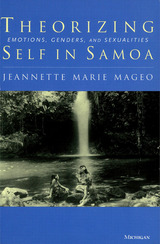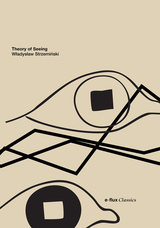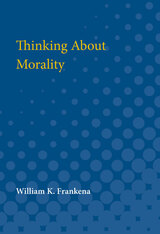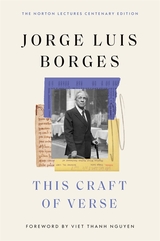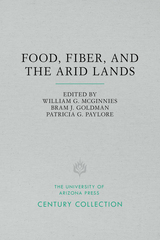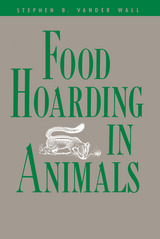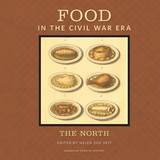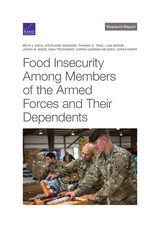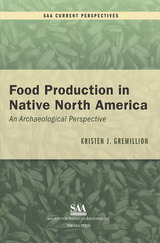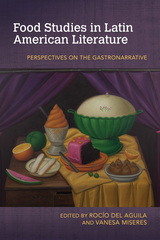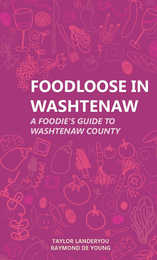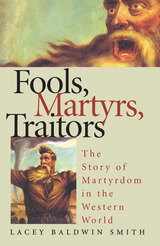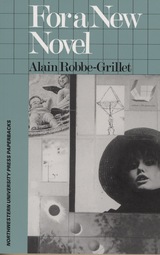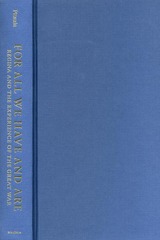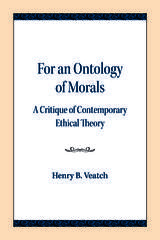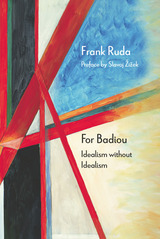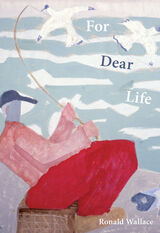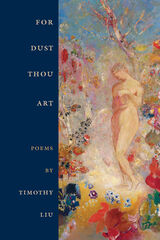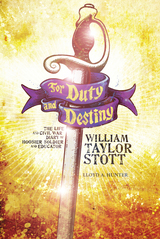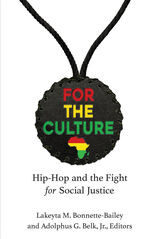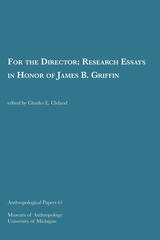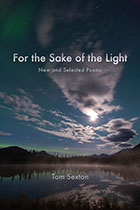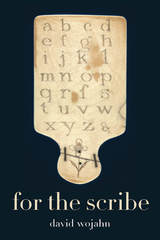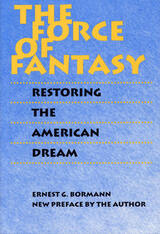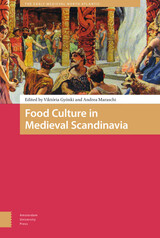 Food Culture in Medieval Scandinavia
Viktória Gyönki
Amsterdam University Press, 2022 The making, eating, and sharing of food throughout society represents an important and exciting area of study with the potential to advance the field of scholarship, particularly in the context of Scandinavian Studies. This book analyses the historical, legal, and literary sources of the region during the medieval period to explore different aspects of Scandinavian culture relating to food and drink: production, consumption (including feasts), trading (distribution), and the associated social rituals. Using new and innovative approaches, this collection of studies offers broad insights into a great variety of social practices and includes fresh information on not only social history but also traditional topics such as trade, commercial exchange, legal regulation, and political organisation. The book unites contributors from a variety of backgrounds, further enriching the content of a collection that promises to make a significant contribution to the state of current research.
 Food Democracy: Critical Lessons in Food, Communication, Design and Art
Oliver Vodeb
Intellect Books, 2017 In a world where privatization and capitalism dominate the global economy, the essays in this book ask how to make socially responsive communication, design, and art that counters the role of the food industry as a machine of consumption. Food Democracy brings together contributions from leading international scholars and activists, critical case studies of emancipatory food practices, and reflections on possible models for responsive communication, design, and art. A section of visual communication works, creative writings, and accounts of participatory art for social and environmental change, which were curated by the Memefest Festival of Socially Responsive Communication and Art on the theme of “Food Democracy,” are also included here. The beautifully designed book also includes a unique and delicious compilation of socially engaged recipes by the academic and activist community. Aiming not just to advance scholarship, but to push ahead real change in the world, Food Democracy is essential reading for scholars and citizens alike.
 Food Education and Rural Resilience in Japan: Nourishing National Identity
Stephanie Assmann
Amsterdam University Press, 2025 Food education initiatives exist worldwide, but Japan remains unique with its food education law known as shokuiku. The country’s impressive health metrics — high life expectancies, low obesity, and affordable health care — often lead observers to praise this approach. This book presents a more nuanced analysis. First, it challenges the assumption that food education is wholly a “good thing” by exposing underlying power mechanisms. Through food diagrams, food fairs, and school lunch programs, government ministries promote both nationalism and traditional gender roles. Second, it explores how food education operates in Japan’s rural regions, where educators champion resilience and food self-sufficiency to alleviate depopulation and economic decline. This emphasis on local food persisted even in the aftermath of the 2011 Fukushima nuclear disaster. Using Foucault’s concept of governmentality, historical contextualization, and extensive fieldwork in rural Japan, this study reveals the complex political agenda driving food education in a non-Western society.
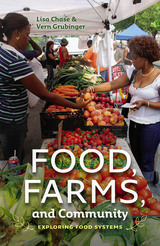 Food, Farms, and Community: Exploring Food Systems
Lisa Chase
University of New Hampshire Press, 2014 Throughout the United States, people are increasingly concerned about where their food comes from, how it is produced, and how its production affects individuals and their communities. The answers to these questions reveal a complex web of interactions. While large, distant farms and multinational companies dominate at national and global levels, innovative programs including farmers’ markets, farm-to-school initiatives, and agritourism are forging stronger connections between people and food at local and regional levels. At all levels of the food system, energy use, climate change, food safety, and the maintenance of farmland for the future are critical considerations. The need to understand food systems—what they are, who’s involved, and how they work (or don’t)—has never been greater.
Food, Farms, and Community: Exploring Food Systems takes an in-depth look at critical issues, successful programs, and challenges for improving food systems spanning a few miles to a few thousand miles. Case studies that delve into the values that drive farmers, food advocates, and food entrepreneurs are interwoven with analysis supported by the latest research. Examples of entrepreneurial farms and organizations working together to build sustainable food systems are relevant to the entire country—and reveal results that are about much more than fresh food.
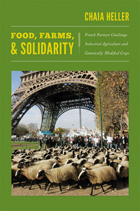 Food, Farms, and Solidarity: French Farmers Challenge Industrial Agriculture and Genetically Modified Crops
Chaia Heller
Duke University Press, 2012 The Confédération Paysanne, one of France's largest farmers' unions, has successfully fought against genetically modified organisms (GMOs), but unlike other allied movements, theirs has been led by producers rather than consumers. In Food, Farms, and Solidarity, Chaia Heller analyzes the group's complex strategies and campaigns, including a call for a Europe-wide ban on GM crops and hormone-treated beef, and a protest staged at a McDonald's. Her study of the Confédération Paysanne shows the challenges small farms face in a postindustrial agricultural world. Heller also reveals how the language the union uses to argue against GMOs encompasses more than the risks they pose; emphasizing solidarity has allowed farmers to focus on food as a cultural practice and align themselves with other workers. Heller's examination of the Confédération Paysanne's commitment to a vision of alter-globalization, the idea of substantive alternatives to neoliberal globalization, demonstrates how ecological and social justice can be restored in the world.
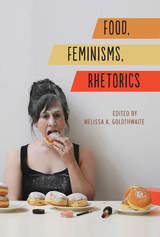 Food, Feminisms, Rhetorics
Edited by Melissa A. Goldthwaite
Southern Illinois University Press, 2017 Inspired by the need for interpretations and critiques of the varied messages surrounding what and how we eat, Food, Feminisms, Rhetorics collects eighteen essays that demonstrate the importance of food and food-related practices as sites of scholarly study, particularly from feminist rhetorical perspectives.
Contributors analyze messages about food and bodies—from what a person watches and reads to where that person shops—taken from sources mundane and literary, personal and cultural. This collection begins with analyses of the historical, cultural, and political implications of cookbooks and recipes; explores definitions of feminist food writing; and ends with a focus on bodies and cultures—both self-representations and representations of others for particular rhetorical purposes. The genres, objects, and practices contributors study are varied—from cookbooks to genre fiction, from blogs to food systems, from product packaging to paintings—but the overall message is the same: food and its associated practices are worthy of scholarly attention.
Food, Fiber, and the Arid Lands
Edited by William G. McGinnies, Bram J. Goldman, and Patricia G. Paylore
University of Arizona Press, 1971 From the Foreword:
The world’s dramatic awakening to the impact of ecology on the quality of human life, and a new awareness of the potential for exploitation of the desert environment—in which our particular interest lies—give rise to more thoughtful, even sober, attention to the problems faced by those aspiring only to bigger yields from crops and more protein from animals. To these very basic needs of food and fiber, we are, therefore, addressing ourselves further to a consideration of housing, educational programs, and nonagrarian resource evolution, to the end that the planners and the decision makers may have the benefit of the most intelligent and contemporary understanding possible of the cultural and social aspects of arid lands as well as the latest technological advances on a wide-ranging spectrum of scientific developments.
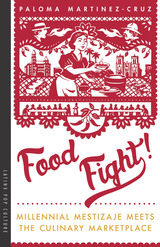 Food Fight!: Millennial Mestizaje Meets the Culinary Marketplace
Paloma Martinez-Cruz
University of Arizona Press, 2019 From the racial defamation and mocking tone of “Mexican” restaurants geared toward the Anglo customer to the high-end Latin-inspired eateries with Anglo chefs who give the impression that the food was something unattended or poorly handled that they “discovered” or “rescued” from actual Latinos, the dilemma of how to make ethical choices in food production and consumption is always as close as the kitchen recipe, coffee pot, or table grape.
In Food Fight! author Paloma Martinez-Cruz takes us on a Chicanx gastronomic journey that is powerful and humorous. Martinez-Cruz tackles head on the real-world politics of food production from the exploitation of farmworkers to the appropriation of Latinx bodies and culture, and takes us right into transformative eateries that offer a homegrown, mestiza consciousness.
The hard-hitting essays in Food Fight! bring a mestiza critique to today’s pressing discussions of labeling, identity, and imaging in marketing and dining. Not just about food, restaurants, and coffee, this volume employs a decolonial approach and engaging voice to interrogate ways that mestizo, Indigenous, and Latinx peoples are objectified in mainstream ideology and imaginary.
Food for Change: The Politics and Values of Social Movements
Jeff Pratt and Pete Luetchford
Pluto Press, 2013 Concern about our food system is growing, from the costs of industrial farming to the dominant role of supermarkets and recurring scandals about the origins and content of what we eat.
Food for Change documents the way alternative food movements respond to these concerns by trying to create more closed economic circuits within which people know where, how, and by whom their food is produced.
Jeff Pratt, Peter Luetchford and other contributors explore the key political and economic questions of food through the everyday experience and vivid insights of farmers and consumers, using fieldwork from case studies in four European countries (France, Spain, Italy and England). Food for Change is an insightful consideration of connections between food and wider economic relations and draws on a rich vein of anthropological writing on the topic.
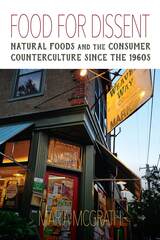 Food for Dissent: Natural Foods and the Consumer Counterculture since the 1960s
Maria McGrath
University of Massachusetts Press, 2019 In the 1960s and early 1970s, countercultural rebels decided that, rather than confront the system, they would create the world they wanted. The natural foods movement grew out of this contrarian spirit. Through a politics of principled shopping, eating, and entrepreneurship, food revolutionaries dissented from corporate capitalism and mainstream America.
In Food for Dissent, Maria McGrath traces the growth of the natural foods movement from its countercultural fringe beginning to its twenty-first-century "food revolution" ascendance, focusing on popular natural foods touchstones—vegetarian cookbooks, food co-ops, and health advocates. Guided by an ideology of ethical consumption, these institutions and actors spread the movement's oppositionality and transformed America's foodscape, at least for some. Yet this strategy proved an uncertain instrument for the advancement of social justice, environmental defense, and anti-corporatism. The case studies explored in Food for Dissent indicate the limits of using conscientious eating, shopping, and selling as tools for civic activism.
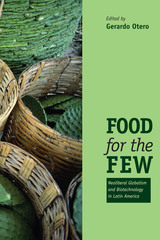 Food for the Few: Neoliberal Globalism and Biotechnology in Latin America
Edited by Gerardo Otero
University of Texas Press, 2008 Recent decades have seen tremendous changes in Latin America's agricultural sector, resulting from a broad program of liberalization instigated under pressure from the United States, the IMF, and the World Bank. Tariffs have been lifted, agricultural markets have been opened and privatized, land reform policies have been restricted or eliminated, and the perspective has shifted radically toward exportation rather than toward the goal of feeding local citizens. Examining the impact of these transformations, the contributors to Food for the Few: Neoliberal Globalism and Biotechnology in Latin America paint a somber portrait, describing local peasant farmers who have been made responsible for protecting impossibly vast areas of biodiversity, or are forced to specialize in one genetically modified crop, or who become low-wage workers within a capitalized farm complex. Using dozens of examples such as these, the deleterious consequences are surveyed from the perspectives of experts in diverse fields, including anthropology, economics, geography, political science, and sociology. From Kathy McAfee's "Exporting Crop Biotechnology: The Myth of Molecular Miracles," to Liz Fitting's "Importing Corn, Exporting Labor: The Neoliberal Corn Regime, GMOs, and the Erosion of Mexican Biodiversity," Food for the Few balances disturbing findings with hopeful assessments of emerging grassroots alternatives. Surveying not only the Latin American conditions that led to bankruptcy for countless farmers but also the North's practices, such as the heavy subsidies implemented to protect North American farmers, these essays represent a comprehensive, keenly informed response to a pivotal global crisis.
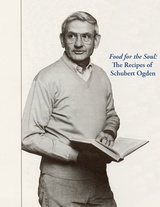 Food for the Soul: The Recipes of Schubert Ogden
Schubert Ogden
Bridwell Press, 2022 Schubert Miles Ogden (1928-2019) was one of America’s preeminent theologians during the last fifty years and spent a significant part of his career at Perkins School of Theology (SMU). During this time he engaged with a broad range of topics and concerns in his writings and teachings, producing an extensive theological body of work. What many in that academic world did not know was that Ogden was also a formidable man in the kitchen, constantly experimenting, testing, and coming up with a variety of recipes, from the distinctly delicious German-style baked goods like stollen to Schubert’s Own Salmon Loaf. He even had a signature cocktail called the Minister Margarita. In this present volume titled Food for the Soul: The Recipes of Schubert Ogden we have the second book published under the new Bridwell Press imprint that brings to life a lesser-known aspect of Ogden’s dynamic life and world. Instead of the adventures of the great scholar’s theological works, in this book we have an element of joyful surprise in his gastronomical oeuvre, and maybe there is something new and illuminating to discover in that as well. This compilation will certainly find a warm and inviting home among both theologians and non-theologians alike, especially if you like to experiment with the never-ending nuances of food.
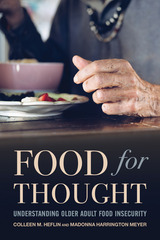 Food for Thought: Understanding Older Food Insecurity
Colleen M. Heflin
Russell Sage Foundation, 2025 While food insecurity among households with children often makes the headlines, a quieter issue that receives much less attention is the food insecurity faced by older adults. In 2023, over nine percent of Americans age sixty and older were food insecure. Without policy intervention, that number is only expected to grow as the U.S. population continues to age. In Food for Thought social policy scholar Colleen M. Heflin and sociologist Madonna Harrington Meyer illuminate the challenges faced by food insecure older adults.
Through analysis of national data sets and interviews with lower income older adults, Heflin and Harrington Meyer describe why many older adults do not have enough money to afford food and other essentials. As a result of chronic economic disadvantage, food insecure older adults are often forced to make budget trade-offs between food and other expenses. In these trade-offs, food typically ranks below housing and energy costs and competes with other household bills, such as medical costs, transportation, and phone and internet coverage. While finances play a large role, nonfinancial factors, such as poor physical, cognitive, and mental health, access to healthy food, and transportation challenges, also contribute to food insecurity in old age. In the face of these difficulties, food insecure older adults may go hungry, skip meals, or eat unhealthy foods to help make ends meet.
While SNAP and community-based programs, such as food pantries and home delivered meals, are intended to help address the issue of food insecurity, they are typically inadequate to address the needs of food insecure older adults. SNAP has enrollment and maintenance procedures that are particularly difficult for older adults to navigate, pays out an insufficient amount of money to cover food costs, and varies greatly by state. Availability of community programs varies by municipality, often lacks nutritious foods that are complementary to health conditions common among older adults, and can be difficult to access due to a lack of reliable transportation, disability, or cost. Heflin and Harrington Meyer advocate for addressing all the issues that increase older adults’ risk of food insecurity, not just financial barriers. They suggest updating food insecurity screening tools to include these factors, increasing SNAP benefits and income support for older adults, and other policies to help combat food insecurity in older adults.
Food for Thought highlights the increasingly important issue of food insecurity in old age and lays bare the overlooked challenges faced by food insecure older adults.
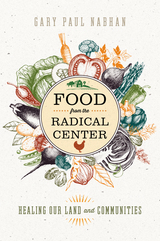 Food from the Radical Center: Healing Our Land and Communities
Gary Paul Nabhan
Island Press, 2018 "Informational and inspirational." —Booklist
America has never felt more divided. But in the midst of all the acrimony comes one of the most promising movements in our country’s history. People of all races, faiths, and political persuasions are coming together to restore America's natural wealth: its ability to produce healthy foods.
In Food from the Radical Center, Gary Nabhan tells the stories of diverse communities who are getting their hands dirty and bringing back North America's unique fare: bison, sturgeon, camas lilies, ancient grains, turkeys, and more. These efforts have united people from the left and right, rural and urban, faith-based and science-based, in game-changing collaborations. Their successes are extraordinary by any measure, whether economic, ecological, or social. In fact, the restoration of land and rare species has provided—dollar for dollar—one of the best returns on investment of any conservation initiative.
As a leading thinker and seasoned practitioner in biocultural conservation, Nabhan offers a truly unique perspective on the movement. He draws on fifty years of work with community-based projects around the nation, from the desert Southwest to the low country of the Southeast. Yet Nabhan’s most enduring legacy may be his message of hope: a vision of a new environmentalism that is just and inclusive, allowing former adversaries to commune over delicious foods.
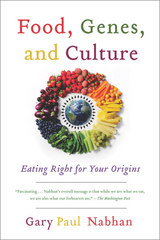 Food, Genes, and Culture: Eating Right for Your Origins
Gary Paul Nabhan
Island Press, 2014 Vegan, low fat, low carb, slow carb: Every diet seems to promise a one-size-fits-all solution to health. But they ignore the diversity of human genes and how they interact with what we eat. In Food, Genes, and Culture, renowned ethnobotanist Gary Nabhan shows why the perfect diet for one person could be disastrous for another. If your ancestors were herders in Northern Europe, milk might well provide you with important nutrients, whereas if you’re Native American, you have a higher likelihood of lactose intolerance. If your roots lie in the Greek islands, the acclaimed Mediterranean diet might save your heart; if not, all that olive oil could just give you stomach cramps. Nabhan traces food traditions around the world, from Bali to Mexico, uncovering the links between ancestry and individual responses to food. The implications go well beyond personal taste. Today’s widespread mismatch between diet and genes is leading to serious health conditions, including a dramatic growth over the last 50 years in auto-immune and inflammatory diseases. Readers will not only learn why diabetes is running rampant among indigenous peoples and heart disease has risen among those of northern European descent, but may find the path to their own perfect diet.
 Food, Heresies, and Magical Boundaries in the Middle Ages
Andrea Maraschi
Amsterdam University Press, 2024 In this book readers will find stories about medieval heresies and “magic” from an unusual perspective: that of food studies. The time span ranges from Late Antiquity to the Late Middle Ages, while the geographical scope includes regions as different as North Africa, Spain, Ireland, continental Europe, the Holy land, and Central Asia. Food, heresies, and magical boundaries in the Middle Ages explores the power of food in creating and breaking down boundaries between different groups, or in establishing a contact with other worlds, be they the occult sides of nature, or the supernatural. The book emphasizes the role of food in crafting and carrying identity, and in transferring virtues and powers of natural elements into the eater’s body. Which foods and drinks made someone a heretic? Could they be purified? Which food offerings forged a connection with the otherworld? Which recipes allowed gaining access to the hidden powers within nature?
Food Hoarding in Animals
Stephen B. Vander Wall
University of Chicago Press, 1990 In this first comprehensive synthesis of the literature on food hoarding in animals, Stephen B. Vander Wall discusses how animals store food, how they use food and how this use affects individual fitness, why and how food hoarding evolved, how cached food is lost, mechanisms for protecting and recovering cached food, physiological and behavioral factors that influence hoarding, and the impact that hoarding animals have on plant populations and plant dispersal. He then provides detailed coverage of hoarding behavior across taxa—mammals, birds, and arthropods—to address issues in evolution, ecology, and behavior.
Drawings, photographs, and appendixes document complex and intrinsically interesting food-hoarding behaviors, and the bibliography of nearly 1,500 sources is itself an invaluable and unique reference.
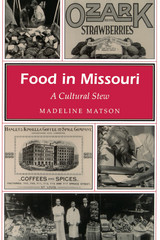 Food in Missouri: A Cultural Stew
Madeline Matson
University of Missouri Press, 1994 Corn, squash, and beans from the Native Americans; barbecue sauces from the Spanish; potatoes and sausages from the Germans: Missouri's foods include a bountiful variety of ingredients. In Food in Missouri: A Cultural Stew, Madeline Matson takes readers on an enticing journey through the history of this state's food, from the hunting and farming methods of the area's earliest inhabitants, through the contributions of the state's substantial African American population, to the fast-food purveyors of the microwave age. Tracing the history of food preparation, preservation, and marketing, while highlighting the cultural traditions that engendered each change, Matson shows how advances in farming methods, the invention of the electric range, the development of cookbooks, and three waves of immigration have profoundly influenced what Missourians eat today. Along the way, she highlights some of the key people, places, and institutions in Missouri's food history: Irma S. Rombauer, author of Joy of Cooking; Stark Bro's Nurseries and Orchards in Louisiana, Missouri, the largest family-owned fruit-tree nursery in the world and the home of Delicious, Golden Delicious, and Gala apples; St. Louis's Soulard Market, established in 1779 and said to be the oldest public market west of the Mississippi; and Stone Hill Winery, a leader in Hermann's nationally recognized wine- making industry. By bringing to life the traditions behind the foods we eat every day, Food in Missouri provides a unique perspective on the people who explored and settled the state, showing that Missouri's rich heritage truly is a cultural stew.
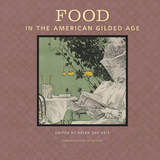 Food in the American Gilded Age
Helen Zoe Veit
Michigan State University Press, 2017 Food was incredibly diverse in post–Civil War America. It was an era of gross income inequality, and differences in diet reflected the deep disparities between upper and lower classes, as well as the expansion of a flourishing middle class. In this book, excerpts from a wide range of Gilded Age sources—from period cookbooks to advice manuals to dietary studies—reveal how jarringly eating and cooking differed between classes and regions at a time when technology and industrialization were transforming what and how people ate. Most of all, they show how strongly the fabled glitz of wealthy Americans in the Gilded Age contrasted with the lives of most Americans. Featuring a variety of sources as well as accessible essays putting those sources into context, this book provides a remarkable portrait of food in a singular era in American history, giving a glimpse into the kinds of meals eaten everywhere from high society banquets to the meanest tenements and sharecropping cabins.
Food in the Civil War Era: The North
Helen Zoe Veit
Michigan State University Press, 2014 Cookbooks offer a unique and valuable way to examine American life. Their lessons, however, are not always obvious. Direct references to the American Civil War were rare in cookbooks, even in those published right in the middle of it. In part, this is a reminder that lives went on and that dinner still appeared on most tables most nights, no matter how much the world was changing outside. But people accustomed to thinking of cookbooks as a source for recipes, and not much else, can be surprised by how much information they can reveal about the daily lives and ways of thinking of the people who wrote and used them. In this fascinating historical compilation, excerpts from five Civil War–era cookbooks present a compelling portrait of cooking and eating in the urban north of the 1860s United States.
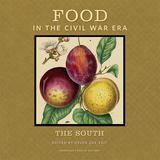 Food in the Civil War Era: The South
Helen Zoe Veit
Michigan State University Press, 2015 Almost immediately, the Civil War transformed the way Southerners ate, devastating fields and food transportation networks. The war also spurred Southerners to canonize prewar cooking styles, resulting in cuisine that retained nineteenth-century techniques in a way other American cuisines did not. This fascinating book presents a variety of Civil War-era recipes from the South, accompanied by eye-opening essays describing this tumultuous period in the way people lived and ate. The cookbooks excerpted here teem with the kinds of recipes we expect to find when we go looking for Southern food: grits and gumbo, succotash and Hopping John, catfish, coleslaw, watermelon pickles, and sweet potato pie. The cookbooks also offer plenty of surprises. This volume, the second in the American Food in History series, sheds new light on cooking and eating in the Civil War South, pointing out how seemingly neutral recipes can reveal unexpected things about life beyond the dinner plate, from responses to the anti-slavery movement to shifting economic imperatives to changing ideas about women’s roles. Together, these recipes and essays provide a unique portrait of Southern life via the flavors, textures, and techniques that grew out of a time of crisis.
Food Insecurity Among Members of the Armed Forces and Their Dependents
Beth J. Asch
RAND Corporation, 2023 The National Defense Authorization Act for fiscal year 2020 directed the Secretary of Defense to report on food insecurity among members of the armed forces and their dependents. RAND researchers examined the eight elements from the directive (including an assessment of the current extent of food insecurity among service members and their dependents) and developed answers, along with listing areas requiring additional analysis.
 Food Instagram: Identity, Influence, and Negotiation
Edited by Emily J. H. Contois and Zenia Kish
University of Illinois Press, 2022 Winner of the 2023 Association for the Study of Food and Society Book Prize for Edited Volume Image by image and hashtag by hashtag, Instagram has redefined the ways we relate to food. Emily J. H. Contois and Zenia Kish edit contributions that explore the massively popular social media platform as a space for self-identification, influence, transformation, and resistance. Artists and journalists join a wide range of scholars to look at food’s connection to Instagram from vantage points as diverse as Hong Kong’s camera-centric foodie culture, the platform’s long history with feminist eateries, and the photography of Australia’s livestock producers. What emerges is a portrait of an arena where people do more than build identities and influence. Users negotiate cultural, social, and economic practices in a place that, for all its democratic potential, reinforces entrenched dynamics of power. Interdisciplinary in approach and transnational in scope, Food Instagram offers general readers and experts alike new perspectives on an important social media space and its impact on a fundamental area of our lives. Contributors: Laurence Allard, Joceline Andersen, Emily Buddle, Robin Caldwell, Emily J. H. Contois, Sarah E. Cramer, Gaby David, Deborah A. Harris, KC Hysmith, Alex Ketchum, Katherine Kirkwood, Zenia Kish, Stinne Gunder Strøm Krogager, Jonathan Leer, Yue-Chiu Bonni Leung, Yi-Chieh Jessica Lin, Michael Z. Newman, Tsugumi Okabe, Rachel Phillips, Sarah Garcia Santamaria, Tara J. Schuwerk, Sarah E. Tracy, Emily Truman, Dawn Woolley, and Zara Worth
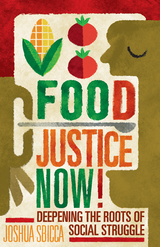 Food Justice Now!: Deepening the Roots of Social Struggle
Joshua Sbicca
University of Minnesota Press, 2018 A rallying cry to link the food justice movement to broader social justice debates
The United States is a nation of foodies and food activists, many of them progressives, and yet their overwhelming concern for what they consume often hinders their engagement with social justice more broadly. Food Justice Now! charts a path from food activism to social justice activism that integrates the two. It calls on the food-focused to broaden and deepen their commitment to the struggle against structural inequalities both within and beyond the food system.
In an engrossing, historically grounded, and ethnographically rich narrative, Joshua Sbicca argues that food justice is more than just a myopic focus on food, allowing scholars and activists alike to investigate the causes behind inequities and evaluate and implement political strategies to overcome them. Focusing on carceral, labor, and immigration crises, Sbicca tells the stories of three California-based food movement organizations, showing that when activists use food to confront neoliberal capitalism and institutional racism, they can creatively expand how to practice and achieve food justice. Sbicca sets his central argument in opposition to apolitical and individual solutions, discussing national food movement campaigns and the need for economically and racially just food policies—a matter of vital public concern with deep implications for building collective power across a diversity of interests.
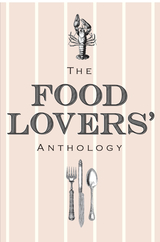 The Food Lovers' Anthology: A Literary Compendium
Edited by the Bodleian Library
Bodleian Library Publishing, 2014 “Show me another pleasure like dinner which comes every day and lasts an hour.”—Talleyrand
“He was a bold man that first ate an oyster.”—Jonathan Swift
“There is no love sincerer than the love of food,” wrote George Bernard Shaw in 1903. Poets, novelists, chefs, and gourmands before and after him would seem to agree. Collected in this anthology is a mouthwatering selection of excerpts on the subject of eating, drinking, cooking, and serving food that is guaranteed to whet every reader’s appetite.
Themed sections group together poetry and prose on grapes and bottles, the ideal cuisine, hangover cures, and vivid vignettes about dinner party behavior. There are stories about food fit for kings, a duchess’s “rumblings abdominal,” fine dining, eating abroad, cooking at home, and gastronomic excesses. A section on food and travel features Edmund Hillary’s meal at the summit of Everest, Ernest Shackleton’s dish of penguin in the Antarctic, and Joshua Slocum on the unfortunate effects of cheese and plums while sailing solo around the world. Also on the menu are limericks, short-tempered cooks, recipes, fantasy food, special feasts, iron rations, tips on opening oysters, and the uses and abuses of coffee.
Featuring writers as diverse as Jean Anthelme Brillat-Savarin, Edward Lear, John Keats, Charles Dickens, Maria Edgeworth, and Marcel Proust, garnished with a generous helping of cartoons, this is a perfect gift for foodies, chefs, picnickers, and epicurean explorers.
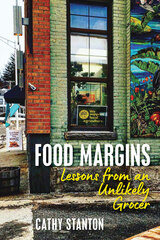 Food Margins: Lessons from an Unlikely Grocer
Cathy Stanton
University of Massachusetts Press, 2024 Winner of the 2025 New England Society Book Award for Specialty Titles
Winner of the 2024 Readable Feast Award for Social Consciousness
Named one of Food Tank's 20 Food Systems Reads that Will Inspire You this Summer
In a food industry shaped by the abundance, cheapness, and convenience that giant corporations can offer, small-scale ventures struggle to survive, as anthropologist Cathy Stanton discovered when she joined the effort to save a small food co-op in a former mill town in western Massachusetts. On the margins of the dominant system, Stanton found herself reckoning with its deep racial and class inequities, and learning that making real change requires a fierce commitment to community and a willingness to change herself as well.
Part memoir and part history lesson, Food Margins traces the tangled economic and political histories of the plantation, the factory, and the supermarket through the life of one New England town. Stanton tells a complex and compelling story of a rural community imagining and creating a viable alternative to the mainstream in a time of increasingly urgent need to build a more socially and ecologically just food system.
 Food Margins: Lessons from an Unlikely Grocer
Cathy Stanton
University of Massachusetts Press, 2024 Winner of the 2025 New England Society Book Award for Specialty Titles
Winner of the 2024 Readable Feast Award for Social Consciousness
Named one of Food Tank's 20 Food Systems Reads that Will Inspire You this Summer
In a food industry shaped by the abundance, cheapness, and convenience that giant corporations can offer, small-scale ventures struggle to survive, as anthropologist Cathy Stanton discovered when she joined the effort to save a small food co-op in a former mill town in western Massachusetts. On the margins of the dominant system, Stanton found herself reckoning with its deep racial and class inequities, and learning that making real change requires a fierce commitment to community and a willingness to change herself as well.
Part memoir and part history lesson, Food Margins traces the tangled economic and political histories of the plantation, the factory, and the supermarket through the life of one New England town. Stanton tells a complex and compelling story of a rural community imagining and creating a viable alternative to the mainstream in a time of increasingly urgent need to build a more socially and ecologically just food system.
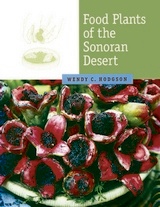 Food Plants of the Sonoran Desert
Wendy C. Hodgson
University of Arizona Press, 2001 The seemingly inhospitable Sonoran Desert has provided sustenance to indigenous peoples for centuries. Although it is to all appearances a land bereft of useful plants, fully one-fifth of the desert's flora are edible. This volume presents information on nearly 540 edible plants used by people of more than fifty traditional cultures of the Sonoran Desert and peripheral areas. Drawing on thirty years of research, Wendy Hodgson has synthesized the widely scattered literature and added her own experiences to create an exhaustive catalog of desert plants and their many and varied uses. Food Plants of the Sonoran Desert includes not only plants such as gourds and legumes but also unexpected food sources such as palms, lilies, and cattails, all of which provided nutrition to desert peoples. Each species entry lists recorded names and describes indigenous uses, which often include nonfood therapeutic and commodity applications. The agave, for example, is cited for its use as food and for alcoholic and nonalcoholic beverages, syrup, fiber, cordage, clothing, sandals, nets, blankets, lances, fire hearths, musical instruments, hedgerows, soap, and medicine, and for ceremonial purposes. The agave entry includes information on harvesting, roasting, and consumption—and on distinguishing between edible and inedible varieties. No other source provides such a vast amount of information on traditional plant uses for this region. Written to be easily accessible to general readers, the book is an invaluable compendium for anyone interested in the desert's hidden bounty.
Food Production in Native North America: An Archaeological Perspective
Kristen J. Gremillion
University Press of Colorado, 2018 This book in the SAA Press Current Perspectives Series provides a broad overview of the development of agriculture and other forms of resource management by the Native peoples of North America. Its geographical scope includes most of the continent’s temperate zone, but regions where agriculture took hold are emphasized. Temporally, this volume looks back as far as the first indigenous domesticates that emerged in the midcontinental region and follows the story into the era of European conquest.
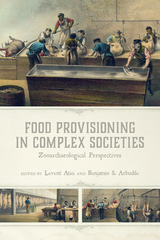 Food Provisioning in Complex Societies: Zooarchaeological Perspectives
Levent Atici
University Press of Colorado, 2022 Through creative combinations of ethnohistoric evidence, iconography, and contextual analysis of faunal remains, this work offers new insight into the mechanisms involved in food provisioning for complex societies. Contributors combine zooarchaeological and historical data from global case studies to analyze patterns in centralization and bureaucratic control, asymmetrical access and inequalities, and production-distribution-consumption dynamics of urban food provisioning and animal management.
Taking a global perspective and including both prehistoric and historic case studies, the chapters in the volume reflect some of the current best practices in the zooarchaeology of complex societies. Embedding faunal evidence within a broader anthropological explanatory framework and integrating archaeological contexts, historic texts, iconography, and ethnohistorical sources, the book discerns myriad ways that animals are key contributors to, and cocreators of, complex societies in all periods and all places. Chapters cover the diverse sociopolitical and economic roles wild animals played in Bronze Age Turkey; the production and consumption of animal products in medieval Ireland; the importance of belief systems, politics, and cosmologies in Shang Dynasty animal provisioning in the Yellow River Valley; the significance of external trade routes in the kingdom of Aksum (modern Sudan); hunting and animal husbandry at El Zotz; animal economies from two Mississippian period sites; and more.
Food Provisioning in Complex Societies provides an optimistic roadmap and heuristic tools to explore the diverse, resilient, and contingent processes involved in food provisioning. The book represents a novel and productive way forward for understanding the unique, yet predictably structured, provisioning systems that emerged in the context of complex societies in all parts of the world. It will be of interest to zooarchaeologists and archaeologists alike.
Contributors: Joaquin Arroyo-Cabrales, Fiona Beglane, Roderick Campbell, Kathryn Grossman, Patricia Martinez-Lira, Jacqueline S. Meier, Sarah E. Newman, Terry O'Connor, Tanya M. Peres, Gypsy C. Price, Elizabeth J. Reitz, Kim Shelton, Marcus Winter, Helina S. Woldekiros
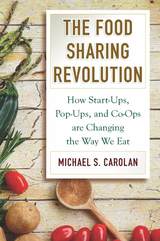 The Food Sharing Revolution: How Start-Ups, Pop-Ups, and Co-Ops are Changing the Way We Eat
Michael S. Carolan
Island Press, 2018 Marvin is a contract hog farmer in Iowa. He owns his land, his barn, his tractor, and his animal crates. He has seen profits drop steadily for the last twenty years and feels trapped. Josh is a dairy farmer on a cooperative in Massachusetts. He doesn’t own his cows, his land, his seed, or even all of his equipment. Josh has a healthy income and feels like he’s made it.
In The Food Sharing Revolution, Michael Carolan tells the stories of traditional producers like Marvin, who are being squeezed by big agribusiness, and entrepreneurs like Josh, who are bucking the corporate food system. The difference is Josh has eschewed the burdens of individual ownership and is tapping into the sharing economy.
Josh and many others are sharing tractors, seeds, kitchen space, their homes, and their cultures. They are business owners like Dorothy, who opened her bakery with the help of a no-interest, crowd-sourced loan. They are chefs like Camilla, who introduces diners to her native Colombian cuisine through peer-to-peer meal sharing. Their success is not only good for aspiring producers, but for everyone who wants an alternative to monocrops and processed foods.
The key to successful sharing, Carolan shows, is actually sharing. He warns that food, just like taxis or hotels, can be co-opted by moneyed interests. But when collaboration is genuine, the sharing economy can offer both producers and eaters freedom, even sovereignty. The result is a healthier, more sustainable, and more ethical way to eat.
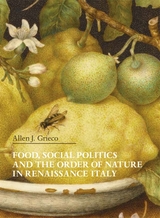 Food, Social Politics and the Order of Nature in Renaissance Italy
Allen J. Grieco
Harvard University Press The act of eating is a basic human need. Yet in all societies, quotidian choices regarding food and its consumption reveal deeply rooted shared cultural conventions. Food goes beyond issues relating to biological needs and nutrition or production and commerce; it also reveals social and cultural criteria that determine what dishes are prepared on what occasions, and it unveils the politics of the table via the rituals associated with different meals. This book approaches the history of food in Late Medieval and Renaissance Italy through an interdisciplinary prism of sources ranging from correspondence, literature (both high and low), and medical and dietary treatises to cosmographic theory and iconographic evidence. Using a variety of analytical methods and theoretical approaches, it moves food studies firmly into the arena of Late Medieval and Renaissance history, providing an essential key to deciphering the material and metaphorical complexity of this period in European, and especially Italian, history.
 Food Storage in Michigan's Late Woodland: The Work of Indigenous Women
Kathryn M. Frederick
University of Alabama Press, 2026 Incorporates experimental archaeology to understand the food-caching strategies led by Indigenous women in Late Woodland Michigan. This experimental archaeology book centers on the decision of Indigenous women in Michigan’s Late Woodland to store food in cache pits for later use, to ensure a stable food supply. These food storage techniques were efforts to increase communal chances of survival in direct responses to sociopolitical changes. Kathryn M. Frederick highlights the importance of food storage in these communities and the decision-making and behaviors behind it. To discover why food storage became a popular practice at that period, Frederick considered the efficacy of subterranean food storage and constructed experiments to understand the timing and use of cache pits and to test their reliability and efficiency. She also compiled ethnographic data on location, environmental conditions, movement strategies, and types of foodstuffs stored for dozens of hunter-gatherer groups. Two distinct patterns of food storage emerged: “reliant” and “redundant.” Frederick argues that the Indigenous women utilized a system of reliant storage during times of abundance but could switch to a redundant system as the socioeconomic climate shifted. This book will interest a wide swath of archaeologists and others interested in Indigenous foodways and women’s key roles.
Food Studies in Latin American Literature: Perspectives on the Gastronarrative
Rocío del Aguila
University of Arkansas Press, 2021 Food Studies in Latin American Literature presents a timely collection of essays analyzing a wide array of Latin American narratives through the lens of food studies. Topics explored include potato and maize in colonial and contemporary global narratives; the role of cooking in Sor Juana Inés de la Cruz’s poetics; the centrality of desire in twentieth-century cooking writing by women; the relationship among food, recipes, and national identity; the role of food in travel narratives; and the impact of advertisements on domestic roles. The contributors included here—experts in Latin American history, literature, and cultural studies—bring a novel, interdisciplinary approach to these explorations, presenting new perspectives on Latin American literature and culture.
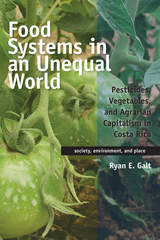 Food Systems in an Unequal World: Pesticides, Vegetables, and Agrarian Capitalism in Costa Rica
Ryan E. Galt
University of Arizona Press, 2014 Pesticides, a short-term aid for farmers, can often be harmful, undermining the long-term health of agriculture, ecosystems, and people. The United States and other industrialized countries import food from Costa Rica and other regions. To safeguard the public health, importers now regulate the level and types of pesticides used in the exporters’ food production, which creates “regulatory risk” for the export farmers. Although farmers respond to export regulations by trying to avoid illegal pesticide residues, the food produced for their domestic market lacks similar regulation, creating a double standard of pesticide use.
Food Systems in an Unequal World examines the agrochemical-dependent agriculture of Costa Rica and how its uneven regulation in export versus domestic markets affects Costa Rican vegetable farmers. Examining pesticide-dependent vegetable production within two food systems, the author shows that pesticide use is shaped by three main forces: agrarian capitalism, the governance of food systems throughout the commodity chain, and ecological dynamics driving local food production. Those processes produce unequal outcomes that disadvantage less powerful producers who have more limited choices than larger farmers, who usually have access to better growing environments and thereby can reduce pesticide use and production costs.
Despite the rise of alternative food networks, Galt says, persistent problems remain in the conventional food system, including widespread and intensive pesticide use. Facing domestic price squeezes, vegetable farmers in Costa Rica are more likely to supply the national market with produce containing residues of highly toxic pesticides, while using less toxic pesticides on exported vegetables. In seeking solutions, Galt argues for improved governance and research into alternative pest control but emphasizes that the process must be rooted in farmers’ economic well-being.
 Food, Texts, and Cultures in Latin America and Spain
Rafael Climent-Espino
Vanderbilt University Press, 2020 The fourteen essays in Food, Texts, and Cultures in Latin America and Spain showcase the eye-opening potential of a food lens within colonial studies, ethnic and racial studies, gender and sexuality studies, and studies of power dynamics, nationalisms and nation building, theories of embodiment, and identity. In short, Food, Texts, and Cultures in Latin America and Spain grapples with an emerging field in need of a foundational text, and does so from multiple angles. The studies span from the Middle Ages to the twenty-first century, and the contributing scholars occupy diverse fields within Latin American and Hispanic Studies. As such, their essays showcase eclectic critical and theoretical approaches to the subject of Latin American and Iberian food. Food, Texts, and Cultures in Latin America and Spain also introduces the first English-language publication of works from such award-winning scholars as Adolfo Castañón of the Mexican Academy of Language; Sergio Ramírez, winner of the 2017 Miguel de Cervantes Prize in Literature; and Carmen Simón Palmer, winner of the 2015 Julián Marías Prize for Research.
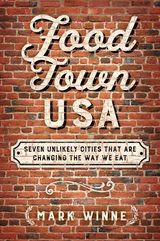 Food Town, USA: Seven Unlikely Cities That are Changing the Way We Eat
Mark Winne
Island Press, 2019 Look at any list of America’s top foodie cities and you probably won’t find Boise, Idaho or Sitka, Alaska. Yet they are the new face of the food movement. Healthy, sustainable fare is changing communities across this country, revitalizing towns that have been ravaged by disappearing industries and decades of inequity.
What sparked this revolution? To find out, Mark Winne traveled to seven cities not usually considered revolutionary. He broke bread with brew masters and city council members, farmers and philanthropists, toured start-up incubators and homeless shelters. What he discovered was remarkable, even inspiring.
In Bethlehem, Pennsylvania, once a company steel town, investment in the arts has created a robust new market for local restaurateurs. In Alexandria, Louisiana, “one-stop shopping” food banks help clients apply for health insurance along with SNAP benefits. In Jacksonville, Florida, aeroponics are bringing fresh produce to a food desert.
Over the course of his travels, Winne experienced the power of individuals to transform food and the power of food to transform communities. The cities of Food Town, USA remind us that innovation is ripening all across the country, especially in the most unlikely places.
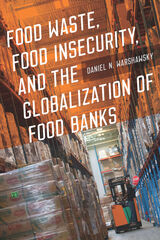 Food Waste, Food Insecurity, and the Globalization of Food Banks
Daniel N. Warshawsky
University of Iowa Press, 2023 Food banks—warehouses that collect and systematize surplus food—have expanded into one of the largest mechanisms to redistribute food waste. From their origins in North America in the 1960s, food banks provide food to communities in approximately one hundred countries on six continents. This book analyzes the development of food banks across the world and the limits of food charity as a means to reduce food insecurity and food waste.
Based on fifteen years of in-depth fieldwork on four continents, Daniel Warshawsky illustrates how and why food banks proliferate across the globe even though their impacts may be limited. He suggests that we need to reformulate the role of food banks. The mission of food banks needs to be more realistic, as food surpluses cannot reduce food insecurity on a significant scale. Food banks need to regain their institutional independence from the state and corporations, and incorporate the knowledge and experiences of the food insecure in the daily operations of the food system. These collective changes can contribute to a future where food banks play a smaller but more targeted role in food systems.
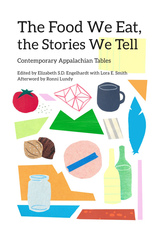 The Food We Eat, the Stories We Tell: Contemporary Appalachian Tables
Elizabeth S. D. Engelhardt
Ohio University Press, 2019 Blue Ridge tacos, kimchi with soup beans and cornbread, family stories hiding in cookbook marginalia, African American mountain gardens—this wide-ranging anthology considers all these and more. Diverse contributors show us that contemporary Appalachian tables and the stories they hold offer new ways into understanding past, present, and future American food practices. The poets, scholars, fiction writers, journalists, and food professionals in these pages show us that what we eat gives a beautifully full picture of Appalachia, where it’s been, and where it’s going. Contributors: Courtney Balestier, Jessie Blackburn, Karida L. Brown, Danille Elise Christensen, Annette Saunooke Clapsaddle, Michael Croley, Elizabeth S. D. Engelhardt, Robert Gipe, Suronda Gonzalez, Emily Hilliard, Rebecca Gayle Howell, Abigail Huggins, Erica Abrams Locklear, Ronni Lundy, George Ella Lyon, Jeff Mann, Daniel S. Margolies, William Schumann, Lora E. Smith, Emily Wallace, Crystal Wilkinson
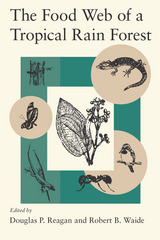 The Food Web of a Tropical Rain Forest
Edited by Douglas P. Reagan and Robert B. Waide
University of Chicago Press, 1996 Destruction of tropical rain forests has increased exponentially in recent years, as have efforts to conserve them. However, information essential to these conservation programs—an understanding of the population dynamics of the community at risk—is often unavailable to the scientists and resource managers who need it most.
This volume helps fill the gap by presenting a comprehensive description and analysis of the animal community of the tropical rain forest at El Verde, Puerto Rico. Building on more than a decade of field research, the contributors weave the complex strands of information about the energy flow within the forest—who eats whom—into a powerful tool for understanding community dynamics known as a food web. This systematic approach to organizing the natural histories of the many species at El Verde also reveals basic patterns and processes common to all rain forests, making this book a valuable contribution for anyone concerned with studying and protecting these fragile ecosystems.
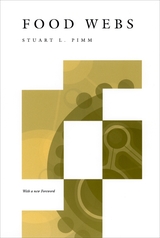 Food Webs
Stuart L. Pimm
University of Chicago Press, 2002 Food webs are diagrams depicting which species interact or in other words, who eats whom. An understanding of the structure and function of food webs is crucial for any study of how an ecosystem works, including attempts to predict which communities might be more vulnerable to disturbance and therefore in more immediate need of conservation.
Although it was first published twenty years ago, Stuart Pimm's Food Webs remains the clearest introduction to the study of food webs. Reviewing various hypotheses in the light of theoretical and empirical evidence, Pimm shows that even the most complex food webs follow certain patterns and that those patterns are shaped by a limited number of biological processes, such as population dynamics and energy flow. Pimm provides a variety of mathematical tools for unravelling these patterns and processes, and demonstrates their application through concrete examples. For this edition, he has written a new foreword covering recent developments in the study of food webs and demonstrates their continuing importance to conservation biology.
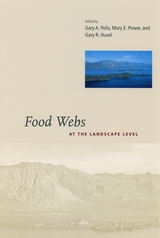 Food Webs at the Landscape Level
Edited by Gary A. Polis, Mary E. Power, and Gary R. Huxel
University of Chicago Press, 2004 Scientists rely on food webs—complex networks that trace the flow of nutrients and energy between species and through ecosystems—to understand the infrastructure of ecological communities.
But given the complexities of food webs—think of following the flow of nutrients through the microbes, fungi, roots, worms, ants, and birds that pass over or through a single cubic meter of prairie soil—it's not difficult to see why most experiments on food-web dynamics focus on small, local habitats. Yet as this book convincingly shows, important insights come when scientists expand the temporal and spatial scope of their research to look at the ways energy, organisms, nutrients, and pollutants flow not just at the local level, but across whole landscapes—between and among food webs in a wide variety of habitats.
Paying special attention to the fertile boundaries between terrestrial, freshwater, and marine ecosystems, Food Webs at the Landscape Level not only shows what this new methodology means for ecology, conservation, and agriculture but also serves as a fitting tribute to Gary Polis and his major contributions to the field.
Foodloose in Washtenaw: A Foodie's Guide to Washtenaw County
Taylor Landeryou and Raymond De Young
Michigan Publishing, 2018 Inspired by a classic walking guidebook of the area, Foodloose in Washtenaw County takes readers on tours to discover food-related treasures throughout the county. What better way to get to know this place—or experience something new—than to bike, bus, carpool, walk, even kayak your way through food-filled Washtenaw County? From centennial farms to trendy upscale restaurants, the self-guided tours of Foodloose offer an opportunity to explore where our food is grown, produced, distributed, and enjoyed in Washtenaw County. Within these pages lies a chance to celebrate the local food community, learn more about our unique food system, and maybe even find a new favorite place to dine.
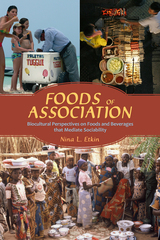 Foods of Association: Biocultural Perspectives on Foods and Beverages that Mediate Sociability
Nina L. Etkin
University of Arizona Press, 2009 “We should look for someone to eat and drink with before looking for something to eat and drink.”—Epicurus
This fascinating book examines the biology and culture of foods and beverages that are consumed in communal settings, with special attention to their health implications. Nina Etkin covers a wealth of topics, exploring human evolutionary history, the Slow Food movement, ritual and ceremonial foods, caffeinated beverages, spices, the street foods of Hawaii and northern Nigeria, and even bottled water. Her work is framed by a biocultural perspective that considers both the physiological implications of consumption and the cultural construction and circulation of foods. For Etkin, the foods and beverages we consume are simultaneously “biodynamic substances and cultural objects.”
The book begins with a look at the social eating habits of our primate relatives and discusses our evolutionary adaptations. It then offers a history of social foods in the era of European expansion, with a focus on spices and “caffeinated cordials.” (Of course, there were some powerful physiological consequences of eating foods brought home by returning explorers, and those are considered too—along with consequences for native peoples.) From there, the book describes “street food,” which is always served in communal settings. Etkin then scrutinizes ceremonial foods and beverages, and considers their pharmacological effects as well. Her extensive examination concludes by assessing the biological and cultural implications of bottled water.
While intended primarily for scholars, this enticing book serves up a tantalizing smorgasbord of food for thought.
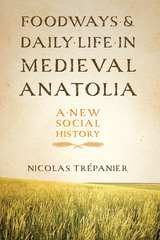 Foodways and Daily Life in Medieval Anatolia: A New Social History
By Nicolas Trépanier
University of Texas Press, 2014 Byzantine rule over Anatolia ended in the eleventh century, leaving the population and its Turkish rulers to build social and economic institutions throughout the region. The emerging Anatolian society comprised a highly heterogeneous population of Christians and Muslims whose literati produced legal documents in Arabic, literary texts in Persian, and some of the earliest written works in the Turkish language. Yet the cultural landscape that emerged as a result has received very little attention—until now. Investigating daily life in Anatolia during the fourteenth century, Foodways and Daily Life in Medieval Anatolia draws on a creative array of sources, including hagiographies, archaeological evidence, Sufi poetry, and endowment deeds, to present an accessible portrait of a severely under-documented period. Grounded in the many ways food enters the human experience, Nicolas Trépanier’s comprehensive study delves into the Anatolian preparation of meals and the social interactions that mealtime entails—from a villager’s family supper to an elaborately arranged banquet—as well as the production activities of peasants and gardeners; the marketplace exchanges of food between commoners, merchants, and political rulers; and the religious landscape that unfolded around food-related beliefs and practices. Brimming with enlightening details on such diverse topics as agriculture, nomadism, pastoralism, medicine, hospitality, and festival rituals, Foodways and Daily Life in Medieval Anatolia presents a new understanding of communities that lived at a key juncture of world history.
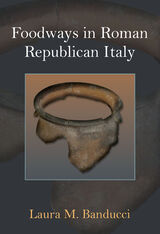 Foodways in Roman Republican Italy
Laura M. Banducci
University of Michigan Press, 2021 Foodways in Roman Republican Italy explores the production, preparation, and consumption of food and drink in Republican Italy to illuminate the nature of cultural change during this period. Traditionally, studies of the cultural effects of Roman contact and conquest have focused on observing changes in the public realm: that is, changing urban organization and landscape, and monumental construction. Foodways studies reach into the domestic realm: How do the daily behaviors of individuals express their personal identity, and How does this relate to changes and expressions of identity in broader society? Laura M. Banducci tracks through time the foodways of three sites in Etruria from about the third century BCE to the first century CE: Populonia, Musarna, and Cetamura del Chianti. All were established Etruscan sites that came under Roman political control over the course of the third and second centuries BCE. The book examines the morphology and use wear of ceramics used for cooking, preparing, and serving food in order to deduce cooking methods and the types of foods being prepared and consumed. Change in domestic behaviors was gradual and regionally varied, depending on local social and environmental conditions, shaping rather than responding to an explicitly “Roman” presence.
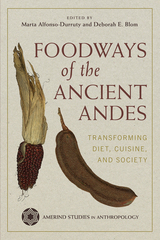 Foodways of the Ancient Andes: Transforming Diet, Cuisine, and Society
Marta P Alfonso-Durruty
University of Arizona Press, 2023 Eating is essential for life, but it also embodies social and symbolic dimensions. This volume shows how foods and peoples were mutually transformed in the ancient Andes.
Exploring the multiple social, ecological, cultural, and ontological dimensions of food in the Andean past, the contributors of Foodways of the Ancient Andes offer diverse theoretical perspectives and methodological approaches that reveal the richness, sophistication, and ingenuity of Andean peoples. The volume spans time periods and localities in the Andean region to reveal how food is intertwined with multiple aspects of the human experience, from production and consumption to ideology and sociopolitical organization. It illustrates the Andean peoples’ resilience in the face of challenges brought about by food scarcity and environmental change. Chapters dissect the intersection of food, power, and status in early states and empires; examine the impact of food during times of conflict and instability; and illuminate how sacred and high-status foods contributed to the building of the Inka Empire.
Featuring forty-six contributors from ten countries, the chapters employ new analytical methods, integrating different food data and interdisciplinary research to show that food can provide not only simple nutrition but also a multitude of strategies, social and political relationships, and ontologies that are otherwise invisible in the archaeological record.
Contributors
Aleksa K. Alaica
Sonia Alconini
Marta Alfonso-Durruty
Sarah I. Baitzel
Véronique Bélisle
Carolina Belmar
Carrie Anne Berryman
Matthew E. Biwer
Deborah E. Blom
Tamara L. Bray
Matthew T. Brown
Maria C. Bruno
José M. Capriles
Katherine L. Chiou
Susan D. deFrance
Lucia M. Diaz
Richard P. Evershed
Maureen E. Folk
Alexandra Greenwald
Chris Harrod
Christine A. Hastorf
Iain Kendall
Kelly J. Knudson
BrieAnna S. Langlie
Cecilia Lemp
Petrus le Roux
Marcos Martinez
Anahí Maturana-Fernández
Weston C. McCool
Melanie J. Miller
Nicole Misarti
Flavia Morello
Patricia Quiñonez Cuzcano
Omar Reyes
Arturo F. Rivera Infante
Manuel San Román
Francisca Santana-Sagredo
Beth K. Scaffidi
Augusto Tessone
Andrés Troncoso
Tiffiny A. Tung
Mauricio Uribe
Natasha P. Vang
Sadie L. Weber
Kurt M. Wilson
Michelle E. Young
 A Fool for Christmas: A Tale by Allan Gurganus
Allan Gurganus
Duke University Press During the Christmas season, mall pet store manager Vernon Ricketts splits his time between selling irresistible puppies and kittens festooned with holiday bows and shielding the mall's loiterers from its over-zealous manager, “Terminator” Vanderlip. Just days before Christmas, Vernon notices a small, bedraggled girl in a worn overcoat desperately trying to blend into the mall's background. Sensing she's a runaway in trouble, Vernon feels obliged to help. His kindness and their chance encounter will produce a Christmas miracle that becomes a legend as it changes lives.
Allan Gurganus’s “A Fool for Christmas” first charmed audiences when he read it on NPR’s “All Things Considered” in 2004. It appears here in print for the first time.
The publication of “A Fool for Christmas” is a partnership between Duke University Libraries (which acquired Gurganus's archives in 2018), Horse & Buggy Press, and Duke University Press.
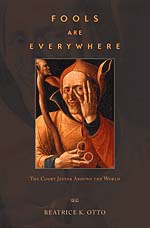 Fools Are Everywhere: The Court Jester Around the World
Beatrice K. Otto
University of Chicago Press, 2001 In this lively work, Beatrice K. Otto takes us on a journey around the world in search of one of the most colorful characters in history—the court jester. Though not always clad in cap and bells, these witty, quirky characters crop up everywhere, from the courts of ancient China and the Mogul emperors of India to those of medieval Europe, Africa, the Middle East, and the Americas. With a wealth of anecdotes, jokes, quotations, epigraphs, and illustrations (including flip art), Otto brings to light little-known jesters, highlighting their humanizing influence on people with power and position and placing otherwise remote historical figures in a more idiosyncratic, intimate light.
Most of the work on the court jester has concentrated on Europe; Otto draws on previously untranslated classical Chinese writings and other sources to correct this bias and also looks at jesters in literature, mythology, and drama. Written with wit and humor, Fools Are Everywhere is the most comprehensive look at these roguish characters who risked their necks not only to mock and entertain but also to fulfill a deep and widespread human and social need.
 Fools' Crusade: Yugoslavia, NATO and Western Delusions
Diana Johnstone
Pluto Press, 2002 In the endless series of United States military interventions, the 'humanitarian' bombing of Yugoslavia played a key role in gaining support of the centre left for war as an instrument of policy.
Thanks to massive deception and self-deception by media and politicians, even the anti-globalisation movement failed to grasp the implications of the aggressive military globalisation pursued by the United States, from Iraq to Afghanistan and beyond.
In this study, Diana Johnstone identifies the common geopolitical interests running through all these past, present and future military interventions. She argues persuasively that outside intervention creates rather than solves problems and cannot be justified.
Johnstone shows that the 'War in Kosovo' was in reality the model for future destruction of countries seen as potential threats to the hegemony of the 'International Community', led by the United States.
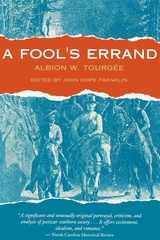 A Fool’s Errand
Albion W. Tourgée
Harvard University Press What was a carpetbagger? Albion W. Tourgée was called one, and he wrote, “To the southern mind it meant a scion of the North, a son of an ‘abolitionist,’ a creature of the conqueror, a witness to their defeat, a mark of their degradation: to them he was hateful, because he recalled all of evil or of shame they had ever known … To the Northern mind, however, the word had no vicarious significance. To their apprehension, the hatred was purely personal, and without regard to race or nativity. They thought (foolish creatures!) that it was meant to apply solely to those, who, without any visible means of support, lingering in the wake of a victorious army, preyed upon the conquered people.”
Tourgée’s novel, originally published in 1879 anonymously as A Fool’s Errand, By One of the Fools, is not strictly autobiographical, though it draws on Tourgée’s own experiences in the South. In the story Comfort Servosse, a Northerner of French ancestry, moves to a Southern state for his health and in the hope of making his fortune. These were also Tourgée’s motives for moving South. Servosse is caught up in a variety of experiences that make apparent the deep misunderstanding between North and South, and expresses opinions on the South’s intolerance, the treatment of the Negro, Reconstruction, and other issues that probably are the opinions of Tourgée himself. “Reconstruction was a failure,” he said, “so far as it attempted to unify the nation, to make one people in fact of what had been one only in name before the convulsion of Civil War. It was a failure, too, so far as it attempted to fix and secure the position and rights of the colored race.”
Though the discussion of sectional and racial problems is an important element in the book, A Fool’s Errand has merit as a dramatic narrative—with its love affair, and its moments of pathos, suffering, and tragedy. This combination of tract and melodrama made it a bestseller in its day. Total sales have been estimated as 200,000, a remarkable record in the l880’s for a book of this kind.
Though Tourgée later disavowed his early optimism about the role national education could play in remedying the race problem in the South, calling this a “genuine fool’s notion,” he might have been less pessimistic had he been alive in 1960, when the student sit-in movement began in the South. At any rate, today in what has been called the second phase of the modern revolution in race relations in this country, Tourgée’s novel about the first phase has an added relevance and interest for thinking American readers.
Fools, Martyrs, Traitors: The Story of Martyrdom in the Western World
Lacey Baldwin Smith
Northwestern University Press, 1999 Lacey Baldwin Smith takes us on a riveting journey through history as he examines one of the most baffling characteristics of the human experience: the willingness to die to sanctify a deity, defend a cause, or simply to prove a point. By delving into the psyches, politics, and personalities of martyrs like Thomas Becket, John Brown, and Gandhi, he illuminates the complex and elusive subject of martyrdom as it has evolved over 2,500 years.
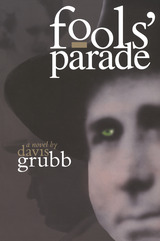 Fool's Parade
Davis Grubb
University of Tennessee Press, 2001 “Dark violence and piebald absurdity share an uncertain border, and now and then some mythmaker on his day off, like Grubb, manages to write within this certainty. A fine book, written for the hell of it, which is a splendid reason.”—Time
Set in the Appalachian backcountry in the midst of the Great Depression, Fools’ Parade traces the adventures of three ex-convicts who become involved in a wild and woolly chase along the Ohio River.
Convicted murderer Mattie Appleyard has just served forty-seven years in Glory Penitentiary. His release puts him in possession of a check for $25,452.32—the result of his having salted away his meager earnings in the Prisoner’s Work-and-Hope Savings Plan of the local bank. With his friends Johnny Jesus and Lee Cottrill, he plans to open a general store that will compete with the company store in Stonecoal, West Virginia.
Unfortunately, banker Homer Grindstaff, prison guard Uncle Doc Council, and Sheriff Duane Ewing have no intention of allowing Mattie to realize his ambitions. Mattie’s efforts to cash his check set a deadly pursuit in motion and introduce the reader to a host of colorful characters and a vividly recreated regional and historical background. Good and evil meet head-on in this novel that is, by turns, warm and humorous, rousing and tumultuous.
The Author: Davis Grubb (1919–1980) was the author of ten published novels, the most famous of which was Night of the Hunter. Both that book and Fools’ Parade, originally published in 1969, were made into motion pictures.
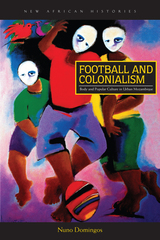 Football and Colonialism: Body and Popular Culture in Urban Mozambique
Nuno Domingos
Ohio University Press, 2017 In articles for the newspaper O Brado Africano in the mid-1950s, poet and journalist José Craveirinha described the ways in which the Mozambican football players in the suburbs of Lourenço Marques (now Maputo) adapted the European sport to their own expressive ends. Through gesture, footwork, and patois, they used what Craveirinha termed “malice”—or cunning—to negotiate their places in the colonial state. “These manifestations demand a vast study,” Craveirinha wrote, “which would lead to a greater knowledge of the black man, of his problems, of his clashes with European civilization, in short, to a thorough treatise of useful and instructive ethnography.” In Football and Colonialism, Nuno Domingos accomplishes that study. Ambitious and meticulously researched, the work draws upon an array of primary sources, including newspapers, national archives, poetry and songs, and interviews with former footballers. Domingos shows how local performances and popular culture practices became sites of an embodied history of Mozambique. The work will break new ground for scholars of African history and politics, urban studies, popular culture, and gendered forms of domination and resistance.
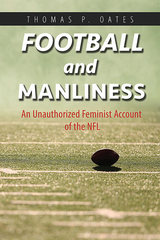 Football and Manliness: An Unauthorized Feminist Account of the NFL
Thomas P. Oates
University of Illinois Press, 2017 Women, African Americans, and gays have recently upended US culture with demands for inclusion and respect, while economic changes have transformed work and daily life for millions of Americans. The national obsession with the National Football League provides a window on this dynamic period of change, reshaping ideas about manliness to respond to new urgencies on and beyond the gridiron. Thomas P. Oates uses feminist theory to break down the dynamic cultural politics shaping, and shaped by, today's NFL. As he shows, the league's wildly popular product provides an arena for media producers to work out and recalibrate the anxieties, contradictions, and challenges that characterize contemporary masculinity. Oates draws from a range of pop culture narratives to map the complex set of theories about gender and race and to reveal a league and fan base in flux. Though longing for a past dominated by white masculinity, the mediated NFL also subtly aligns with a new economic reality that demands it cope with the shifting relations of gender, race, sexuality, and class. Indeed, pro football crafts new meanings of each by its canny mobilization of historic ideological processes.
 Football in the Americas: FayTbol, Futebol, Soccer
Edited by Rory M. Miller and Liz Crolley
University of London Press, 2007 Football (soccer in the United States) has a long history in the Americas, but it currently displays many signs of crisis. In South America the combination of spectator violence, poor business management, and the emigration of players is undermining professional football. In the United States, in contrast, a professional league (Major League Soccer) has taken root in the last decade, and the U.S. women's team has gained international success. Football has always provided its players and fans with identity and belonging, whether to a nation or to a particular social group. It has been both a vehicle for the politically ambitious and an arena in which citizens can make sense of national failings and contest existing power structures. This volume explores many of these themes. The fifteen essays range widely, with theoretical and empirical contributions on the region as whole, as well as chapters specifically on Argentina, Brazil, Peru, Mexico, and the United States.
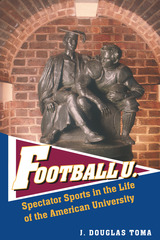 Football U.: Spectator Sports in the Life of the American University
J. Douglas Toma
University of Michigan Press, 2003 The Big Ten . . . the SEC . . . the Final Four . . . sometimes it seems that American higher education is more about sports than studies. Not so, says this well-researched, evenhanded study of athletics in university life. Sports--particularly football--play a key role in defining institutions that might otherwise be indistinguishable and are an indispensable tool in building a sense of community on campus, as well as an important factor in mustering alumni and political support.
While abuses exist, the "football school" is not only a legitimate member of the academic community but an inevitable one as well--and football provides much-needed identity at every level from the local to the national scale. Pointing out that universities compete as much academically as athletically, J. Douglas Toma argues that fielding a winning sports team is a quick, effective way to win recognition and that doing so pays dividends across the board, by raising public awareness (thereby making a school more attractive to potential students and faculty) and by creating a wider constituency of "fans" whose loyalties pay off in increased contributions and appropriations that support academic programs as well. He notes that universities like Harvard and Yale, now eclipsed on the gridiron, were "football powers" in the era when America's westward expansion spawned new schools unable to challenge older institutions academically but able to win acclaim through sports. This fosters a campus and alumni culture based on "football Saturday"--a bonding experience that helped forge a larger community whose support, both personal and financial, has become integral to the life of the institution.
Football U. brings welcome impartiality to a subject all too often riven by controversy, pitting football boosters against critics who complain that academic achievement takes second place to athletic success. But as a tool for creating "brand awareness" as well as local loyalty and widespread support, high-profile athletic programs meet a variety of institutional needs in ways no other aspect of university life can. This, Toma observes, is a two-edged sword, for even as it fosters collegiality, it discourages reform when the pendulum swings too far in the direction of athletic dominance. Nevertheless, Football U. is here to stay.
J. Douglas Toma is Director and Senior Fellow, The Executive Doctorate and Penn Center for Higher Education Management, the University of Pennsylvania's Graduate School of Education.
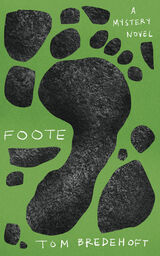 Foote: A Mystery Novel
Tom Bredehoft
West Virginia University Press, 2022 “Part mystery, part fable but all original, Jim Foote is sure to be one of your favorite literary detectives—cryptid or otherwise.” —Jordan Farmer, author of The Poison Flood and The Pallbearer
In the space of one weekend in Morgantown, West Virginia, private investigator Big Jim Foote finds himself at the center of two murder investigations. Suspected of one killing at a local festival, he locates the body of a missing person immediately after. The cops are watching him, and Big Jim has a secret he dares not reveal: he is a bigfoot living in plain sight, charged with keeping his people in the surrounding hills from being discovered. To protect the bigfoot secret, he must solve both murders—and convince himself it wasn’t a bigfoot who pulled the trigger.
Through the course of his investigations, Big Jim is helped by unique and well-rendered characters and friends in both his bigfoot and human communities. Readers are introduced to Appalachian mountain folk and traditional culture in new ways, even while Big Jim experiences the impact of the opioid epidemic on his own bigfoot kin. By centering a mythical creature as the unlikely protagonist in this enchanting literary murder mystery, Foote offers a winsome redefinition of a cryptid “monster” and breathes new life into the PI genre.
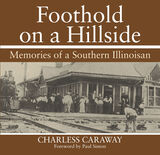 Foothold on a Hillside: Memories of a Southern Illinoisan
Charless Caraway. Foreword by Paul Simon
Southern Illinois University Press, 1986 In a style reminiscent of the master storytellers of yore, Charless Caraway recounts the story of his life, as a man and a boy, on small farms in Saline and Jackson counties, particularly around Eldorado, Makanda, and Etherton Switch. He makes no bones about the hardships of those "old days," first helping his father eke out a living from the land, then scrambling for a living as a sharecropper and fruit picker, as he scrimped and saved for the day when he and his young wife, Bessie Mae Rowan Caraway, could buy a piece of land of their own. The one-room school, the general store, the trips by wagon over roads that choked you in summer and swallowed you in winter, the home that burned: all are described in a matter-of-fact yet moving way. Many of the locations, buildings, and people are represented in equally unromanticized photographs from the family’s collection. Some of the stories and photos recall the common disasters of the frontier: drought, flood, and the tornado of 1925. It is clear from these stories that each aspect of life exacted a price, but the Caraways paid that price without regret and rallied to go on their way. Charless and his family and friends fill this book with courage, strength, and an unshakable faith in the value of human endeavor.
 The Footnote: A Curious History
Anthony Grafton
Harvard University Press, 1997 The weapon of pedants, the scourge of undergraduates, the bête noire of the “new” liberated scholar: the lowly footnote, long the refuge of the minor and the marginal, emerges in this book as a singular resource, with a surprising history that says volumes about the evolution of modern scholarship. In Anthony Grafton’s engrossing account, footnotes to history give way to footnotes as history, recounting in their subtle way the curious story of the progress of knowledge in written form.Grafton treats the development of the footnote—the one form of proof normally supplied by historians in support of their assertions—as writers on science have long treated the development of laboratory equipment, statistical arguments, and reports on experiments: as a complex story, rich in human interest, that sheds light on the status of history as art, as science, and as an institution. The book starts in the Berlin of the brilliant nineteenth-century historian Leopold von Ranke, who is often credited with inventing documented history in its modern form. Casting back to antiquity and forward to the twentieth century, Grafton’s investigation exposes Ranke’s position as a far more ambiguous one and offers us a rich vision of the true origins and gradual triumph of the footnote.Among the protagonists of this story are Athanasius Kircher, who built numerous documents into his spectacularly speculative treatises on ancient Egypt and China; Pierre Bayle, who made the footnote a powerful tool in philosophical and historical polemics; and Edward Gibbon, who transformed it into a high form of literary artistry. Proceeding with the spirit of an intellectual mystery and peppered with intriguing and revealing remarks by those who “made” this history, The Footnote brings what is so often relegated to afterthought and marginalia to its rightful place in the center of the literary life of the mind.
Footnotes: On Shoes
Edited by Shari Benstock and Suzanne Ferriss
Rutgers University Press, 2002 A lively exploration of the cultural significance of shoes.
 Footnotes to History: The Personal Realm of John Wilson Croker, Secretary to the Admiralty (1809-1830), a "Group Family"
Nigel Harris
Sussex Academic Press, 2022 This book brings a novel focus to social history. It is a study of a "group family" -- an extended family closely structured though marriages that were either internal or with trusted associates. Its members strove cooperatively for their own mutual benefit. This kind of social entity evolved down the centuries, reaching its zenith in the early nineteenth century. The family portrayed, the Pennells, provides a supreme example of such a united body. John Wilson Croker, his two half-nieces and his best friend all married into it. The size of this "group family" gave ample scope for marriages between cousins. Most men in it gained prestigious appointments through Croker's patronage, but at the price of giving him their unswerving loyalty. From diaries, personal letters, newspaper articles, Chancery papers and Government documents, the book brings the character of family members to life and shows how they interacted. Their personalities are portrayed through a wealth of entertaining anecdotes recorded by their contemporaries. Discussion focuses on the family in the nineteenth century, but how it evolved is also described. With their varied occupations and far-flung travel, the people whose stories are narrated give insight into fascinating but little frequented byways of British social and colonial history, such as intelligence gathering in the seventeenth century and the Newfoundland cod trade in the eighteenth. Their direct participation in events included riding from Dorset to London to warn James II personally of the Duke of Monmouth's landing and rescuing Marie Antoinette's daughter from Napoleon. The book takes us on a meandering journey through British history brought to life by the experiences of one family over more than two centuries. [Subject: History, Social History, British Studies]
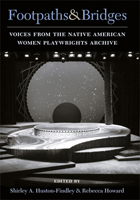 Footpaths and Bridges: Voices from the Native American Women Playwrights Archive
Edited by Shirley A. Huston-Findley and Rebecca Howard
University of Michigan Press, 2011 Footpaths and Bridges celebrates the vitality and diversity of Native American women, collecting plays ranging from ETHNOSTRESS—a humorous take on art and identity politics—to the biographical musical Te Ata to a retelling of the Thanksgiving story from the Wampanoag perspective. The dramatic works are accompanied by critical commentary that illuminates Native American women’s theater practices and perspectives, highlighting the issues of heritage, identity, and changing lifestyles that the plays imaginatively tackle. Featuring work from a wide array of tribes and geographic regions, the collection affords the artist, scholar, and general reader access to previously unheard voices that communicate the complexity and the diversity of the Native American experience. The far-ranging genres and content of the plays suggest the many possibilities for communicating the past and the present, the personal and the political, and the stunning kaleidoscope of Native American life and art. “Often thoughtful provocateurs, Native American playwrights are frequently overlooked . . . eminently readable, and possibly performable, the plays [in this collection] examine colonization, generational differences, ‘ethnostress,’ and cultural identity.”
—Choice
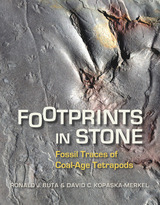 Footprints in Stone: Fossil Traces of Coal-Age Tetrapods
Ronald J. Buta and David C. Kopaska-Merkel
University of Alabama Press, 2016 The Steven C. Minkin (Union Chapel) Paleozoic Footprint Site ranks among the most important fossil sites in the world today, and Footprints in Stone recounts the accidental revelation of its existence and detailed findings about its fossil record.
Currently 2,500 miles from the equator and more than 250 miles north of the Gulf of Mexico, the Minkin site was a swampy tropical forest adjacent to a tidal flat during the Coal Age or Carboniferous Period more than 300 million years ago. That fecund strand of sand and mud at the ocean’s edge teemed with the earth’s earliest reptiles as well as amphibians, fish, horseshoe crabs, spiders, jumping insects, and other fascinating organisms. Unlike dinosaurs and other large animals whose sturdy bodies left hard fossil records, most of these small, soft-bodied creatures left no concrete remains. But they did leave something else. Preserved in the site’s coal beds along with insect wings and beautifully textured patterns of primeval plants are their footprints, fossilized animal tracks from which modern paleontologists can glean many valuable insights about their physical anatomies and behaviors.
The paleontological examination of fossil tracks is now the cutting-edge of contemporary scholarship, and the Minkin site is the first and largest site of its kind in eastern North America. Discovered by a local high school science teacher, the site provides both professional and amateur paleontologists around the world with a wealth of fossil track samples along with an inspirational story for amateur explorers and collectors.
Authoritative and extensively illustrated, Footprints in Stone brings together the contributions of many geologists and paleontologists who photographed, documented, and analyzed the Minkin site’s fossil trackways. An engrossing tale of its serendipitous discovery and a detailed study of its fossil records, Footprints in Stone is a landmark publication in the history of paleontology.
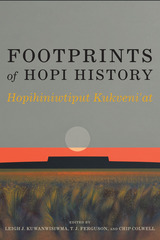 Footprints of Hopi History: Hopihiniwtiput Kukveni'at
Edited by Leigh J. Kuwanwisiwma, T. J. Ferguson, and Chip Colwell
University of Arizona Press, 2018 Kukveni—footprints—are a powerful historical metaphor that the Hopi people use to comprehend their tangible heritage. Hopis say that the deity Máasaw instructed their ancestors to leave footprints during their migrations from their origin place to their home today as evidence that they had fulfilled a spiritual pact to serve as stewards of his land. Today’s Hopis understand these footprints to be the archaeological remains of former settlements—pottery sherds, stone tools, petroglyphs, and other physical evidence of past use and occupation of the land.
The fourteen chapters in Footprints of Hopi History: Hopihiniwtiput Kukveni’at focus on these Hopi footprints as they are understood through a variety of research techniques, including archaeology, ethnography, documentary history, plant genetics, and educational outreach. The editors and contributors offer fresh and innovative perspectives on Hopi archaeology and history, and demonstrate how one tribe has significantly advanced knowledge about its past through collaboration with archaeologists and cultural anthropologists.
The book features managerial uses of research, cultural landscape theory, use of GIS in research, archaeological interpretations of social identity and immigration, analysis of corn genetics, heritage education of youth, and research of oral traditions and documentary history. Footprints of Hopi History highlights the Hopi tribe’s leadership in sustained efforts to create bridges between tribal goals and anthropology, forging a path for others to follow.
Contributors
E. Charles Adams
Wesley Bernardini
Joëlle Clark
Chip Colwell
T. J. Ferguson
Dennis Gilpin
Kelley Hays-Gilpin
George Gumerman IV
Saul L. Hedquist
Maren P. Hopkins
Stewart B. Koyiyumptewa
Leigh J. Kuwanwisiwma
Lee Wayne Lomayestewa
Patrick D. Lyons
Shirley Powell
Gregson Schachner
Thomas E. Sheridan
Mark D. Varien
Laurie D. Webster
Peter M. Whiteley
Michael Yeatts
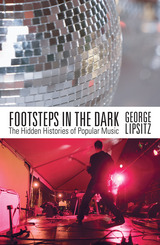 Footsteps in the Dark: The Hidden Histories of Popular Music
George Lipsitz
University of Minnesota Press, 2007 Most pop songs are short-lived. They appear suddenly and, if they catch on, seem to be everywhere at once before disappearing again into obscurity. Yet some songs resonate more deeply—often in ways that reflect broader historical and cultural changes. In Footsteps in the Dark, George Lipsitz illuminates these secret meanings, offering imaginative interpretations of a wide range of popular music genres from jazz to salsa to rock. Sweeping changes that only remotely register in official narratives, Lipsitz argues, can appear in vivid relief within popular music, especially when these changes occur outside mainstream white culture. Using a wealth of revealing examples, he discusses such topics as the emergence of an African American techno music subculture in Detroit as a contradictory case of digital capitalism and the prominence of banda, merengue, and salsa music in the 1990s as an expression of changing Mexican, Dominican, and Puerto Rican nationalisms. Approaching race and popular music from another direction, he analyzes the Ken Burns PBS series Jazz as a largely uncritical celebration of American nationalism that obscures the civil rights era’s challenge to racial inequality, and he takes on the infamous campaigns to censor hip-hop and the radical black voice in the early 1990s. Teeming with astute observations and brilliant insights about race and racism, deindustrialization, and urban renewal and their connections to music, Footsteps in the Dark puts forth an alternate history of post–cold war America and shows why in an era given to easy answers and clichéd versions of history, pop songs matter more than ever. George Lipsitz is professor of black studies and sociology at the University of California, Santa Barbara. Among his many books are Life in the Struggle, Dangerous Crossroads, and American Studies in a Moment of Danger (Minnesota, 2001).
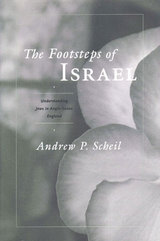 The Footsteps of Israel: Understanding Jews in Anglo-Saxon England
Andrew P. Scheil
University of Michigan Press, 2004 "This innovative, well-researched study looks at anti-Judaic rhetoric in the Old English and Latin texts of Anglo-Saxon England-a land lacking real Jews. The author isolates a common pool of inherited images for portraying the Jew, and teaches us to hear, especially in the vernacular, their increasingly dark and disturbing inflections."
---Roberta Frank, Yale University
"The Footsteps of Israel is a fascinating study of a pervasive stereotype. Scheil's analysis of how Jews, with no real physical presence in Anglo-Saxon England, captured the imagination of writers of the period, is a superb achievement."
---Louise Mirrer, President and CEO, New-York Historical Society
"The elegance of Scheil's prose weaves a unifying thread through the vast literary and historical tapestry he presents, moving with grace from Latin to Old English, from Bede to later authors, from Wordsworth and Blake to modern writers. He speaks elegantly of these texts' conversations with the past, and the Jews emerge as both enemies and spiritual antecedents of the 'New Israel' of Anglo-Saxon England."
---Stephen Spector, State University of New York, Stonybrook
Jews are the omnipresent border-dwellers of medieval culture, a source of powerful metaphors active in the margins of medieval Christianity. This book outlines an important prehistory to later persecutions in England and beyond, yet it also provides a new understanding of the previously unrecognized roles Jews and Judaism played in the construction of social identity in early England.
Andrew P. Scheil approaches the Anglo-Saxon understanding of Jews from a variety of directions, including a survey of the lengthy history of the ideology of England as the New Israel, its sources in late antique texts and its manifestation in both Old English and Latin texts from Anglo-Saxon England. In tandem with this perhaps more sympathetic understanding of the Jews is a darker vision of anti-Judaism, associating the Jews in an emotional fashion with the materiality of the body.
In exploring the complex ramifications of this history, the author is the first to assemble and study references to Jews in Anglo-Saxon culture. For this reason, The Footsteps of Israel will be an important source for Anglo-Saxonists, scholars of late antiquity and the early Middle Ages, scholars of medieval antisemitism in general, students of Jewish history, and medievalists interested in cultural studies.
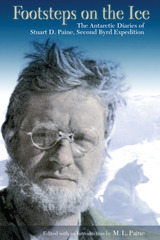 Footsteps on the Ice: The Antarctic Diaries of Stuart D. Paine, Second Byrd Expedition
Stuart D. Paine, Edited & Intro by M. L. Paine
University of Missouri Press, 2007 In 1933 Antarctica was essentially unexplored. Admiral Richard Byrd launched his Second Expedition to chart the southernmost continent, primarily relying on the muscle power of dog teams and their drivers who skied or ran beside the loaded sledges as they traveled. The life-threatening challenges of moving glaciers, invisible crevasses, and horrific storms compounded the difficulties of isolation, darkness, and the unimaginable cold that defined the men’s lives. Stuart Paine was a dog driver, radio operator, and navigator on the fifty-six-man expedition, the bold and complex venture that is now famous for Byrd’s dramatic rescue from Bolling Advance Weather Base located 115 miles inland. Paine’s diaries represent the only published contemporary account written by a member of the Second Expedition. They reveal a behind-the-scenes look at the contentiousness surrounding the planned winter rescue of Byrd and offer unprecedented insights into the expedition’s internal dynamics. Equally riveting is Paine’s breathtaking narrative of the fall and summer field operations as the field parties depended on their own resources in the face of interminable uncertainty and peril. Undertaking the longest and most hazardous sledging journey of the expedition, Paine guided the first American party from the edge of the Ross Sea more than seven hundred miles up the Ross Ice Shelf and the massive Thorne (Scott) Glacier to approach the South Pole. He and two other men skied more than fourteen hundred miles in eighty-eight days to explore and map part of Antarctica for the first time. Footsteps on the Ice reveals the daily struggles, extreme personalities, and the matter-of-fact bravery of early explorers who are now fading into history. Detailing the men’s frustrations, annoyances, and questioning of their leader, Paine’s entries provide rare insight into how Byrd conducted his expeditions. Paine exposes the stresses of living under the snow in Little America during the four-month-long winter night, trapped in dim, crowded huts and black tunnels, while the men uneasily mulled over their leader’s isolation at Advance Base. The fates of Paine’s dogs, which provided some of his most difficult and rewarding experiences, are also described—his relationship with Jack, his lead dog, is an entrancing story in itself. Featuring previously unpublished photographs and illustrations, Footsteps on the Ice documents the period in Antarctic exploration that bridged the “heroic era” and the modern age of mechanized travel. Depicting almost incomprehensible mental and physical duress and unhesitating courage, Paine’s tale is one of the most compelling stories in polar history, surpassing other accounts with its immediacy and adventure as it captures the majesty and mystery of the untouched Antarctic.
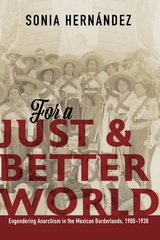 For a Just and Better World: Engendering Anarchism in the Mexican Borderlands, 1900-1938
Sonia Hernandez
University of Illinois Press, 2021 Caritina Piña Montalvo personified the vital role played by Mexican women in the anarcho-syndicalist movement. Sonia Hernández tells the story of how Piña and other Mexicanas in the Gulf of Mexico region fought for labor rights both locally and abroad in service to the anarchist ideal of a worldwide community of workers. An international labor broker, Piña never left her native Tamaulipas. Yet she excelled in connecting groups in the United States and Mexico. Her story explains the conditions that led to anarcho-syndicalism's rise as a tool to achieve labor and gender equity. It also reveals how women's ideas and expressions of feminist beliefs informed their experiences as leaders in and members of the labor movement. A vivid look at a radical activist and her times, For a Just and Better World illuminates the lives and work of Mexican women battling for labor rights and gender equality in the early twentieth century.
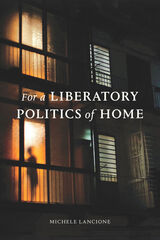 For a Liberatory Politics of Home
Michele Lancione
Duke University Press, 2023 In For a Liberatory Politics of Home, Michele Lancione questions accepted understandings of home and homelessness to offer a radical proposition: homelessness cannot be solved without dismantling current understandings of home. Conventionally, home is framed as a place of security and belonging, while its loss defines what it means to be homeless. On the basis of this binary, a whole industry of policy interventions, knowledge production, and organizing fails to provide solutions to homelessness but perpetuates violent and precarious forms of inhabitation. Drawing on his research and activism around housing in Europe, Lancione attends to the interlocking crises of home and homelessness by recentering the political charge of precarious dwelling. It is there, if often in unannounced ways, that a profound struggle for a differential kind of homing signals multiple possibilities to transcend the violences of home/homelessness. In advancing a new approach to work with the politics of inhabitation, Lancione provides a critique of current practices and offers a transformative vision for a renewed, liberatory politics of home.
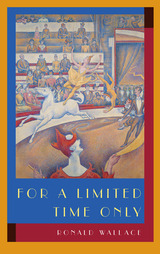 For a Limited Time Only
Ronald Wallace
University of Pittsburgh Press, 2008 For a Limited TIme Only, Ronald Wallace's eighth collection of poems, is perhaps his darkest and most meditative to date, focusing his experiences with illness, old age, and mortality; his father-in-law's death after a long bout with Alzheimer's; his step-father's death after a painful struggle with esophageal cancer, his own bout with prostate cancer. These personal experiences form the core of the first three sections of the book, but are mediated by theological and philosophical speculations that find further voice in the character of a “Mr. Grim,” whose angry, self-pitying, gruff, comic, self-depreciating, nostalgic, defeated, and hopeful riffs on the human condition provide a bridge to the affirmative, often comic, close. In the final two sections, in poems in praise of his dentist, his barber, his wife, his grandparents, the morpheme, Mr. Malaprop, Pluto, tattoos, hamburger heaven, sex talk, and poetry itself, Wallace once again proves the resilience of hope and humor in what is, for him, finally a world of wonders.
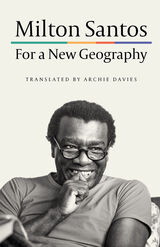 For a New Geography
Milton Santos
University of Minnesota Press, 2021 For the first time in English, a key work of critical geography
Originally published in 1978 in Portuguese, For a New Geography is a milestone in the history of critical geography, and it marked the emergence of its author, Milton Santos (1926–2001), as a major interpreter of geographical thought, a prominent Afro-Brazilian public intellectual, and one of the foremost global theorists of space. Published in the midst of a crisis in geographical thought, For a New Geography functioned as a bridge between geography’s past and its future. In advancing his vision of a geography of action and liberation, Santos begins by turning to the roots of modern geography and its colonial legacies. Moving from a critique of the shortcomings of geography from the field’s foundations as a modern science to the outline of a new field of critical geography, he sets forth both an ontology of space and a methodology for geography. In so doing, he introduces novel theoretical categories to the analysis of space. It is, in short, both a critique of the Northern, Anglo-centric discipline from within and a systematic critique of its flaws and assumptions from outside. Critical geography has developed in the past four decades into a heterogenous and creative field of enquiry. Though accruing a set of theoretical touchstones in the process, it has become detached from a longer and broader history of geographical thought. For a New Geography reconciles these divergent histories. Arriving in English at a time of renewed interest in alternative geographical traditions and the history of radical geography, it takes its place in the canonical works of critical geography.
For a New Novel: Essays on Fiction
Alain Robbe-Grillet
Northwestern University Press, 1989 Alain Robbe-Grillet, one of the leaders of the new French literary movement of the sixties, has long been regarded as the outstanding writer of the nouveau roman, as well as its major spokesman. For a New Novel reevaluates the techniques, ethos, and limits of contemporary fiction. This is a work of immense importance for any discussions of the history of the novel and for contemporary thinking about the future of fiction.
 For a Pragmatics of the Useless
Erin Manning
Duke University Press, 2020 What has a use in the future, unforeseeably, is radically useless now. What has an effect now is not necessarily useful if it falls through the gaps. In For a Pragmatics of the Useless Erin Manning examines what falls outside the purview of already-known functions and established standards of value, not for want of potential but for carrying an excess of it. The figures are various: the infrathin, the artful, proprioceptive tactility, neurodiversity, black life. It is around the latter two that a central refrain echoes: "All black life is neurodiverse life." This is not an equation, but an "approximation of proximity." Manning shows how neurotypicality and whiteness combine to form a normative baseline for existence. Blackness and neurodiversity "schizz" around the baseline, uselessly, pragmatically, figuring a more-than of life living. Manning, in dialogue with Félix Guattari and drawing on the black radical tradition's accounts of black life and the aesthetics of black sociality, proposes a "schizoanalysis" of the more-than, charting a panoply of techniques for other ways of living and learning.
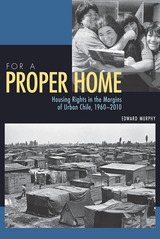 For a Proper Home: Housing Rights in the Margins of Urban Chile, 1960-2010
Edward Murphy
University of Pittsburgh Press, 2015 From 1967 to 1973, a period that culminated in the socialist project of Salvador Allende, nearly 400,000 low-income Chileans illegally seized parcels of land on the outskirts of Santiago. Remarkably, today almost all of these individuals live in homes with property titles. As Edward Murphy shows, this transformation came at a steep price, through an often-violent political and social struggle that continues to this day.
In analyzing the causes and consequences of this struggle, Murphy reveals a crucial connection between homeownership and understandings of proper behavior and governance. This link between property and propriety has been at the root of a powerful, contested urban politics central to both social activism and urban development projects. Through projects of reform, revolution, and reaction, a right to housing and homeownership has been a significant symbol of governmental benevolence and poverty reduction. Under Pinochet’s neoliberalism, subsidized housing and slum eradication programs displaced many squatters, while awarding them homes of their own. This process, in addition to ongoing forms of activism, has permitted the vast majority of squatters to live in homes with property titles, a momentous change of the past half-century.
This triumph is tempered by the fact that today the urban poor struggle with high levels of unemployment and underemployment, significant debt, and a profoundly segregated and hostile urban landscape. They also find it more difficult to mobilize than in the past, and as homeowners they can no longer rally around the cause of housing rights.
Citing cultural theorists from Marx to Foucault, Murphy directly links the importance of home ownership and property rights among Santiago’s urban poor to definitions of Chilean citizenship and propriety. He explores how the deeply embedded liberal belief system of individual property ownership has shaped political, social, and physical landscapes in the city. His approach sheds light on the role that social movements and the gendered contours of home life have played in the making of citizenship. It also illuminates processes through which squatters have received legally sanctioned homes of their own, a phenomenon of critical importance in cities throughout much of Latin America and the Global South.
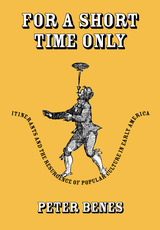 For a Short Time Only: Itinerants and the Resurgence of Popular Culture in Early America
Peter Benes
University of Massachusetts Press, 2016 Winner of the 2017 Theatre Library Association's George Freedley Memorial Book Award
By the 1740s, colonists living in North America began to encounter scores of itinerant performers from England and Europe. These show people—acrobats, wire dancers, tumblers, trick riders, painters, dancing-masters, waxworks proprietors, healers, and singing and language teachers—brought novelty and culture to remote areas. Advertising in newspapers, they attracted audiences with the hook of appearing "for a short time only."
In this richly illustrated and deeply researched book, Peter Benes examines the rise of early American popular culture through the lives and work of itinerants who circulated in British North America and the United States from the late seventeenth through the early nineteenth century. Although they were frequently reviled as quacks and absconders by many provincials, these transients enjoyed a unique camaraderie and found audiences among high- and lowbrow alike. Drawing on contemporary diaries, letters, reminiscences, and hitherto inaccessible newspaper ads, broadsides, and images, Benes suggests why some elements of Europe's carnival and folklore traditions failed to gain acceptance in American society while others flourished brilliantly.
 For All of Humanity: Mesoamerican and Colonial Medicine in Enlightenment Guatemala
Martha Few
University of Arizona Press, 2015 Smallpox, measles, and typhus. The scourges of lethal disease—as threatening in colonial Mesoamerica as in other parts of the world—called for widespread efforts and enlightened attitudes to battle the centuries-old killers of children and adults. Even before edicts from Spain crossed the Atlantic, colonial elites oftentimes embraced medical experimentation and reform in the name of the public good, believing it was their moral responsibility to apply medical innovations to cure and prevent disease. Their efforts included the first inoculations and vaccinations against smallpox, new strategies to protect families and communities from typhus and measles, and medical interventions into pregnancy and childbirth.
For All of Humanity examines the first public health campaigns in Guatemala, southern Mexico, and Central America in the eighteenth and early nineteenth centuries. Martha Few pays close attention to Indigenous Mesoamerican medical cultures, which not only influenced the shape and scope of those regional campaigns but also affected the broader New World medical cultures. The author reconstructs a rich and complex picture of the ways colonial doctors, surgeons, Indigenous healers, midwives, priests, government officials, and ordinary people engaged in efforts to prevent and control epidemic disease.
Few’s analysis weaves medical history and ethnohistory with social, cultural, and intellectual history. She uses prescriptive texts, medical correspondence, and legal documents to provide rich ethnographic descriptions of Mesoamerican medical cultures, their practitioners, and regional pharmacopeia that came into contact with colonial medicine, at times violently, during public health campaigns.
 For All Peoples and All Nations: The Ecumenical Church and Human Rights
John S. Nurser. Foreword by David Little
Georgetown University Press, 2005 In this new century, born in hope but soon thereafter cloaked in terror, many see religion and politics as a volatile, if not deadly, mixture. For All Peoples and All Nations uncovers a remarkable time when that was not so; when together, those two entities gave rise to a new ideal: universal human rights. John Nurser has given life to a history almost sadly forgotten, and introduces the reader to the brilliant and heroic people of many faiths who, out of the aftermath of World War II and in the face of cynicism, dismissive animosity, and even ridicule, forged one of the world's most important secular documents, the United Nations's Universal Declaration of Human Rights. These courageous, persistent, visionary individuals—notable among them an American Lutheran Seminary professor from Philadelphia, O. Frederick Nolde—created the Commission on Human Rights. Eventually headed by one of the world's greatest humanitarians, Eleanor Roosevelt, the Universal Declaration has become the touchstone for political legitimacy. As David Little says in the foreword to this remarkable chronicle, "Both because of the large gap it fills in the story of the founding of the United Nations and the events surrounding the adoption of human rights, and because of the wider message it conveys about religion and peacebuilding, For All Peoples and All Nations is an immensely important contribution. We are all mightily in John Nurser's debt." If religion and politics could once find common ground in the interest of our shared humanity, there is hope that it may yet be found again.
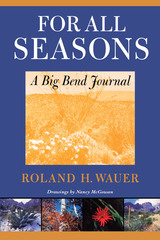 For All Seasons: A Big Bend Journal
By Roland H. Wauer
University of Texas Press, 1997 Something about Big Bend National Park draws visitors again and again. Maybe it's the spare beauty of the mountains and desert, the dawn chorus of birds, or the vivid stars in the velvet night. All of these things have made it Roland Wauer's favorite place. In this book, he shares his love of the Big Bend through journal entries that chronicle a year in the life of the park. Wauer worked as Chief Park Naturalist from 1966 to 1972 and has visited the park frequently ever since. His journal entries span these thirty years, providing not only a composite portrait of a typical year but also a clear sense of how the park's natural history has changed over three decades. He spices his account with anecdotes, often humorous, ranging from stumbling across a herd of javelinas to being trailed by a mountain lion in the dark to discovering new species of plants and animals. Few authors know the Big Bend as Roland Wauer does or have written about it in a more engaging way. This beautifully illustrated book is the perfect companion for a visit to the park, whether in person or by armchair.
 For All Waters: Finding Ourselves in Early Modern Wetscapes
Lowell Duckert
University of Minnesota Press, 2017 Recent years have witnessed a surge in early modern ecostudies, many devoted to Shakespearean drama. Yet in this burgeoning discipline, travel writing appears moored in historicization, inorganic subjects are far less prevalent than organic ones, and freshwater sites are hardly visited. For All Waters explores these uncharted wetscapes. Lowell Duckert shows that when playwrights and travel writers such as Sir Walter Raleigh physically interacted with rivers, glaciers, monsoons, and swamps, they composed “hydrographies,” or bodily and textual assemblages of human and nonhuman things that dissolved notions of human autonomy and its singular narrativity. With a playful, punning touch woven deftly into its theoretical rigor, For All Waters disputes fantasies of ecological solitude that would keep our selves high and dry and that would try to sustain a political ecology excluding water and the poor. The lives of both humans and waterscapes can be improved simultaneously through direct engagement with wetness. For All Waters concludes by investigating waterscapes in peril today—West Virginia’s chemical rivers and Iceland’s vanishing glaciers—and outlining what we can learn from early moderns’ eco-ontological lessons. By taking their soggy and storied matters to heart, and arriving at a greater realization of our shared wetness, we can conceive new directions to take within the hydropolitical crises afflicting us today.
For All We Have and Are: Regina and the Experience of the Great War
James M. Pitsula
University of Manitoba Press, 2008 The First World War profoundly affected every community in Canada. In Regina, the politics of national identity, the rural myth, and the social gospel all lent a distinctive flavour to the city’s experience of the Great War. For many Reginans, the fight against German militarism merged with the struggle against social evils and the “Big Interests,” adding new momentum to the forces of social reform, including the fights for prohibition and women’s suffrage.James M. Pitsula traces these social movements against the background of the lives of Regina men who fought overseas in battles such as Passchendaele and Vimy Ridge. Skillfully combining vivid detail with the larger social context, For All We Have and Are provides a nuanced picture of how one Canadian community rebuilt both its realities and myths in response to the cataclysm of the “war to end all wars.”
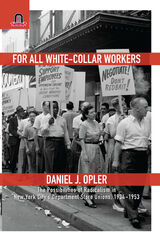 For All White-Collar Workers: The Possibilities of Radicalism in New York City's Department Store Unions, 1934–1953
Daniel J. Opler
Ohio State University Press, 2007 In recent decades the American labor movement has fallen on hard times, in part due to its long reliance on blue-collar workers for its membership despite the growing importance of retail and service jobs. In For All White-Collar Workers: The Possibilities of Radicalism in New York City’s Department Store Unions, 1934–1953, Daniel Opler examines early efforts to unionize workers in department and retail stores. Beginning with the origins of the modern labor movement in the mid-1930s, Opler argues that Communist labor organizers created vibrant and powerful unions in New York City’s department stores, only to see those unions—and the CIO’s powerful retail workers’ union—destroyed during the McCarthy era. In the process of examining these unions, Opler takes the reader far beyond union meetings and contract negotiations, exploring the ways in which consumption, urban life, and changing understandings of public space affected the unions in these eras. As a result, For All White-Collar Workers becomes an exploration of such diverse subjects as the conflicts over midtown Manhattan, the 1939–1940 New York World’s Fair, the link between consumption and patriotism during World War II, private housing developments in 1940s New York City, and suburbanization, all viewed through the lens of the rise and fall of New York City’s department store unions.
For an Ontology of Morals: A Critique of Contemporary Ethical Theory
Henry B. Veatch
Northwestern University Press, 1971 For an Ontology of Morals: A Critique of Contemporary Ethical Theory assesses contemporary trends in ethical theory, including the deontological tradition dating back to Kant, the teleological tradition of the utilitarians, the analytic movement, and the existentialist-phenomenologist movement. In refuting these trends, Henry B. Veatch argues that moral and ethical distinctions cannot be rightly or adequately understood if they are regarded simply as matters of linguistic use but are grounded in the very being and nature of things.
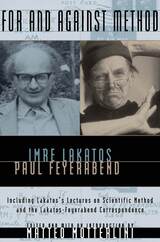 For and Against Method: Including Lakatos's Lectures on Scientific Method and the Lakatos-Feyerabend Correspondence
Imre Lakatos and Paul Feyerabend
University of Chicago Press, 1999 The work that helped to determine Paul Feyerabend's fame and notoriety, Against Method, stemmed from Imre Lakatos's challenge: "In 1970 Imre cornered me at a party. 'Paul,' he said, 'you have such strange ideas. Why don't you write them down? I shall write a reply, we publish the whole thing and I promise you—we shall have a lot of fun.' " Although Lakatos died before he could write his reply, For and Against Method reconstructs his original counter-arguments from lectures and correspondence previously unpublished in English, allowing us to enjoy the "fun" two of this century's most eminent philosophers had, matching their wits and ideas on the subject of the scientific method.
For and Against Method opens with an imaginary dialogue between Lakatos and Feyerabend, which Matteo Motterlini has constructed, based on their published works, to synthesize their positions and arguments. Part one presents the transcripts of the last lectures on method that Lakatos delivered. Part two, Feyerabend's response, consists of a previously published essay on anarchism, which began the attack on Lakatos's position that Feyerabend later continued in Against Method. The third and longest section consists of the correspondence Lakatos and Feyerabend exchanged on method and many other issues and ideas, as well as the events of their daily lives, between 1968 and Lakatos's death in 1974.
The delight Lakatos and Feyerabend took in philosophical debate, and the relish with which they sparred, come to life again in For and Against Method, making it essential and lively reading for anyone interested in these two fascinating and controversial thinkers and their immense contributions to philosophy of science.
"The writings in this volume are of considerable intellectual importance, and will be of great interest to anyone concerned with the development of the philosophical views of Lakatos and Feyerabend, or indeed with the development of philosophy of science in general during this crucial period."—Donald Gillies, British Journal for the Philosophy of Science (on the Italian edition)
"A stimulating exchange of letters between two philosophical entertainers."—Tariq Ali, The Independent
Imre Lakatos (1922-1974) was professor of logic at the London School of Economics. He was the author of Proofs and Refutations and the two-volume Philosophical Papers. Paul Feyerabend (1924-1994) was educated in Europe and held numerous teaching posts throughout his career. Among his books are Against Method; Science in a Free Society; Farewell to Reason; and Killing Time: The Autobiography of Paul Feyerabend, the last published by the University of Chicago Press.
For Badiou: Idealism without Idealism
Frank Ruda; Preface by Slavoj Zizek
Northwestern University Press, 2015 For Badiou serves both as an introduction to the influential French philosopher Alain Badiou’s thought and as an in-depth examination of his work. Ruda begins with a thorough and clear outline of the sometimes difficult main tenets of Badiou’s philosophy. He then traces the philosophers throughout Western thought who have influenced Badiou’s project—especially Plato, Descartes, Hegel, and Marx—and on whose work Badiou has developed his provocative philosophy. Ruda draws from Badiou’s oeuvre a series of directives with regard to renewing philosophy for the twenty-first century. For Badiou continues the interrogations of its subject and raises new materialistic and dialectical questions for the next generation of engaged philosophers.
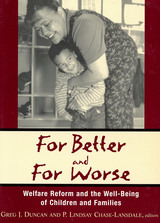 For Better and For Worse: Welfare Reform and the Well-Being of Children and Families
Greg J. Duncan
Russell Sage Foundation, 2001 The 1996 welfare reform bill marked the beginning of a new era in public assistance. Although the new law has reduced welfare rolls, falling caseloads do not necessarily mean a better standard of living for families. In For Better and For Worse, editors Greg J. Duncan and P. Lindsay Chase-Lansdale and a roster of distinguished experts examine the evidence and evaluate whether welfare reform has met one of its chief goals-improving the well-being of the nation's poor children. For Better and For Worse opens with a lively political history of the welfare reform legislation, which demonstrates how conservative politicians capitalize on public concern over such social problems as single parenthood to win support for the radical reforms. Part I reviews how individual states redesigned, implemented, and are managing their welfare systems. These chapters show that most states appear to view maternal employment, rather that income enhancement and marriage, as key to improving child well-being. Part II focuses on national and multistate evaluations of the changes in welfare to examine how families and children are actually faring under the new system. These chapters suggest that work-focused reforms have not hurt children, and that reforms that provide financial support for working families can actually enhance children's development. Part III presents a variety of perspectives on policy options for the future. Remarkable here is the common ground for both liberals and conservatives on the need to support work and at the same time strengthen safety-net programs such as Food Stamps. Although welfare reform-along with the Earned Income Tax Credit and the booming economy of the nineties-has helped bring mothers into the labor force and some children out of poverty, the nation still faces daunting challenges in helping single parents become permanent members of the workforce. For Better and For Worse gathers the most recent data on the effects of welfare reform in one timely volume focused on improving the life chances of poor children.
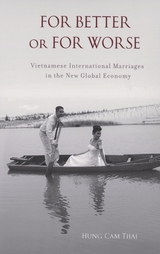 For Better or For Worse: Vietnamese International Marriages in the New Global Economy
Thai, Hung Cam
Rutgers University Press, 2008 Marriage is currently the number-one reason people migrate to the United States, and women constitute the majority of newcomers joining husbands who already reside here. But little is known about these marriage and migration streams beyond the highly publicized and often sensationalized phenomena of mail-order and military brides. Less commonly known is that most international couples are immigrants of the same ethnicity.
In For Better or For Worse, Hung Cam Thai takes a closer look at marriage and migration, with a specific focus on the unions between Vietnamese men living in the United States and the women who marry them. Weaving together a series of personal stories, he underscores the ironies and challenges that these unions face. He includes the voices of working-class immigrant men dealing with marginalization in their adopted country. These men speak about wanting "traditional" wives who they hope will recognize their gendered authority. Meanwhile, young Vietnamese college-educated women, undesirable to bachelors in their own country who are seeking subservient wives, express a preference for men of the same ethnicity but with a more liberal outlook on gender-men they imagine they will find in the United States.
A sense of foreboding pervades the book as Thai captures the incompatible viewpoints of the couples who appear to be separated not only geographically but ideologically.
 For Both Cross and Flag: Catholic Action, Anti-Catholicism, and National Security Politics in World War II San Francisco
Authored by William Issel
Temple University Press, 2010 Against a backdrop of war and anti-Catholic sentiment, one man loses his rights because he is falsely accused
In this fascinating, detailed history, William Issel recounts the civil rights abuses suffered by Sylvester Andriano, an Italian American Catholic civil leader whose religious and political activism in San Francisco provoked an Anti-Catholic campaign against him. A leading figure in the Catholic Action movement, Andriano was falsely accused in state and federal Un-American Activities Committee hearings of having Fascist sympathies prior to and during World War II. As his ordeal began, Andriano was subjected to a hostile investigation by the FBI, whose confidential informants were his political rivals. Furthermore, the U.S. Army ordered him to be relocated on the grounds that he was a security risk.
For Both Cross and Flag provides a dramatic illustration of what can happen when parties to urban political rivalries, rooted in religious and ideological differences, seize the opportunity provided by a wartime national security emergency to demonize their enemy as “a potentially dangerous person.”
Issel presents a cast of characters that includes archbishops, radicals, the Kremlin, and J. Edgar Hoover, to examine the significant role faith-based political activism played in the political culture that violated Andriano’s constitutional rights. Exploring the ramifications of this story, For Both Cross and Flag presents interesting implications for contemporary events and issues relating to urban politics, ethnic groups, and religion in a time of war.
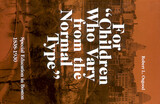 For “Children Who Vary from the Normal Type”
Robert Osgood
Gallaudet University Press, 2000 In his perceptive study of the education of disabled children during the 19th and early 20th centuries, Robert Osgood focuses upon the Boston school system as both typical and a national leader among urban centers at that time. Osgood points out that a host of significant figures worked in education in the region, including Horace Mann, George Emerson, and John Philbrick, and also Thomas Hopkins Gallaudet, Samuel Gridley Howe, Edouard Seguin, Hervey Wilbur, and Walter Fernald, each of the latter group noted for first founding and/or directing institutions for individuals with disabilities.
For “Children Who Vary from the Normal Type” describes the growth of Boston and its educational system during this period, then examines closely the emergence of individual programs that catered to students formally identified as having special needs: intermediate schools and ungraded classes; three separate programs for students with children; special classes for mentally retarded children; and other programs established between 1908 and 1913. Osgood describes these programs and their relations with each other, and also the rationales offered for their establishment and support. This detailed examination graphically depicts how patterns of integration and segregation in special education shifted over time in Boston, and provides a foundation for continuing the present-day discussion of the politics and realities of inclusion.
For Dear Life
Ronald Wallace
University of Pittsburgh Press, 2015 In For Dear Life, with accessibility, wit, and humor, Ronald Wallace evokes a wide variety of subjects that range from the traditional themes of lyric poetry—love, death, sex, the natural world, marriage, birth, childhood, music, religion, art—to the most unexpected and quirky narratives—an ode to excrement, a catalogue of comic one-liners, a celebratory testimonial to his teeth.
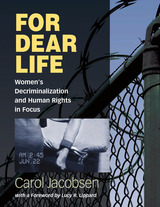 For Dear Life: Women's Decriminalization and Human Rights in Focus
Carol Jacobsen
University of Michigan Press, 2019 For Dear Life chronicles feminist and artist Carol Jacobsen's deep commitment to the causes of justice and human rights, and focuses a critical lens on an American criminal-legal regime that imparts racist, gendered, and classist modes of punishment to women lawbreakers. Jacobsen's tireless work with and for women prisoners is charted in this rich assemblage of images and texts that reveal the collective strategies she and the prisoners have employed to receive justice. The book gives evidence that women's lawbreaking is often an effort to survive gender-based violence. The faces, letters, and testimonies of dozens of incarcerated women with whom Jacobsen has worked present a visceral yet politicized chorus of voices against the criminal-legal systems that fail us all. Their voices are joined by those of leading feminist scholars in essays that illuminate the arduous methods of dissent that Jacobsen and the others have employed to win freedom for more than a dozen women sentenced to life imprisonment, and to free many more from torturous prison conditions. The book is a document to Jacobsen's love and lifelong commitment to creating feminist justice and freedom, and to the efficacy of her artistic, legal, and extralegal political actions on behalf of women.
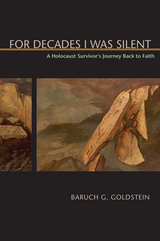 For Decades I Was Silent: A Holocaust Survivor's Journey Back to Faith
Baruch G. Goldstein
University of Alabama Press, 2008 A fascinating memoir about a Holocaust survivor's loss of and journey back to faith. In 1939, Baruch Goldstein was a religiously observant adolescent resident of the Jewish community in Mlawa, a town that was then in East Prussia. After war broke out, the Jewish community there was relatively sheltered, as that region was incorporated into the German Reich rather than into the General Government (the German run-fragment of pre-war Poland, where conditions were harsh for everyone). However in 1942, Goldstein was sent to Auschwitz, where he stayed two-and-a-half years. His family was scattered all to their deaths, but he survived the war--barely. For Decades I Was Silent is an account of life in a small Polish-German town and provides information on the religious life of the Jewish citizens. This book creates a direct sense of the random, mystifying personal violence individuals felt at the hands of Germans--not the anonymous industrial death machine, but immediate, face-to-face violence. After the war, Goldstein drifted as a refugee to UNRR camps in Italy. Over time, young Goldstein had to face the fact that all of his extended family was lost and he had only the possibilities of Palestine or help from distant relatives in the United States as a future. His American relatives urged him to enter the United States as a yeshiva student, and eventually he became a rabbi and started a family. As a young rabbinical student, and then as a rabbi, Goldstein was forced to confront the events of the Holocaust and the damage done to his faith.
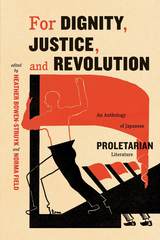 For Dignity, Justice, and Revolution: An Anthology of Japanese Proletarian Literature
Edited by Heather
Bowen-Struyk and Norma Field
University of Chicago Press, 2015 Fiction created by and for the working class emerged worldwide in the early twentieth century as a response to rapid modernization, dramatic inequality, and imperial expansion. In Japan, literary youth, men and women, sought to turn their imaginations and craft to tackling the ensuing injustices, with results that captured both middle-class and worker-farmer readers. This anthology is a landmark introduction to Japanese proletarian literature from that period.
Contextualized by introductory essays, forty expertly translated stories touch on topics like perilous factories, predatory bosses, ethnic discrimination, and the myriad indignities of poverty. Together, they show how even intensely personal issues form a pattern of oppression. Fostering labor consciousness as part of an international leftist arts movement, these writers, lovers of literature, were also challenging the institution of modern literature itself. This anthology demonstrates the vitality of the “red decade” long buried in modern Japanese literary history.
For Dust Thou Art
Timothy Liu
Southern Illinois University Press, 2005 Running the gamut from traditional to radical forms, Timothy Liu’s sixth collection of poems, For Dust Thou Art, continues the trajectory of his previous books but extends his lyrical range. The centerpiece of the volume’s tripartite structure is a meditation on the events surrounding 9/11 and its aftermath. In his poems, Liu explores what a twenty-first century American “poetry of witness” might look like and protests the charge that the poetic generation to which Liu belongs is stymied by a kind of jaded amorality. Whether taking on public spectacle or contemplating the fallout of a private life, these meditations move forward and backward through time, seeking spiritual consolation within a material world.
For Duty and Destiny: The Life and Civil War Diary of William Taylor Stott, Hoosier Soldier and Educator
Lloyd A. Hunter
Indiana Historical Society Press, 2011 William Taylor Stott was a native Hoosier and an 1861 graduate of Franklin College, who later became the president who took the college from virtual bankruptcy in 1872 to its place as a leading liberal arts institution in Indiana. The story of Franklin College is the story of W. T. Stott, yet his influence was not confined to the school’s parameters. Stott was an inspirational and intellectual force in the Indiana Baptist community, and a foremost champion of small denominational colleges and of higher education in general. He also fought in the Eighteenth Indiana Volunteer Infantry during the Civil War, rising from private to captain by 1863. Stott’s diary reveals a soldier who was also a scholar.
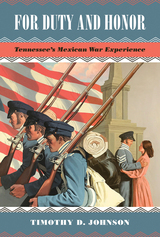 For Duty and Honor: Tennessee's Mexican War Experience
Timothy D. Johnson
University of Tennessee Press, 2018 The outbreak of the American Civil War was destined to cast a long shadow over the earlier, shorter Mexican-American War (1846—1848), as evidenced by today’s relatively slight historiography on the conflict. As for Tennessee’s role in the war, history remembers little more than its large contribution of volunteers and subsequent state moniker as “The Volunteer State.” Today, beliefs persist that the Mexican-American War was simply a colossal land grab for the United States in its pursuit of the doctrine of Manifest Destiny, and that Tennesseans enlisted to protect and expand the institution of slavery. As Timothy D. Johnson notes in For Duty and Honor, these stereotypes do not characterize the motives of Tennesseans. Through a succinct examination of journals, memoirs, and letters from the conflict, Johnson reveals that Tennesseans volunteered out of a sense of duty and honor—principles that were deeply embedded in the early national period. They also enlisted because of family and community expectations as well as a desire to demonstrate manhood and courage. In the process, Johnson provides much-needed historical and political context for the Mexican-American War. For Duty and Honor treats not only Tennessee’s unique role in the conflict, but also the postwar efforts by veterans to shape the war’s legacy. Using clear, accessible language and groundbreaking research, Johnson resurrects an all-but-forgotten moment in Tennessee’s rich history.
 For Emplacement: Political Ontology in Two Acts
Mario Blaser
Duke University Press, 2025 In For Emplacement, Mario Blaser proposes a new lens for contending with the momentous challenges facing the world, from anthropogenic climate change to rampant socioeconomic inequalities to the rise of neofascism. Blaser shows that the prevalent solutions to these problems—which often depend on intensifying globalization, technological development, and extractivism—only deepen these crises. Effectively addressing these issues, he suggests, might require grounding our ways of being in the specificities of place. Drawing on decades of ethnographic experience in South America and the Canadian subarctic, and engaging with material semiotics, Blaser recasts the fundamental political question of how to live together well as a cosmopolitical one: how to become emplaced with others, in divergence. Ultimately, he presents a political ontology where visions of the good life oriented to the specificities of place guide us through the promises and challenges that a journey toward emplacement holds.
For Faith and Fortune: The Education of Catholic Immigrants in Detroit, 1805-1925
JoEllen McNergney Vinyard
University of Illinois Press, 1998 Even before the massive European immigrations of the nineteenth and early twentieth centuries, Detroit had a tradition of Catholicism. Multiple immigrant groups became part of the city and considered it important to educate their daughters as well as their sons within the Church.
JoEllen McNergney Vinyard's comprehensive examination of parochial education in Detroit within the broader context of that city's urbanization patterns yields a richly detailed addition to our understanding of the European immigrant experience.
For Faith and Fortune will be of interest to historians and scholars of urban studies, particularly immigration, schooling, and the Catholic experience.
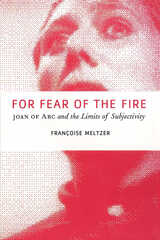 For Fear of the Fire: Joan of Arc and the Limits of Subjectivity
Françoise Meltzer
University of Chicago Press, 2001 Why are contemporary secular theorists so frequently drawn to saints, martyrs, and questions of religion? Why has Joan of Arc fascinated some of the most important thinkers of the twentieth century? In a book that faces crucial issues in both critical and feminist inquiry, Françoise Meltzer uses the story of Joan as a guide for reading the postmodern nostalgia for a body that is intact and transparent. She argues that critics who place excessive emphasis on opposition and difference remain blind to their nostalgia for the pre-Cartesian idea that the body and mind are the same.
Engaging a number of theorists, and alternating between Joan's historical and cultural context, Meltzer also explores the ways in which postmodern thinkers question subjectivity. She argues that the way masculine subjects imagine Joan betrays their fear of death and necessitates the role of women as cultural others: enigmatic, mysterious, dark, and impossible. As such, Joan serves as a useful model of the limits and risks of subjectivity. For Meltzer, she is both the first modern and the last medieval figure. From the ecclesial jury that burned her, to the theorists of today who deny their attraction to the supernatural, the philosophical assumptions that inform Joan's story, as Meltzer ultimately shows, have changed very little.
For Freedom's Sake: The Life of Fannie Lou Hamer
Chana Kai Lee
University of Illinois Press, 1999 The youngest of twenty children of sharecroppers in rural Mississippi, Fannie Lou Hamer witnessed throughout her childhood the white cruelty, political exclusion, and relentless economic exploitation that defined African American existence in the Delta. In this intimate biography, Chana Kai Lee documents Hamer's lifelong crusade to empower the poor through collective action, her rise to national prominence as a civil rights activist, and the personal costs of her ongoing struggle to win a political voice and economic self-sufficiency for blacks in the segregated South. Lee looks at Hamer's early work as a field secretary for the Student Nonviolent Coordinating Committee in Mississippi, her dramatic appearance at the 1964 Democratic National Convention, and her ongoing work as a militant grassroots leader in her own community.
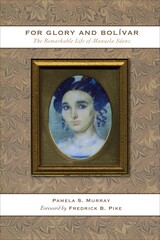 For Glory and Bolívar: The Remarkable Life of Manuela Sáenz
By Pamela S. Murray
University of Texas Press, 2008 She was a friend, lover, and confidante of charismatic Spanish American independence hero Simón Bolívar and, after her death, a nationalist icon in her own right. Yet authors generally have chosen either to romanticize Manuela Sáenz or to discount her altogether. For Glory and Bolivar: The Remarkable of Life of Manuela Sáenz, by contrast, offers a comprehensive and clear-eyed biography of her. Based on unprecedented archival research, it paints a vivid portrait of the Quito-born "Libertadora," revealing both an exceptional figure and a flesh-and-blood person whose life broadly reflected the experiences of women during Spanish America's turbulent Age of Revolution. Already married at the time of her meeting with the famous Liberator, Sáenz abandoned her husband in order to become not only Bolívar's romantic companion, but also his official archivist, a member of his inner circle, and one of his most loyal followers. She played a central role in Spanish South America's independence drama and eventually in developments leading to the consolidation of new nations. Pamela Murray, for the first time, closely examines Sáenz's political trajectory including her vital, often-overlooked years in exile. She exposes the myths that still surround her. She offers, in short, a nuanced and much-needed historical perspective, one that balances recognition of Sáenz's uniqueness with awareness of the broader forces that shaped this dynamic nineteenth-century woman.
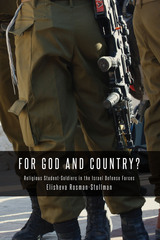 For God and Country?: Religious Student-Soldiers in the Israel Defense Forces
By Elisheva Rosman-Stollman
University of Texas Press, 2014 In many modern armies the religious soldier is suspect. Civilians and officers alike wonder if such a soldier might represent a potential fifth column. This concern is especially prominent in the public discourse over the presence of religious Orthodox Jews serving in the Israel Defense Forces. Will they obey their commanding officer or their rabbi? With research collected over almost a decade, including hundreds of hours of interviews, Elisheva Rosman examines this question of loyalties and reveals how religious soldiers negotiate a place for themselves in an institution whose goals and norms sometimes conflict with those of Orthodox Judaism. For God and Country? focuses on the pre-service study programs available to religious conscripts. Many journalists and scholars in Israel are suspicious of the student-soldiers who participate in these programs, but in fact, as Rosman’s research demonstrates, the pre-service study programs serve as mediating structures between the demands of Religious Zionism and the demands of the Israel Defense Forces and do not encourage their students to disobey orders. This was especially apparent during the disengagement from Gaza in 2005. Many in Israeli society predicted student-soldiers would defy their orders, per the instruction of their religious leaders, but this did not happen as expected. In high profile cases such as this and in matters encountered daily by religious soldiers—the mixing of the sexes, for instance—Rosman has discovered that the pre-service study programs can successfully serve as agents of civil society, both able to curb the military’s efforts to meddle in civilian affairs and vice versa.
 For I Have Sinned: The Rise and Fall of Catholic Confession in America
James M. O'Toole
Harvard University Press, 2025 The remarkable story of how confession became a defining rite for American Catholics—and then, beginning in the 1970s, all but disappeared.
For generations, American Catholics went faithfully to confession, admitting their sins to a priest and accepting through him God’s forgiveness. The sacrament served as a distinctive marker of Catholic identity, shaping parishioners’ views of their relationship to God, their neighbors, and the wider world. But starting in the 1970s, many abandoned confession altogether. Focusing on the experiences of both laypeople and priests, James M. O’Toole reconstructs the history of confession’s steady rise—and dramatic fall—among American Catholics.
In the early United States, the Catholic Church grew rapidly—and with it, confession’s centrality. Although the sacrament was practiced unevenly for much of the nineteenth century, frequent confession became common by the early twentieth. Both priests and parishioners understood confession as a ritual crucial for the soul, while on a social level, it established Catholic distinctiveness within a largely Protestant country. Today, however, even faithful Catholics seldom confess. The reasons for this change, O’Toole reveals, include the emergence of psychology and other forms of counseling; the Church’s stance against contraception, which alienated many parishioners; and a growing sense of confession’s inability to confront social problems like structural racism, poverty, and sexism. Meanwhile, increasing recognition of sexual abuse within the Church further undermined trust in clergy as confessors.
Sensitively attuned to the historical importance of confession, For I Have Sinned also suggests that, if the sacrament no longer serves the needs of US Catholics, the Church and its members might find new ways to express their ideals in the twenty-first century.
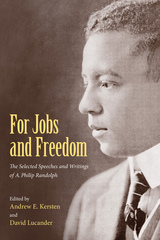 For Jobs and Freedom: Selected Speeches and Writings of A. Philip Randolph
Andrew E. Kersten
University of Massachusetts Press, 2014 As the head of the Brotherhood of Sleeping Car Porters and a tireless advocate for civil rights, A. Philip Randolph (1889–1979) served as a bridge between African Americans and the labor movement. During a public career that spanned more than five decades, he was a leading voice in the struggle for black freedom and social justice, and his powerful words inspired others to join him.
This volume documents Randolph's life and work through his own writings. The editors have combed through the files of libraries, manuscript collections, and newspapers, selecting more than seventy published and unpublished pieces that shed light on Randolph's most significant activities. The book is organized thematically around his major interests—dismantling workplace inequality, expanding civil rights, confronting racial segregation, and building international coalitions. The editors provide a detailed biographical essay that helps to situate the speeches and writings collected in the book. In the absence of an autobiography, this volume offers the best available presentation of Randolph's ideas and arguments in his own words.
 For Labor, Race, and Liberty: George Edwin Taylor, His Historic Run for the White House, and the Making of Independent Black Politics
Bruce L. Mouser
University of Wisconsin Press, 2010 More than one hundred years before Barack Obama, George Edwin Taylor made presidential history. Born in the antebellum South to a slave and a freed woman, Taylor became the first African American ticketed as a political party’s nominee for president of the United States, running against Theodore Roosevelt in 1904.
Orphaned as a child at the peak of the Civil War, Taylor spent several years homeless before boarding a Mississippi riverboat that dropped him in La Crosse, Wisconsin. Taken in by an African American farm family, Taylor attended a private school and eventually rose to prominence as the owner/editor of a labor newspaper and as a vocal leader in Wisconsin’s People’s Party. At a time when many African Americans felt allegiance to the Republican Party for its support of abolition, Taylor’s sympathy with the labor cause drew him first to the national Democratic Party and then to an African American party, the newly formed National Liberty Party, which in 1904 named him its presidential candidate. Bruce L. Mouser follows Taylor’s life and career in Arkansas, Illinois, Wisconsin, Iowa, and Florida, giving life to a figure representing a generation of African American idealists whose initial post-slavery belief in political and social equality in America gave way to the despair of the Jim Crow decades that followed.
Best Books for Special Interests, selected by the American Association for School Libraries Best Books for Professional Use, selected by the American Association for School Libraries Best Books for General Audiences, selected by the Public Library Association Second Place, Biography, Society of Midland Authors
Honorable Mention, Benjamin F. Shambough Award, the State Historical Society of Iowa
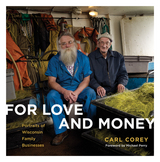 For Love and Money: Portraits of Wisconsin Family Businesses
Carl Corey
Wisconsin Historical Society Press, 2014 In his follow-up to Tavern League: Portraits of Wisconsin Bars, Carl Corey turns his camera on Wisconsin family-owned businesses in existence fifty years or longer. The businesses portrayed here—bakeries and barbecue joints, funeral homes and furniture builders, cheesemakers, fishermen, ferry boat drivers—have survived against all the odds, weathering tough economic times and big-business competition. The owners are loyal to their employees, their families, and themselves. And they are integral to their local economies and social fabric. The services and goods they provide are usually for neighbors and friends. Generations serve generations, creating lasting relationships and strong, vibrant neighborhoods and rural communities. In For Love and Money, Carl Corey provides indelible glimpses of an increasingly endangered way of life. The Museum of Wisconsin Art’s Graham Reid has said, “As current and future generations come and go, these pictures will survive in the hands of the subjects, collectors, museums, and galleries. Will the businesses featured enjoy a similar longevity? Only time will tell, and we can only watch and hope, but Carl Corey has ensured that they will not be forgotten.”
 For Love of Insects
Thomas Eisner
Harvard University Press, 2005 Imagine beetles ejecting defensive sprays as hot as boiling water; female moths holding their mates for ransom; caterpillars disguising themselves as flowers by fastening petals to their bodies; termites emitting a viscous glue to rally fellow soldiers--and you will have entered an insect world once beyond imagining, a world observed and described down to its tiniest astonishing detail by Thomas Eisner. The story of a lifetime of such minute explorations, For Love of Insects celebrates the small creatures that have emerged triumphant on the planet, the beneficiaries of extraordinary evolutionary inventiveness and unparalleled reproductive capacity.
To understand the success of insects is to appreciate our own shortcomings, Eisner tells us, but never has a reckoning been such a pleasure. Recounting exploits and discoveries in his lab at Cornell and in the field in Uruguay, Australia, Panama, Europe, and North America, Eisner time and again demonstrates how inquiry into the survival strategies of an insect leads to clarifications beyond the expected; insects are revealed as masters of achievement, forms of life worthy of study and respect from even the most recalcitrant entomophobe. Filled with descriptions of his ingenious experiments and illustrated with photographs unmatched for their combination of scientific content and delicate beauty, Eisner's book makes readers participants in the grand adventure of discovery on a scale infinitesimally small, and infinitely surprising.
For Love of Lakes
Darby Nelson
Michigan State University Press, 2011 America has more than 130,000 lakes of significant size. Ninety percent of all Americans live within fifty miles of a lake, and our 1.8 billion trips to watery places make them our top vacation choice. Yet despite this striking popularity, more than 45 percent of surveyed lakes and 80 percent of urban lakes do not meet water quality standards. For Love of Lakes weaves a delightful tapestry of history, science, emotion, and poetry for all who love lakes or enjoy nature writing. For Love of Lakes is an affectionate account documenting our species’ long relationship with lakes—their glacial origins, Thoreau and his environmental message, and the major perceptual shifts and advances in our understanding of lake ecology. This is a necessary and thoughtful book that addresses the stewardship void while providing improved understanding of our most treasured natural feature.
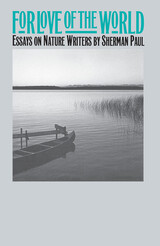 For Love of the World: Essays on Nature Writers
Sherman Paul
University of Iowa Press, 1992 Along with poets, philosophers, and deep ecologists, nature writers—who may be something of all three—address the world alienation of Western civilization. By example as well as with words, they teach us to turn from the self to the world, from ego to ecos.In these deeply felt meditative essays, Sherman Paul contemplates the cosmological homecoming of nature writers who show us how to reenter the world, participate in it, and recover respect for it. In For Love of the World Sherman Paul considers Thoreau, John Muir, and Aldo Leopold, major writers in the American tradition of nature writing; Henry Beston and Loren Eiseley, writers not yet so canonical; and Richard Nelson and Barry Lopez, our estimable contemporaries. Paul's meditative mode follows the practice of naturalists who enter the field, come into the open, and relate their immediate experiences. In the most primary and direct way, his essays belong to our moment in history when nothing is more essential than our reattachment to earthly existence. They will reawaken our love of the world—the necessary eros of ecos—and our wonder at and gratitude for being.
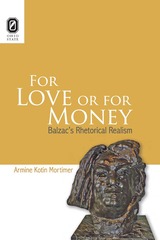 For Love or for Money: Balzac's Rhetorical Realism
Armine Kotin Mortimer
Ohio State University Press, 2011 Everyone agrees that Balzac is a realistic writer, but what do we actually mean when we say that? This book examines the richness and variety of Balzac’s approaches to realism, employing several different interpretive methods. Taking love and money as the “Prime Movers” of the world of La Comédie humaine, twenty-one chapters provide detailed analyses of the many strategies by which the writing forges the powerful impression of reality, the construction we famously think of as Balzacian realism. Each chapter sets the methods and aims of its analysis, with particular attention to the language that conveys the sense of reality. Plots, devices, or interpretive systems (including genealogies) function as images or reflections of how the novels make their meanings. The analyses converge on the central point: how did Balzac invent realism? No less than this fundamental question lies behind the interpretations this book provides, a question to which the conclusion provides a full answer. A major book in English devoted entirely to Balzac was overdue. Here is the American voice of Balzac studies, an engaging, insightful, and revealing excursion among the masterworks of one of the most important authors of all time.
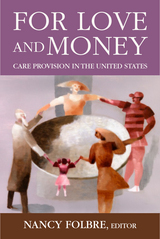 For Love or Money: Care Provision in the United States
Nancy Folbre
Russell Sage Foundation, 2013 As women moved into the formal labor force in large numbers over the last forty years, care work – traditionally provided primarily by women – has increasingly shifted from the family arena to the market. Child care, elder care, care for the disabled, and home care now account for a growing segment of low-wage work in the United States, and demand for such work will only increase as the baby boom generation ages. But the expanding market provision of care has created new economic anxieties and raised pointed questions: Why do women continue to do most care work, both paid and unpaid? Why does care work remain low paid when the quality of care is so highly valued? How effective and equitable are public policies toward dependents in the United States? In For Love and Money, an interdisciplinary team of experts explores the theoretical dilemmas of care provision and provides an unprecedented empirical overview of the looming problems for the care sector in the United States. Drawing on diverse disciplines and areas of expertise, For Love and Money develops an innovative framework to analyze existing care policies and suggest potential directions for care policy and future research. Contributors Paula England, Nancy Folbre, and Carrie Leana explore the range of motivations for caregiving, such as familial responsibility or limited job prospects, and why both love and money can be efficient motivators. They also examine why women tend to specialize in the provision of care, citing factors like job discrimination, social pressure, or the personal motivation to provide care reported by many women. Suzanne Bianchi, Nancy Folbre, and Douglas Wolf estimate how much unpaid care is being provided in the United States and show that low-income families rely more on unpaid family members for their child and for elder care than do affluent families. With low wages and little savings, these families often find it difficult to provide care and earn enough money to stay afloat. Candace Howes, Carrie Leana and Kristin Smith investigate the dynamics within the paid care sector and find problematic wages and working conditions, including high turnover, inadequate training and a “pay penalty” for workers who enter care jobs. These conditions have consequences: poor job quality in child care and adult care also leads to poor care quality. In their chapters, Janet Gornick, Candace Howes and Laura Braslow provide a systematic inventory of public policies that directly shape the provision of care for children or for adults who need personal assistance, such as family leave, child care tax credits and Medicaid-funded long-term care. They conclude that income and variations in states’ policies are the greatest factors determining how well, and for whom, the current system works. Despite the demand for care work, very little public policy attention has been devoted to it. Only three states, for example, have enacted paid family leave programs. Paid or unpaid, care costs those who provide it. At the heart of For Love and Money is the understanding that the quality of care work in the United States matters not only for those who receive care but also for society at large, which benefits from the nurturance and maintenance of human capabilities. As care work gravitates from the family to the formal economy, this volume clarifies the pressing need for America to fundamentally rethink its care policies and increase public investment in this increasingly crucial sector.
 For Might and Right: Cold War Defense Spending and the Remaking of American Democracy
Michael Brenes
University of Massachusetts Press, 2020 How did the global Cold War influence American politics at home? For Might and Right traces the story of how Cold War defense spending remade participatory politics, producing a powerful and dynamic political coalition that reached across party lines. This “Cold War coalition” favored massive defense spending over social welfare programs, bringing together a diverse array of actors from across the nation, including defense workers, community boosters, military contractors, current and retired members of the armed services, activists, and politicians. Faced with neoliberal austerity and uncertainty surrounding America's foreign policy after the 1960s, increased military spending became a bipartisan solution to create jobs and stimulate economic growth, even in the absence of national security threats.
Using a rich array of archival sources, Michael Brenes draws important connections between economic inequality and American militarism that enhance our understanding of the Cold War's continued impact on American democracy and the resilience of the military-industrial complex, up to the age of Donald Trump.
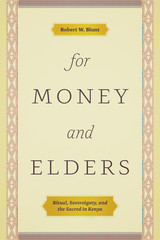 For Money and Elders: Ritual, Sovereignty, and the Sacred in Kenya
Robert W. Blunt
University of Chicago Press, 2019 Many observers of Kenya’s complicated history see causes for concern, from the use of public office for private gain to a constitutional structure historically lopsided towards the executive branch. Yet efforts from critics and academics to diagnose the country’s problems do not often consider what these fiscal and political issues mean to ordinary Kenyans. How do Kenyans express their own political understanding, make sense of governance, and articulate what they expect from their leaders?
In For Money and Elders, Robert W. Blunt addresses these questions by turning to the political, economic, and religious signs in circulation in Kenya today. He examines how Kenyans attempt to make sense of political instability caused by the uncertainty of authority behind everything from currency to title deeds. When the symbolic order of a society is up for grabs, he shows, violence may seem like an expedient way to enforce the authority of signs. Drawing on fertile concepts of sovereignty, elderhood, counterfeiting, acephaly, and more, Blunt explores phenomena as diverse as the destabilization of ritual “oaths,” public anxieties about Satanism with the advent of democratic reform, and mistrust of official signs. The result is a fascinating glimpse into Kenya’s past and present and a penetrating reflection on meanings of violence in African politics.
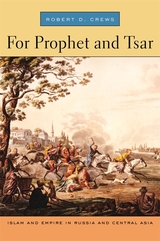 For Prophet and Tsar: Islam and Empire in Russia and Central Asia
Robert D. Crews
Harvard University Press, 2009 Russia occupies a unique position in the Muslim world. Unlike any other non-Islamic state, it has ruled Muslim populations for over five hundred years. Though Russia today is plagued by its unrelenting war in Chechnya, Russia’s approach toward Islam once yielded stability. In stark contrast to the popular “clash of civilizations” theory that sees Islam inevitably in conflict with the West, Robert D. Crews reveals the remarkable ways in which Russia constructed an empire with broad Muslim support.
In the eighteenth century, Catherine the Great inaugurated a policy of religious toleration that made Islam an essential pillar of Orthodox Russia. For ensuing generations, tsars and their police forces supported official Muslim authorities willing to submit to imperial directions in exchange for defense against brands of Islam they deemed heretical and destabilizing. As a result, Russian officials assumed the powerful but often awkward role of arbitrator in disputes between Muslims. And just as the state became a presence in the local mosque, Muslims became inextricably integrated into the empire and shaped tsarist will in Muslim communities stretching from the Volga River to Central Asia.
For Prophet and Tsar draws on police and court records, and Muslim petitions, denunciations, and clerical writings—not accessible prior to 1991—to unearth the fascinating relationship between an empire and its subjects. As America and Western Europe debate how best to secure the allegiances of their Muslim populations, Crews offers a unique and critical historical vantage point.
 For René Girard: Essays in Friendship and in Truth
Sandor Goodhart
Michigan State University Press, 2009 In his explorations of the relations between the sacred and violence, René Girard has hit upon the origin of culture—the way culture began, the way it continues to organize itself. The way communities of human beings structure themselves in a manner that is different from that of other species on the planet.
Like Albert Einstein, Sigmund Freud, Émile Durkheim, Martin Buber, or others who have changed the way we think in the humanities or in the human sciences, Girard has put forth a set of ideas that have altered our perceptions of the world in which we function. We will never be able to think the same way again about mimetic desire, about the scapegoat mechanism, and about the role of Jewish and Christian scripture in explaining sacrifice, violence, and the crises from which our culture has been born.
The contributions fall into roughly four areas of interpretive work: religion and religious study; literary study; the philosophy of social science; and psychological studies.
The essays presented here are offered as "essays" in the older French sense of attempts (essayer) or trials of ideas, as indeed Girard has tried out ideas with us. With a conscious echo of Montaigne, then, this hommage volume is titled Essays in Friendship and in Truth.
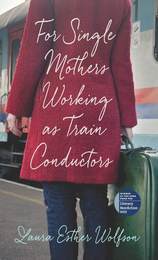 For Single Mothers Working as Train Conductors
Laura Esther Wolfson
University of Iowa Press, 2018 Laura Esther Wolfson’s literary debut draws on years of immersion in the Russian and French languages; struggles to gain a basic understanding of Judaism, its history, and her place in it; and her search for a form to hold the stories that emerge from what she has lived, observed, overheard, and misremembered. In “Proust at Rush Hour,” when her lungs begin to collapse and fail, forcing her to give up an exciting and precarious existence as a globetrotting simultaneous interpreter, she seeks consolation by reading Proust in the original while commuting by subway to a desk job that requires no more than a minimal knowledge of French. In “For Single Mothers Working as Train Conductors” she gives away her diaphragm and tubes of spermicidal jelly to a woman in the Soviet Union who, with two unwanted pregnancies behind her, needs them more than she does. “The Husband Method” has her translating a book on Russian obscenities and gulag slang during the dissolution of her marriage to the Russian-speaker who taught her much of what she knows about that language. In prose spangled with pathos and dusted with humor, Wolfson transports us to Paris, the Republic of Georgia, upstate New York, the Upper West Side, and the corridors of the United Nations, telling stories that skewer, transform, and inspire.
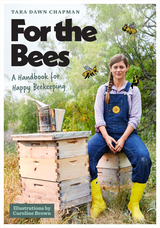 For the Bees: A Handbook for Happy Beekeeping
Tara Dawn ChapmanIllustrations by Caroline Brown
University of Texas Press, 2024 A handbook for what to expect the first year of beekeeping and beyond. The path to becoming a successful beekeeper begins with a deep understanding of the bees themselves. Taking an approach that is both holistic and practical, Tara Chapman, founder and operator of Austin’s beloved Two Hives Honey, begins with a primer on honey bee biology and nutrition as well as beehive architecture. (Did you ever wonder why honey combs are composed of tiny hexagons?) A little scientific knowledge goes a long way: a beekeeper who understands how these fascinating creatures work will be better equipped to recognize a particular colony’s needs, make sound decisions when the unexpected happens, and adapt their care regimen to changing conditions. Moving beyond the basics, Chapman shows potential beekeepers how to spot pests and diseases; manage swarms (those bees aren’t angry; they’re just looking for a good home); and, of course, harvest delicious homegrown honey. Imbued with the joy of the beekeeping journey, For the Bees provides practical visual explanations through appealing illustrations, that, alongside Chapman’s own stories from the bee yard, share the charms of these essential insects.
For The Birds: An Uncommon Guide
Laura Erickson
University of Minnesota Press, 2001 In 365 day-by-day sketches, Laura Erickson brings more than 250 birds right into your living room-from rare hawk owls to elusive sedge wrens to plastic lawn flamingos. Light-hearted, yet authoritative, For the Birds is brimming with fascinating birdlore. Did you know that you can mail three chickadees with a single stamp? That Black-billed Cuckoos flourish on a diet of army worms? That winter finches are especially attracted to feeders offering grit and eggshells? Enjoy Laura’s entertaining observations and record your own in For the Birds: An Uncommon Guide.
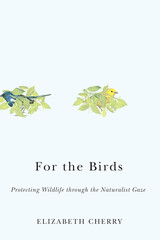 For the Birds: Protecting Wildlife through the Naturalist Gaze
Elizabeth Cherry
Rutgers University Press, 2019 2020 Award for Distinguished Book from the Animals & Society Section of the American Sociological Association
One in five people in the United States is a birdwatcher, yet the popular understanding of birders reduces them to comical stereotypes, obsessives who only have eyes for their favorite rare species. In real life, however, birders are paying equally close attention to the world around them, observing the devastating effects of climate change and mass extinction, while discovering small pockets of biodiversity in unexpected places.
For the Birds offers readers a glimpse behind the binoculars and reveals birders to be important allies in the larger environmental conservation movement. With a wealth of data from in-depth interviews and over three years of observing birders in the field, environmental sociologist Elizabeth Cherry argues that birders learn to watch wildlife in ways that make an invaluable contribution to contemporary conservation efforts. She investigates how birders develop a “naturalist gaze” that enables them to understand the shared ecosystem that intertwines humans and wild animals, an appreciation that motivates them to participate in citizen science projects and wildlife conservation.
 For the Children?: Protecting Innocence in a Carceral State
Erica R. Meiners
University of Minnesota Press, 2016 “Childhood has never been available to all.” In her opening chapter of For the Children?, Erica R. Meiners stakes the claim that childhood is a racial category often unavailable to communities of color. According to Meiners, this is glaringly evident in the U.S. criminal justice system, where the differentiation between child and adult often equates to access to stark disparities. And what is constructed as child protection often does not benefit many young people or their communities. Placing the child at the heart of the targeted criminalization debate, For the Children? considers how perceptions of innocence, the safe child, and the future operate in service of the prison industrial complex. The United States has the largest prison population in the world, with incarceration and policing being key economic tools to maintain white supremacist ideologies. Meiners examines the school-to-prison pipeline and the broader prison industrial complex in the United States, arguing that unpacking child protection is vital to reducing the nation’s reliance on its criminal justice system as well as building authentic modes of public safety. Rethinking the meanings and beliefs attached to the child represent a significant and intimate thread of the work to dismantle facets of the U.S. carceral state. Taking an interdisciplinary approach and building from a scholarly and activist platform, For the Children? engages fresh questions in the struggle to build sustainable and flourishing worlds without prisons.
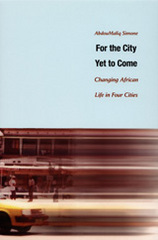 For the City Yet to Come: Changing African Life in Four Cities
AbdouMaliq Simone
Duke University Press, 2004 Among government officials, urban planners, and development workers, Africa’s burgeoning metropolises are frequently understood as failed cities, unable to provide even basic services. Whatever resourcefulness does exist is regarded as only temporary compensation for fundamental failure. In For the City Yet to Come, AbdouMaliq Simone argues that by overlooking all that does work in Africa’s cities, this perspective forecloses opportunities to capitalize on existing informal economies and structures in development efforts within Africa and to apply lessons drawn from them to rapidly growing urban areas around the world. Simone contends that Africa’s cities do work on some level and to the extent that they do, they function largely through fluid, makeshift collective actions running parallel to proliferating decentralized local authorities, small-scale enterprises, and community associations. Drawing on his nearly fifteen years of work in African cities—as an activist, teacher, development worker, researcher, and advisor to ngos and local governments—Simone provides a series of case studies illuminating the provisional networks through which most of Africa’s urban dwellers procure basic goods and services. He examines informal economies and social networks in Pikine, a large suburb of Dakar, Senegal; in Winterveld, a neighborhood on the edge of Pretoria, South Africa; in Douala, Cameroon; and among Africans seeking work in Jeddah, Saudi Arabia. He contextualizes these particular cases through an analysis of the broad social, economic, and historical conditions that created present-day urban Africa. For the City Yet to Come is a powerful argument that any serious attempt to reinvent African urban centers must acknowledge the particular history of these cities and incorporate the local knowledge reflected in already existing informal urban economic and social systems.
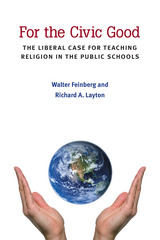 For the Civic Good: The Liberal Case for Teaching Religion in the Public Schools
Walter Feinberg and Richard A. Layton
University of Michigan Press, 2014 Why teach about religion in public schools? What educational value can such courses potentially have for students? In For the Civic Good, Walter Feinberg and Richard A. Layton offer an argument for the contribution of Bible and world religion electives. The authors argue that such courses can, if taught properly, promote an essential aim of public education: the construction of a civic public, where strangers engage with one another in building a common future. The humanities serve to awaken students to the significance of interpretive and analytic skills, and religion and Bible courses have the potential to add a reflective element to these skills. In so doing, students awaken to the fact of their own interpretive framework and how it influences their understanding of texts and practices. The argument of the book is developed by reports on the authors’ field research, a two-year period in which they observed religion courses taught in various public high schools throughout the country, from the “Bible Belt” to the suburban parkway. They document the problems in teaching religion courses in an educationally appropriate way, but also illustrate the argument for a humanities-based approach to religion by providing real classroom models of religion courses that advance the skills critical to the development of a civic public.
For the Culture: Hip-Hop and the Fight for Social Justice
Lakeyta M. Bonnette-Bailey and Adolphus G. Belk, Jr., Editors
University of Michigan Press, 2022 For the Culture: Hip-Hop and the Fight for Social Justice documents and analyzes the ways in which Hip-Hop music, artists, scholars, and activists have discussed, promoted, and supported social justice challenges worldwide. Drawing from diverse approaches and methods, the contributors in this volume demonstrate that rap music can positively influence political behavior and fight to change social injustices, and then zoom in on artists whose work has accomplished these ends. The volume explores topics including education and pedagogy; the Black Lives Matter movement; the politics of crime, punishment, and mass incarceration; electoral politics; gender and sexuality; and the global struggle for social justice. Ultimately, the book argues that hip hop is much more than a musical genre or cultural form: hip hop is a resistance mechanism.
For the Director: Research Essays in Honor of James B. Griffin
Edited by Charles E. Cleland
University of Michigan Press, 1977 In 1975, James B. Griffin retired as director of the University of Michigan Museum of Anthropology. During his three decades as director and professor, he had become one of the leading archaeologists in North America and had tremendous influence over the next generation of archaeological research. To honor the man and his work, nineteen scholars contributed essays to this volume. Contributors include Ted Bank, Richard Wilkinson, Donald Janzen, George Quimby, and H. Martin Wobst. Richard Ford and Volney Jones compiled a guide to Griffin’s extensive published works.
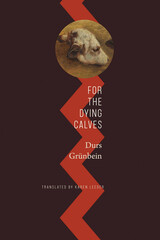 For the Dying Calves: Beyond Literature: Oxford Lectures
Durs Grünbein
Seagull Books, 2021 Poetically written and originally given as lectures, this is a moving essay collection from Durs Grünbein.
In his four Lord Weidenfeld Lectures held in Oxford in 2019, German poet Durs Grünbein dealt with a topic that has occupied his mind ever since he began to perceive his own position within the past of his nation, his linguistic community, and his family: How is it possible that history can determine the individual poetic imagination and segregate it into private niches? Shouldn’t poetry look at the world with its own sovereign eyes instead?
In the form of a collage or “photosynthesis,” in image and text, Grünbein lets the fundamental opposition between poetic license and almost overwhelming bondage to history appear in an exemplary way. From the seeming trifle of a stamp with the portrait of Adolf Hitler, he moves through the phenomenon of the “Führer’s streets” and into the inferno of aerial warfare. In the end, Grünbein argues that we are faced with the powerlessness of writing and the realization, valid to this day, that comes from confronting history. As he muses, “There is something beyond literature that questions all writing.”
 For the Good of Humanity: Ludwik Rajchman, Medical Statesman
Marta A. Balinska
Central European University Press, 1998 In this biography of Ludwik Rajchman, Marta A. Balinska paints a portrait of a true hero of our times. He was born in Poland in 1881 and was an exponent of humanitarian intervention and defender of colonized people, as adept in secret diplomacy as in organizing vast anti-epidemic campaigns. He inspired the creation of WHO and the foundation of UNICEF, of which he became the first chairman. Progressive but opposed to all dogmas, he was forced by McCarthyism to flee the U.S. and soon became an object of suspicion in the Soviet bloc, finding himself estranged from his beloved Poland. As the story of this remarkable life unfolds, the reader is given a behind-the-scenes glimpse of the major events that shaped the twentieth century. Using family archives and documentary sources from a dozen countries, the author brilliantly reconstructs the career of a man who was not only the first médecin sans frontiere but also an intellectual with an exceptional sense of the universal.
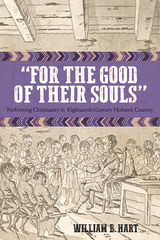 "For the Good of Their Souls": Performing Christianity in Eighteenth-Century Mohawk Country
William B. Hart
University of Massachusetts Press, 2020 In 1712, the Society for the Propagation of the Gospel in Foreign Parts opened its mission near present-day Albany, New York, and began baptizing residents of the nearby Mohawk village Tiononderoge, the easternmost nation of the Haudenosaunee (Iroquois) Confederacy. Within three years, about one-fifth of the Mohawks in the area began attending services. They even adapted versions of the service for use in private spaces, which potentially opened a door to an imagined faith community with the Protestants.
Using the lens of performance theory to explain the ways in which the Mohawks considered converting and participating in Christian rituals, historian William B. Hart contends that Mohawks who prayed, sang hymns, submitted to baptism, took communion, and acquired literacy did so to protect their nation's sovereignty, fulfill their responsibility of reciprocity, serve their communities, and reinvent themselves. Performing Christianity was a means of "survivance," a strategy for sustaining Mohawk life and culture on their terms in a changing world.
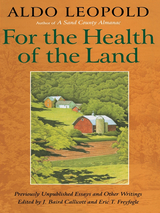 For the Health of the Land: Previously Unpublished Essays And Other Writings
Aldo Leopold; Edited by J. Baird Callicott and Eric T. Freyfogle; Foreword by Scott Russell Sanders
Island Press, 1999 Aldo Leopold's classic work A Sand County Almanac is widely regarded as one of the most influential conservation books of all time. In it, Leopold sets forth an eloquent plea for the development of a "land ethic" -- a belief that humans have a duty to interact with the soils, waters, plants, and animals that collectively comprise "the land" in ways that ensure their well-being and survival. For the Health of the Land, a new collection of rare and previously unpublished essays by Leopold, builds on that vision of ethical land use and develops the concept of "land health" and the practical measures landowners can take to sustain it. The writings are vintage Leopold -- clear, sensible, and provocative, sometimes humorous, often lyrical, and always inspiring. Joining them together are a wisdom and a passion that transcend the time and place of the author's life. The book offers a series of forty short pieces, arranged in seasonal "almanac" form, along with longer essays, arranged chronologically, which show the development of Leopold's approach to managing private lands for conservation ends. The final essay is a never before published work, left in pencil draft at his death, which proposes the concept of land health as an organizing principle for conservation. Also featured is an introduction by noted Leopold scholars J. Baird Callicott and Eric T. Freyfogle that provides a brief biography of Leopold and places the essays in the context of his life and work, and an afterword by conservation biologist Stanley A. Temple that comments on Leopold's ideas from the perspective of modern wildlife management. The book's conservation message and practical ideas are as relevant today as they were when first written over fifty years ago. For the Health of the Land represents a stunning new addition to the literary legacy of Aldo Leopold.
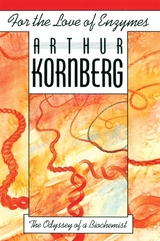 For the Love of Enzymes: The Odyssey of a Biochemist
Arthur Kornberg
Harvard University Press, 1989 In 1645 the Japanese samurai Musashi Miamoto wrote A Book of Five Rings, which described the attitudes necessary for individual success. Though he was a swordsman, his book was not limited to combat but addressed the much broader question of how to achieve excellence in life through study, discipline, and planning. It is still avidly read in Japan today. Arthur Kornberg’s book is a modern-day Book of Five Rings that replaces the medium of swordsmanship with that of biochemistry, particularly enzymology. As Kornberg describes his successive research problems, the challenges they presented, and the ultimate accomplishments that resulted, he provides us with a primer in the strategies needed to do scientific work of great significance. Moreover, these strategies are played out in the context of solving some of the great biochemical problems of the twentieth century.
The ability to manipulate and alter DNA fired a revolution that forever changed the nature of biology. Arthur Kornberg is a primary architect of that revolution, arguably one of the two or three most important biologists of this time. Prior to Kornberg, genetic information and later DNA were imbued by biologists with an almost vitalistic aura. Kornberg demonstrated that DNA is a molecule synthesized by enzymes, like all other chemical constituents of the cell. More important, he trained a school of scientists who focused on and discovered many of the enzymatic activities that act on DNA. It is these enzymes in particular that allow modern “genetic engineering.”
For the Love of Enzymes does not describe a single lucky or hard-won accomplishment. Rather, it is the story of thirty years of decisive campaigns, nearly all of which led to insights of major significance. In relating his story, Kornberg never avoids the difficult question of “why”: why he felt classical nutritional studies had reached a plateau, why he turned to enzymology as a discipline in which the important answers would be found, and why he believes the study of enzymes will grow ever more important as we face the new scientific frontier of brain function.
This book will challenge students of biology and chemistry at all levels who want to do important work rather than simply follow popular trends. It will also delight and inform readers who wish to understand how “real” science is done, and to learn of the values that guide one of our greatest researchers.
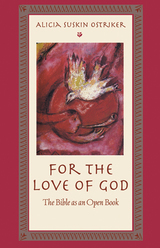 For the Love of God: The Bible as an Open Book
Ostriker, Alicia Suskin
Rutgers University Press, 2009 Quoting King Solomon’s famous prayer to God at the Temple in Jerusalem, “Behold, the heaven of heavens cannot contain thee; how much less this house that I have builded,” Alicia Suskin Ostriker posits a God who cannot be contained by dogma and doctrine. Troubled by the way the Bible has become identified in our culture with a monolithic authoritarianism, Ostriker focuses instead on the extraordinary variability of Biblical writing.
For the Love of God is a provocative and inspiring re-interpretation of six essential Biblical texts: The Song of Songs, the Book of Ruth, Psalms, Ecclesiastes, Jonah, and Job. In prose that is personal and probing, analytically acute and compellingly readable, Ostriker sees these writings as “counter-texts,” deviating from convention yet deepening and enriching the Bible, our images of God, and our own potential spiritual lives. Attempting to understand “some of the wildest, strangest, most splendid writing in Western tradition,” she shows how the Bible embraces sexuality and skepticism, boundary crossing and challenges to authority, how it illuminates the human psyche and mirrors our own violent times, and how it asks us to make difficult choices in the quest for justice.
For better or worse, our society is wedded to the Bible. But according to Talmud, “There is always another interpretation.” Ostriker demonstrates that the Bible, unlike its reputation, offers a plenitude of surprises.
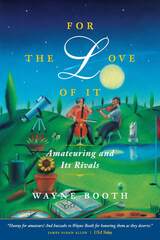 For the Love of It: Amateuring and Its Rivals
Wayne C. Booth
University of Chicago Press, 1999 For the Love of It is a story not only of one intimate struggle between a man and his cello, but also of the larger struggle between a society obsessed with success and individuals who choose challenging hobbies that yield no payoff except the love of it.
"If, in truth, Booth is an amateur player now in his fifth decade of amateuring, he is certainly not an amateur thinker about music and culture. . . . Would that all of us who think and teach and care about music could be so practical and profound at the same time."—Peter Kountz, New York Times Book Review
"[T]his book serves as a running commentary on the nature and depth of this love, and all the connections it has formed in his life. . . . The music, he concludes, has become part of him, and that is worth the price."—Clea Simon, Boston Globe
"The book will be read with delight by every well-meaning amateur who has ever struggled. . . . Even general readers will come away with a valuable lesson for living: Never mind the outcome of a possibly vain pursuit; in the passion that is expended lies the glory."—John von Rhein, Chicago Tribune
"Hooray for amateurs! And huzzahs to Wayne Booth for honoring them as they deserve. For the Love of It celebrates amateurism with genial philosophizing and pointed cultural criticism, as well as with personal reminiscences and self-effacing wit."—James Sloan Allen, USA Today
"Wayne Booth, the prominent American literary critic, has written the only sustained study of the interior experience of musical amateurism in recent years, For the Love of It. [It] succeeds as a meditation on the tension between the centrality of music in Booth's life, both inner and social, and its marginality. . . . It causes the reader to acknowledge the heterogeneity of the pleasures involved in making music; the satisfaction in playing well, the pride one takes in learning a difficult piece or passage or technique, the buzz in one's fingertips and the sense of completeness with the bow when the turn is done just right, the pleasure of playing with others, the comfort of a shared society, the joy of not just hearing, but making, the music, the wonder at the notes lingering in the air."—Times Literary Supplement
 For the Love of Mars: A Human History of the Red Planet
Matthew Shindell
University of Chicago Press, 2023 A tour of Mars in the human imagination, from ancient astrologers to modern explorers.
Mars and its secrets have fascinated and mystified humans since ancient times. For the Love of Mars surveys the red planet’s place in the human imagination, beginning with ancient astrologers and skywatchers and ending in our present moment of exploration and virtual engagement.
National Air and Space Museum curator Matthew Shindell describes how historical figures across eras and around the world have made sense of this mysterious planet. We meet Mayan astrologer priests who incorporated Mars into seasonal calendars and religious ceremonies, Babylonian astrologers who discerned bad omens, figures of the Scientific Revolution who struggled to comprehend Mars as a world, Victorian astronomers who sought signs of intelligent life, and twentieth- and twenty-first-century scientists who have established a technological presence on the planet’s surface. Along the way, we encounter writers and artists from each of these periods who took readers and viewers along on imagined journeys to Mars.
By focusing on the diverse human stories behind the telescopes and behind the robots we know and love, Shindell shows how Mars exploration has evolved in ways that have also expanded knowledge about other facets of the universe. Captained by an engaging and erudite expert, For the Love of Mars is a captivating voyage through time and space for anyone curious about Curiosity and the red planet.
 For the Love of Mike: More of the Best of Mike Royko
Mike Royko
University of Chicago Press, 2001 In 1999, the University of Chicago Press published a collection of Mike Royko's columns, entitled One More Time: The Best of Mike Royko. The response was immediate and overwhelming—readers almost instantly began asking when the second volume of Royko columns would appear. With more than a hundred vintage Royko columns and a foreword by Roger Ebert, For the Love of Mike was the answer.
Royko, a nationally syndicated Pulitzer Prize winner, wrote for three major Chicago newspapers in the course of his 34 years as a daily columnist. Chosen from more than 7,000 columns, For the Love of Mike brings back more than a hundred vintage Royko pieces-most of which have not appeared since their initial publication-for readers across the country to enjoy. This second collection includes Royko's riffs on the consequences of accepting a White House dinner invitation (not surprisingly, he turned it down); his explanation of the notorious Ex-Cub Factor in World Series play; and his befuddlement at a private screening of Beyond the Valley of the Dolls, to which he was invited by his pal Ebert, the screenplay's author. The new collection also illuminates Royko's favorite themes, topics he returned to again and again: his skewering of cultural trends, his love of Chicago, and his rage against injustice. By turns acerbic, hilarious, and deeply moving, Royko remains a writer of wit and passion who represents the best of urban journalism.
"To read these columns again is to have Mike back again, nudging, chuckling, wincing, deflating pomposity, sticking up for the little guy, defending good ideas against small-minded people," writes Roger Ebert in his foreword to the book. For the Love of Mike does indeed bring Mike back again, and until a Chicago newspaper takes up Ebert's suggestion that it begin reprinting each of Royko's columns, one a day, this collection will more than satisfy Royko's loyal readers.
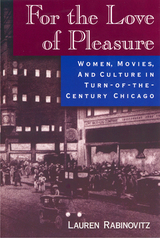 For the Love of Pleasure: Women, Movies, and Culture in Turn-of-the-Century Chicago
Rabinovitz, Lauren
Rutgers University Press, 1998 "One of the most readable books on early cinema I have ever encountered. . . . Rabinovitz ably brings together a wealth of information about the exciting era of social change that marked the beginning of U.S. cinema."
--Gaylyn Studlar, atuhor of This Mad Masquerade: Stardom and Masculinity in the Jazz Age
The period from the 1880s until the 1920s saw the making of a consumer society, the inception of the technological, economic, and social landscape in which we currently live. Cinema played a key role in the changing urban landscape. For working-class women, it became a refuge from the factory. For middle-class women, it presented a new language of sexual danger and pleasure. Women found greater freedom in big cities, entering the workforce in record numbers and moving about unchaperoned in public spaces. Turn-of-the-century Chicago surpassed even New York as a proving ground for pleasure and education, attracting women workers at three times the national rate. Using Chicago as a model, Lauren Rabinovitz analyzes the rich interplay among demographic, visual, historical, and theoretical materials of the period. She skillfully links cinema theory and women's studies for a fuller understanding of cultural history. She also demonstrates how cinema dramatically affected social conventions, ultimately shaping modern codes of masculinity and feminity.
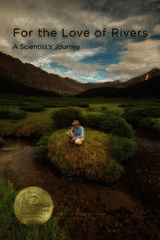 For the Love of Rivers: A Scientist's Journey
Kurt D. Fausch
Oregon State University Press, 2015 Rivers and streams supply our water and capture our imaginations. We seek the more pristine ones to fish or paddle, to hike along or simply sit and watch. But what is it we are seeing? What is essential about streams and rivers for us as humans?
In For the Love of Rivers, stream ecologist Kurt Fausch draws readers across the reflective surface of streams to view and ponder what is beneath, and how they work. While celebrating their beauty and mystery, he uses his many years of experience as a field biologist to explain the underlying science connecting these aquatic ecosystems to their streamside forests and the organisms found there—including humans.
For the Love of Rivers introduces readers to the life and work of Shigeru Nakano, a pioneering river ecologist who inspired other scientists around the world with his innovative research on stream-forest connections. Fausch takes readers along as he journeys to Japan, where he awakens to an unfamiliar culture, to Nakano, and his research.
Nakano’s life was abruptly ended in a tragic field accident, and his death was deeply mourned. Fausch joins Japanese and American colleagues to continue Nakano’s research legacy, learn everything they can about the effects that humans have on rivers, fish, and their intricate links with riparian zones, and share this knowledge with others.
More than a book about stream ecology, For the Love of Rivers is a celebration of the interconnectedness of life. It is an authoritative and accessible look at the science of rivers and streams, but it also ponders the larger questions of why rivers are important to humans, why it is in our nature to want to be near them, and what we can do now to ensure the future of these essential ecosystems.
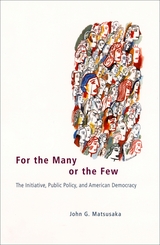 For the Many or the Few: The Initiative, Public Policy, and American Democracy
John G. Matsusaka
University of Chicago Press, 2004 Direct democracy is alive and well in the United States. Citizens are increasingly using initiatives and referendums to take the law into their own hands, overriding their elected officials to set tax, expenditure, and social policies. John G. Matsusaka's For the Many or the Few provides the first even-handed and historically based treatment of the subject.
Drawing upon a century of evidence, Matsusaka argues against the popular belief that initiative measures are influenced by wealthy special interest groups that neglect the majority view. Examining demographic, political, and opinion data, he demonstrates how the initiative process brings about systematic changes in tax and expenditure policies of state and local governments that are generally supported by the citizens. He concludes that, by and large, direct democracy in the form of the initiative process works for the benefit of the many rather than the few.
An unprecedented, comprehensive look at the historical, empirical, and theoretical components of how initiatives function within our representative democracy to increase political competition while avoiding the tyranny of the majority, For the Many or the Few is a most timely and definitive work.
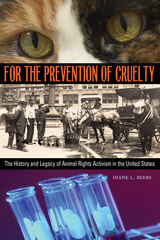 For the Prevention of Cruelty: The History and Legacy of Animal Rights Activism in the United States
Diane L. Beers
Ohio University Press, 2006 Animal rights. Those two words conjure diverse but powerful images and reactions. Some nod in agreement, while others roll their eyes in contempt. Most people fall somewhat uncomfortably in the middle, between endorsement and rejection, as they struggle with the profound moral, philosophical, and legal questions provoked by the debate. Today, thousands of organizations lobby, agitate, and educate the public on issues concerning the rights and treatment of nonhumans. For the Prevention of Cruelty is the first history of organized advocacy on behalf of animals in the United States to appear in nearly a half century. Diane Beers demonstrates how the cause has shaped and reshaped itself as it has evolved within the broader social context of the shift from an industrial to a postindustrial society. Until now, the legacy of the movement in the United States has not been examined. Few Americans today perceive either the companionship or the consumption of animals in the same manner as did earlier generations. Moreover, powerful and lingering bonds connect the seemingly disparate American Society for the Prevention of Cruelty to Animals of the nineteenth century and the People for the Ethical Treatment of Animals of today. For the Prevention of Cruelty tells an intriguing and important story that reveals society’s often changing relationship with animals through the lens of those who struggled to shepherd the public toward a greater compassion.
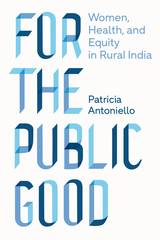 For the Public Good: Women, Health, and Equity in Rural India
Patricia Antoniello
Vanderbilt University Press, 2020 For the Public Good details the role of the Comprehensive Rural Health Project (CRHP), a groundbreaking, internationally recognized primary health care model that uses local solutions to solve intractable global health problems. Emphasizing equity and community participation, this grassroots approach recruits local women to be educated as village-based health workers. In turn, women village health workers collaborate to overcome the dominant double prejudices in local villages—caste and gender inequality.
In one generation, village health workers have progressed from child brides and sequestered wives to knowledgeable health practitioners, valued teachers, and community leaders. Through collective efforts, CRHP has reduced infant and maternal mortality, eliminated some endemic health problems, and advanced economic well-being in villages with women's cooperative lending groups.
This book describes how the recognition and elimination of embedded inequalities—in this case caste discrimination, gender subordination, and class injustice—promote health and well-being and collaboratively establish the public good.
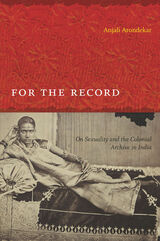 For the Record: On Sexuality and the Colonial Archive in India
Anjali Arondekar
Duke University Press, 2009 Anjali Arondekar considers the relationship between sexuality and the colonial archive by posing the following questions: Why does sexuality (still) seek its truth in the historical archive? What are the spatial and temporal logics that compel such a return? And conversely, what kind of “archive” does such a recuperative hermeneutics produce? Rather than render sexuality’s relationship to the colonial archive through the preferred lens of historical invisibility (which would presume that there is something about sexuality that is lost or silent and needs to “come out”), Arondekar engages sexuality’s recursive traces within the colonial archive against and through our very desire for access. The logic and the interpretive resources of For the Record arise out of two entangled and minoritized historiographies: one in South Asian studies and the other in queer/sexuality studies. Focusing on late colonial India, Arondekar examines the spectacularization of sexuality in anthropology, law, literature, and pornography from 1843 until 1920. By turning to materials and/or locations that are familiar to most scholars of queer and subaltern studies, Arondekar considers sexuality at the center of the colonial archive rather than at its margins. Each chapter addresses a form of archival loss, troped either in a language of disappearance or paucity, simulacrum or detritus: from Richard Burton’s missing report on male brothels in Karáchi (1845) to a failed sodomy prosecution in Northern India, Queen Empress v. Khairati (1884), and from the ubiquitous India-rubber dildos found in colonial pornography of the mid-to-late nineteenth century to the archival detritus of Kipling’s stories about the Indian Mutiny of 1857.
 For the Sake of Argument: Practical Reasoning, Character, and the Ethics of Belief
Eugene Garver
University of Chicago Press, 2004 What role does reason play in our lives? What role should it play? And are claims to rationality liberating or oppressive? For the Sake of Argument addresses questions such as these to consider the relationship between thought and character. Eugene Garver brings Aristotle's Rhetoric to bear on practical reasoning to show how the value of such thinking emerges when members of communities deliberate together, persuade each other, and are persuaded by each other. That is to say, when they argue.
Garver roots deliberation and persuasion in political friendship instead of a neutral, impersonal framework of justice. Through incisive readings of examples in modern legal and political history, from Brown v. Board of Education to the South African Truth and Reconciliation Commission, he demonstrates how acts of deliberation and persuasion foster friendship among individuals, leading to common action amid diversity. In an Aristotelian sense, there is a place for pathos and ethos in rational thought. Passion and character have as pivotal a role in practical reasoning as logic and language.
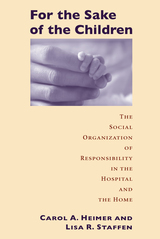 For the Sake of the Children: The Social Organization of Responsibility in the Hospital and the Home
Carol A. Heimer and Lisa R. Staffen
University of Chicago Press, 1998 For the Sake of the Children examines the social organization of responsibility by asking who takes responsibility for critically ill newborns. Drawing on medical records and interviews with parents and medical staff, the authors take us into two neonatal intensive care units, showing us the traumas of extreme medical measures and the sufferings of infants. The accounts are by turns heroic and disturbing as we see people trying to take charge of these infants' care, thinking about long-term plans, redefining their roles as adults and parents, and coping with sometimes awful contingencies.
Rather than treating responsibility as an ethical issue, the authors focus on how responsibility is socially produced and sustained. The authors ask: How do staff members encourage parents to take responsibility, but keep them from interfering in medical matters, and how do parents encourage staff vigilance when they are novices attempting to supervise the experts?
The authors conclude that it is not sufficient simply to be responsible individuals. Instead, we must learn how to be responsible in an organizational world, and organizations must learn how to support responsible individuals.
For the Sake of the Light: New and Selected Poems
Tom Sexton
University of Alaska Press, 2009 This collection of new and selected poems by the former poet laureate of Alaska, Tom Sexton, opens a door on the essence of life in Alaska and Maine. Sexton divides his year between the two states, and he captures here the small but powerful sensual details of day-to-day life in these contrasting, yet similar, environs. His carefully crafted verse distills the birch and aspen, lynx and ptarmigan, and the snow on high peaks. Through his poems we thrill to experience encounters with the wild, the seasons, and the sublime landscape. “His language is clear, without tricks or fancy moves, yet his directness is powerful, and the effects are human”—Paul Zimmer, Georgia Review
For the Scribe
David Wojahn
University of Pittsburgh Press, 2017 For the Scribe, the ninth collection by award-winning poet David Wojahn, continues his explorations of the interstices between the public and the private, the historical and the personal. Poems of recollection and elegy commingle and conjoin with poems which address larger matters of historical and ecological import. The subjects of extinction and apocalypse figure prominently and obsessively in these pages, both in short lyrics and in several lengthy sequences. The poems also evidence the mastery of technique for which Wojahn is renowned, whether he is writing in fixed forms or in free verse. For the Scribe is the most ambitious and searching collection thus far from a poet who has been a named finalist for the Pulitzer Prize in poetry, winner of the Lenore Marshall Prize from the Academy of American Poets, the O. B. Hardison Award from the Folger Shakespeare Library, and the William Carlos Williams Book Award.
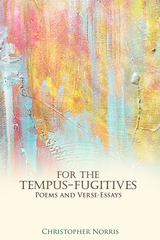 For the Tempus-Fugitives: Poems and Verse-Essays
Christopher Norris
Sussex Academic Press, 2022 In this latest collection of poems and verse-essays, Christopher Norris revisits many of the topics for which he is best known as a philosopher, literary theorist, and writer on music. Among them are the many-worlds metaphysics of Leibniz, the nature of subjective time-experience, the issue of poetic truth, the function of rhyme in poetry, the "theory wars" in literary studies, the augmented-fourth interval (or tritone), also known as the "devil in music," and musical minimalism approached from a critical or cultural-diagnostic standpoint. There are also some shorter, more "occasional" pieces including an epithalamion (wedding-poem) for the poet's daughter, a semi-fictive double sestina about police infiltration of activist groups, a savagely bawdy polemic imagined as addressed by the ancient Greek satirist Archilochus to his ex-fiance Neobule, and a number of shrewdly angled political poems with reference to events from the 1980s to the present. These pieces have the hallmark qualities of intellectual range, perceptive wit, and formal inventiveness that characterize Norris's verse-essays. They make a strong case for poetry as a vehicle for argument, dialogue, and open debate.
For the Wild Places: Profiles In Conservation
Janet Trowbridge Bohlen; Foreword by Vice President Al Gore
Island Press, 1993 For the Wild Places profiles five of the unsung heroes of the new discipline of conservation biology -- the front-line soldiers of the conservation movement who have dedicated their lives to saving endangered species and habitats. In addition to describing the day-to-day activities of the scientists, author Janet Bohlen explores the wider issues that are ultimately responsible for the success or failure of conservation efforts. In the course of her travels, she came to appreciate the complex interaction of local and global needs, and the reality of the political and social context in which all such efforts take place. In describing the scientists, their lives, and their work, she effectively conveys the fundamental importance and ever-present challenge of a life devoted to protecting the environment.
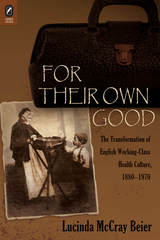 For Their Own Good: The Transformation of English Working-Class Health Culture, 1880–1970
Lucinda Mccray Beier
Ohio State University Press, 2008 In For Their Own Good Lucinda McCray Beier examines the interactions between working-class health culture and official provision of health services and medical care in three English communities between 1880 and 1970. Based on 239 oral history interviews of laypeople and annual public health reports, this book considers gender, class, political, economic, and cultural aspects of the mid-twentieth-century shift in responsibility for illness, birth, and death from the informal domestic and neighborhood sphere to the purview of professional, institutionally based authorities. For Their Own Good is a case study, located in a particular place and time, of a phenomenon that has occurred in all Western nations and is now happening worldwide. As in Barrow, Lancaster, and Preston, in most circumstances, the transition from traditional to modern medicine is stimulated and enforced from the top down. Current global struggles with AIDS, overpopulation, malaria, malnutrition, and other killers offer powerful reminders that elite knowledge and strategies rarely result in success unless laypeople are engaged and invested in solutions. Furthermore, as this book demonstrates, the desired transition to Western medicine carries the twin burdens of the loss of lay ability to prevent and manage ill-health, on one hand, and the demand that political elites and medical professionals meet proliferating health care needs and demands, on the other.
For This and Other Cruelties
Youna Kwak
University of Iowa Press, 2025 The shadow of mothering has never been given a richer, fuller, more debased vision than in Youna Kwak’s For This and Other Cruelties. Kwak casts a cold eye on the splendid and cruel intransigence of maternal paradoxes in all their impossible double binds, monstrous pleasures, and profane mystifications. Shifting between lyric and prose poems, this collection throws slanted light on the ineffability of our deepest attachments, envisioning a world where mother is “a creature whose only enemy could be human.” Kwak brings us face to face with the irreconcilable facts of being mother, mothered, and alive.
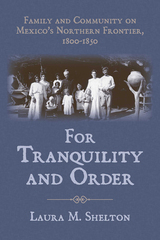 For Tranquility and Order: Family and Community on Mexico's Northern Frontier, 1800–1850
By Laura M. Shelton
University of Arizona Press, 2010 On Mexico’s northwestern frontier, judicial conflicts unfolded against a backdrop of armed resistance and ethnic violence. In the face of Apache raids in the north and Yaqui and Mayo revolts in the south, domestic disputes involving children, wives, and servants were easily conflated with ethnic rebellion and “barbarous” threats. A wife’s adulterous liaison, a daughter’s elopement, or a nephew’s enraged assault shook the very foundation of what it meant to be civilized at a time when communities saw themselves under siege.
Laura Shelton has plumbed the legal archives of early Sonora to reveal the extent to which both court officials and quarreling relatives imagined connections between gender hierarchies and civilized order. As she describes how the region’s nascent legal system became the institution through which spouses, parents, children, employers, and servants settled disputes over everything from custody to assault to debt, she reveals how these daily encounters between men and women in the local courts contributed to the formation of republican governance on Mexico’s northwestern frontier.
Through an analysis of some 700 civil and criminal trial records—along with census data, military reports, church records, and other sources—Shelton describes how courtroom encounters were conditioned by an Iberian legal legacy; brutal ethnic violence; emerging liberal ideas about trade, citizenship, and property rights; and a growing recognition that honor—buenas costumbres—was dependent more on conduct than on bloodline. For Tranquility and Order offers new insight into a legal system too often characterized as inept as it provides a unique gender analysis of family relations on the frontier.
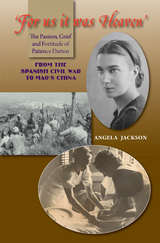 'For Us It Was Heaven': The Passion, Grief and Fortitude of Patience Darton: From the Spanish Civil War to Mao's China
Angela Jackson
Sussex Academic Press, 2022 "I made a person out of myself and became an individual with a life and work of my own." *** 'For Us It Was Heaven' tells the story of a young, upper middle-class nurse in the 1930s who becomes dramatically caught up in Spain's civil war and the passionate political issues of her times, but whose intimate writings reveal emotions and attitudes that will strike a chord with most self-aware and determined women today. Patience Darton's unpublished letters and papers from 1930s Spain and 1950s China are at the heart of this new biography, together with testimony from recorded interviews and a wealth of photographs that illustrate the life of this remarkable woman. While Darton was a medical nurse near the front lines in Spain, she met and fell in love with Robert, a German volunteer in the International Brigades, deeply committed to fighting fascism. Their passionate relationship colored the rest of her long life, taking her to communist China and then, finally, back to Spain.
 For Us, What Music?: The Life and Poetry of Donald Justice
Jerry Harp
University of Iowa Press, 2010 When Donald Justice wrote in “On a Picture by Burchfield” that “art keeps long hours,” he might have been describing his own life. Although he early on struggled to find a balance between his life and art, the latter became a way of experiencing his life more deeply. He found meaning in human experience by applying traditional religious language to his artistic vocation. Central to his work was the translation of the language of devotion to a learned American vernacular. Art not only provided him with a wealth of intrinsically worthwhile experiences but also granted rich and nuanced ways of experiencing, understanding, and being in the world. For Donald Justice—recipient of some of poetry’s highest laurels, including the Pulitzer Prize, the Bollingen Prize, and the Lannan Literary Award for Poetry—art was a way of life. Because Jerry Harp was Justice’s student, his personal knowledge of his subject—combined with his deep understanding of Justice’s oeuvre—works to remarkable advantage in For Us, What Music? Harp reads with keen intelligence, placing each poem within the precise historical moment it was written and locating it in the context of the literary tradition within which Justice worked. Throughout the text runs the narrative of Justice’s life, tying together the poems and informing Harp’s interpretation of them. For Us, What Music? grants readers a remarkable understanding of one of America’s greatest poets.
For Women and the Nation: FUNMILAYO RANSOME-KUTI OF NIGERIA
Cheryl Johnson-Odim and Nina Emma Mba
University of Illinois Press, 1997 Funmilayo Ransome-Kuti was a Nigerian activist who fought for suffrage and equal rights for her countrywomen long before the second wave of the women's movement in the United States. Her involvement in international women's organizations led her to travel the world in the period following World War II. She championed the causes of the poor and downtrodden of both sexes as she joined the anticolonial movement struggling for Nigeria's independence.
For Women and the Nation is the story of this courageous woman. One of a handful of full-length biographies of African women, let alone of African women activists, it will be welcomed by students of women's studies, African history, and biography, as well as by those interested in exploring the historical background of Nigeria.
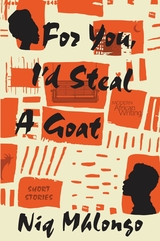 For You, I'd Steal a Goat: Short Stories
Niq Mhlongo
Ohio University Press, 2025 For You, I’d Steal a Goat is a vibrant collection of short stories filled with memorable characters, intriguing plots, and twist endings. It explores a wide range of themes, such as corruption, racial bias, family troubles, and lovers’ spats, to name a few. In his stories about queer relationships, Niq Mhlongo surfaces the complexities of a community whose narratives have been silenced. With his keen observations and insights into human nature, Mhlongo explores the things that people do for each other, but also to each other, including acts of injustice and exploitation as well as of love and desire. Mhlongo’s stories are critical, erudite, and masterfully crafted using satire and careful deliberation to connect to the quotidian lived experiences of readers. With a sense of humor, Mhlongo reflects on some of the greatest transformations South Africans have faced in recent times and engages with crucial matters in the present.
 For Zion's Sake: The Judeo-Christian Tradition in American Culture
Fuad Sha'ban
Pluto Press, 2005 This book explores the role of religion, especially religious extremism, in American culture. In particular, it examines the development of the Judeo-Christian tradition, its impact on America's self-image, and the way it has influenced America's attitude to the Arab World.
The Christian Right has become a very powerful force in American politics. Its basic belief in Christian Zionism has resulted in a steadfast commitment to the establishment of the state of Israel and to its aggressive expansion, and has made Zionism a central part of government policy, for both Republicans and Democrats.
Fuad Sha'ban shows how this is not a new phenomenon: what he terms the 'Vision of Zion' in American life has its roots in literature, the arts and internal politics from colonial times until today. Looking in detail at a wealth of resources, including religious and literary texts, as well as official political statements, he pieces together a subtle account of how America's Puritan roots have fostered a specifically religious political culture that encourages hatred and suspicion of the Muslim World in domestic and foreign policy.
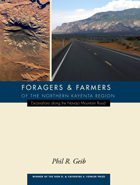 Foragers and Farmers of the Northern Kayenta Region: Excavations along the Navajo Mountain Road
Phil Geib
University of Utah Press, 2011 Winner of the Don D. and Catherine S. Fowler Prize Foragers and Farmers of the Northern Kayenta Region presents the results of a major archaeological excavation project on Navajo tribal land in the Four Corners area and integrates this new information with existing knowledge of the archaeology of the northern Kayenta region. The excavation of thirty-three sites provides a cross section of prehistory from which Navajo Nation archaeologists retrieved a wealth of information about subsistence, settlement, architecture, and other aspects of past lifeways. The project’s most important contributions involve the Basketmaker and Archaic periods, and include a large number of radiocarbon dates on high-quality samples. Dating back to the early Archaic period (ca. 7000 BC) and ranging forward through the Basketmaker components to the Puebloan period, this volume is a powerful record of ancient peoples and their cultures. Detailed supplementary data will be available on the University of Utah Press Web site upon publication of this summary volume. Volume 2: Archaic Site Descriptions Volume 3: Basketmaker Site Descriptions Volume 4: Puebloan Site Descriptions Volume 5: Analyses and Interpretation Appendix Volume
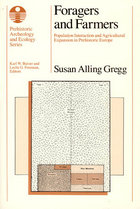 Foragers and Farmers: Population Interaction and Agricultural Expansion in Prehistoric Europe
Susan Alling Gregg
University of Chicago Press, 1988 Susan Alling Gregg presents a sophisticated model for the transition from hunter-gatherer societies tosettled agricultural communities in prehistoric Europe. She proposes that farmers and foragers must have encountered each other and interacted in a variety of ways for over a millennium as farming systems spread throughout the continent. Several variations of subsistence developed, such as foraging and hunting for part of the year and farming for the rest, or cooperative exchange arrangements between hunter-gatherers and farmers throughout the year.
Gregg examines anthropological, ecological, and archaeological dimensions of prehistoric population interaction. She then examines the ecological requirements of both crops and livestock and, in order to identify an optimal farming strategy for Early Neolithic populations, develops a computer simulation to examine various resource mixes. Turning to the foragers, she models the effects that interaction with the farmers would have had on the foragers' subsistence-settlement system.
Supporting her model with archaeological, ecological, and ethnobotanical evidence from southwest Germany, Gregg shows that when foragers and farmers occur contemporaneously, both need to be considered before either can be understood. Theoretically and methodologically, her work builds upon earlier studies of optimal diet and foraging strategy, extending the model to food-producing populations. The applicability of Gregg's generalized model for both wild and domestic resources reaches far beyond her case study of Early Neolithic Germany; it will interest both Old and New World archaeologists.
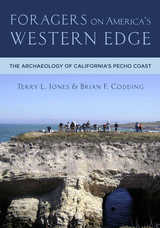 Foragers on America's Western Edge: The Archaeology of California's Pecho Coast
Terry L. Jones and Brian F. Codding
University of Utah Press, 2018 The California coastline has long been of interest to archaeologists. This book directs attention to the largely ignored Pecho Coast, a rugged, isolated, 20 km long peninsula between modern-day Morro Bay and Pismo Beach. Archaeological work along this stretch was last synthesized in 1972. Jones and Codding now bring together the extensive contract work and field school studies of the intervening years, shedding new light on the region’s early inhabitants.
The first people of the Pecho Coast were part-time residents who exploited shellfish, fish, and marine birds, including the flightless duck, Chendytes lawi, which sustained hunting drove to extinction ca. 2800 cal BP. This marked the only unequivocal case of prehistoric, human-caused extinction in western North America. Cold, productive seas allowed inhabitants to weather droughts of the Medieval Climatic Anomaly (950–600 cal BP), after which shell beads became increasingly abundant, representing either the initial appearance of Chumash-speaking peoples or attempts by Chumash leaders to consolidate power through gifting, reciprocal exchange, or forced conquest. During the mission era, fishing sustained the Native community as, for the first time, individuals became fully sedentary, foraging within a limited radius to avoid contact with the Spanish.
This record reveals a unique story of local adaptation, anthropogenic habitat change, social differentiation, and, ultimately, resistance to colonial invasion.
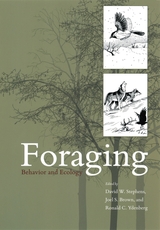 Foraging: Behavior and Ecology
Edited by David W. Stephens, Joel S. Brown, and Ronald C. Ydenberg
University of Chicago Press, 2007 Foraging is fundamental to animal survival and reproduction, yet it is much more than a simple matter of finding food; it is a biological imperative. Animals must find and consume resources to succeed, and they make extraordinary efforts to do so. For instance, pythons rarely eat, but when they do, their meals are large—as much as 60 percent larger than their own bodies. The snake’s digestive system is normally dormant, but during digestion metabolic rates can increase fortyfold. A python digesting quietly on the forest floor has the metabolic rate of thoroughbred in a dead heat. This and related foraging processes have broad applications in ecology, cognitive science, anthropology, and conservation biology—and they can be further extrapolated in economics, neurobiology, and computer science.
Foraging is the first comprehensive review of the topic in more than twenty years. A monumental undertaking, this volume brings together twenty-two experts from throughout the field to offer the latest on the mechanics of foraging, modern foraging theory, and foraging ecology. The fourteen essays cover all the relevant issues, including cognition, individual behavior, caching behavior, parental behavior, antipredator behavior, social behavior, population and community ecology, herbivory, and conservation. Considering a wide range of taxa, from birds to mammals to amphibians, Foraging will be the definitive guide to the field.
Foraging for Survival: Yearling Baboons in Africa
Stuart A. Altmann
University of Chicago Press, 1998 Stuart A. Altmann presents the results of one of the most intensive investigations ever carried out on foraging behavior and its consequences for survival and reproduction.
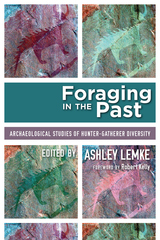 Foraging in the Past: Archaeological Studies of Hunter-Gatherer Diversity
Lemke
University Press of Colorado, 2018 The label “hunter-gatherer” covers an extremely diverse range of societies and behaviors, yet most of what is known is provided by ethnographic and historical data that cannot be used to interpret prehistory. Foraging in the Past takes an explicitly archaeological approach to the potential of the archaeological record to document the variability and time depth of hunter-gatherers.
Well-established and young scholars present new prehistoric data and describe new methods and theories to investigate ancient forager lifeways and document hunter-gatherer variability across the globe. The authors use relationships established by cross-cultural data as a background for examining the empirical patterns of prehistory. Covering underwater sites in North America, the peaks of the Andes, Asian rainforests, and beyond, chapters are data rich, methodologically sound, and theoretically nuanced, effectively exploring the latest evidence for behavioral diversity in the fundamental process of hunting and gathering.
Foraging in the Past establishes how hunter-gatherers can be considered archaeologically, extending beyond the reach of ethnographers and historians to argue that only through archaeological research can the full range of hunter-gatherer variability be documented. Presenting a comprehensive and integrated approach to forager diversity in the past, the volume will be of significance to both students and scholars working with or teaching about hunter-gatherers.
Contributors: Nicholas J. Conard, Raven Garvey, Keiko Kitagawa, John Krigbaum, Petra Krönneck, Steven Kuhn, Julia Lee-Thorp, Peter Mitchell, Katherine Moore, Susanne C. Münzel, Kurt Rademaker, Patrick Roberts, Britt Starkovich, Brian A. Stewart, Mary Stiner
 Foraging in the Tennessee River Valley: 12,500 to 8,000 Years Ago
Kandace D. Hollenbach
University of Alabama Press, 2009 Plants are inarguably a significant component of the diets of foraging peoples in non-arctic environments. As such, the decisions and activities associated with the gathering and exploitation of plants are important to foragers’ subsistence pursuits. Plant remains are particularly important for understanding gathering activities. Inasmuch as plant foods comprised a considerable portion of early foragers’ diets, and the gathering and processing of these plant resources occupied a significant proportion of the population, namely women, children, and the elderly, an understanding of gathering activities and how they relate to use of the landscape is critical. Organic remains are poorly preserved in the acidic soils of the Southeast and are often limited or absent from open-air sites, but archaeological deposits protected within rockshelters provide an exception. Organic remains are consistently well preserved in their rain-protected deposits, and rockshelters are locations that groups repeatedly visited. Because of this repeated use and remarkable preservation, significant quantities of well-preserved faunal and botanical remains can be recovered from rockshelter deposits. In Foraging, Hollenbach analyzes and compares botanical remains from archaeological excavations in four rockshelters in the Middle Tennessee River Valley. The artifact assemblages of rockshelter and open-air sites are similar, so it is reasonable to assume that faunal and botanical assemblages would be similar, if open-air sites had comparable preservation of organic remains. The rich organic data recovered from rockshelters therefore may be considered representative of general subsistence and settlement strategies, and can significantly inform our views of lifeways of Late Paleoindian and Early Archaic peoples. The data produced from this analysis provides a valuable baseline of plant food use by early foragers in the region, and establishes a model of Late Paleoindian and Early Archaic lifeways in the Southeast.
 Foraminifera: Their Classification and Economic Use, 4th Revised and Enlarged Edition
Joseph A. Cushman
Harvard University Press This is the fourth revised and enlarged edition of the standard guide to the Foraminifera, the order of small marine Protozoa whose living and fossilized forms have attracted both scientific and economic interest during the past century. Research on the Foraminifera has developed rapidly in the last few years, because of their value to the petroleum industry and in general geologic correlation.
The classification in this volume is that of the earlier editions, with such changes as could be made by new evidence which has come to light. It is based upon the known geologic history of the genera, the phylogenetic characters as distinguished through study of much fossil material from all continents, and a study of the ontogeny in many microspheric specimens which show relationships more definitely than megalospheric specimens of the same species.
Fifty families, including about seven hundred and fifty genera, are systematically described and illustrated in the text and Key. A comprehensive bibliography, listing titles and authors of the most important works on the Foraminifera, is arranged according to geologic age and geographic distribution,morphology and technique, classification and nomenclature, and general bibliographical references. An index to family and generic names, both valid and invalid, is included.
 A Foray into the Worlds of Animals and Humans: with A Theory of Meaning
Jakob von Uexküll
University of Minnesota Press, 2010 Is the tick a machine or a machine operator? Is it a mere object or a subject? With these questions, the pioneering biophilosopher Jakob von Uexküll embarks on a remarkable exploration of the unique social and physical environments that individual animal species, as well as individuals within species, build and inhabit. This concept of the umwelt has become enormously important within posthumanist philosophy, influencing such figures as Heidegger, Merleau-Ponty, Deleuze and Guattari, and, most recently, Giorgio Agamben, who has called Uexküll "a high point of modern antihumanism."
A key document in the genealogy of posthumanist thought, A Foray into the Worlds of Animals and Humans advances Uexküll's revolutionary belief that nonhuman perceptions must be accounted for in any biology worth its name; it also contains his arguments against natural selection as an adequate explanation for the present orientation of a species' morphology and behavior. A Theory of Meaning extends his thinking on the umwelt, while also identifying an overarching and perceptible unity in nature. Those coming to Uexküll's work for the first time will find that his concept of the umwelt holds out new possibilities for the terms of animality, life, and the whole framework of biopolitics itself.
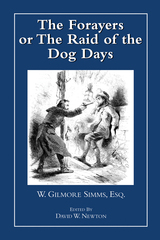 The Forayers: or The Raid of the Dog Days
William Gilmore Simms
University of Arkansas Press, 2003 Historical novelist William Gilmore Simms first published The Forayers in 1855 at the peak of his reputation and ability. Simms had set out to create a prose epic through a series of linked novels detailing American history and struggles from early colonization to the mid-nineteenth century. The Forayers, which was the sixth book in his series of eight Revolutionary War novels set in the South, describes events around Orangeburg, South Carolina, before the Battle of Eutaw Springs (itself covered in this novel’s sequel, Eutaw). It features such characters as Hell-fire Dick, a hardhearted, foul-mouthed looter under Tory protection. Simms hoped his readers would find this book “a bold, brave, masculine story; frank, ardent, vigorous; faithful to humanity.” He described it to a friend as “fresh and original” and wrote that “the characterization [is] as truthful as forcible. It is at once a novel of society & a romance.”
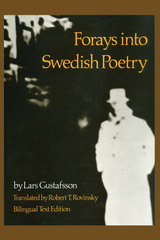 Forays into Swedish Poetry
By Lars Gustafsson
University of Texas Press, 1978 When poet/critic Lars Gustafsson was the editor of Bonniers Litterära Magasin, he was bombarded with the question, “What makes a good poem?” Forays into Swedish Poetry is his answer. The fifteen poems in this volume range across the history of Swedish poetry from the 1640s, at the beginning of the Period of Great Power, to the late twentieth century. Poets as diverse as Skogekär Bergbo, Erik Johan Stagnelius, August Strindberg, and Vilhelm Ekelund are discussed from historical, psychological, and sociopolitical viewpoints. However, Gustafsson includes only those poems he considers excellent. Each essay begins with a presentation of the poem both in Swedish and in English translation. Gustafsson’s analyses are built upon his subjective experiences with poems and poets and upon a more objective structural approach that investigates the actual machinery of the poems. Thus, Gustafsson enlightens us with his always imaginative, sometimes daring analyses, and we learn a great deal about the critic himself in the process. One of his main concerns is what he calls, in his discussion of Edith Södergran, the very mysteriousness of human existence. Time and again, Gustafsson emphasizes the enigmatic, arcane aspects of life in his analyses. In contrast, his vocabulary and approach also bespeak a constant interest in science and technology. In his introduction, Robert T. Rovinsky, the volume’s translator, presents examples of Gustafsson’s various thematic interests as voiced in his poems, several of which are translated here for the first time. While “The Machines” explores his theory of people as automatons and “Conversation between Philosophers” his linguistic pessimism, Gustafsson’s work as a whole shows his enchantment with its major theme: the intrinsic mystery of life.
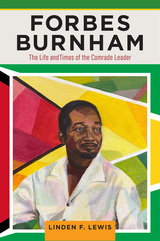 Forbes Burnham: The Life and Times of the Comrade Leader
Linden F. Lewis
Rutgers University Press, 2024 It is virtually impossible to understand the history of modern Guyana without understanding the role played by Forbes Burnham. As premier of British Guiana, he led the country to independence in 1966 and spent two decades as its head of state until his death in 1985. An intensely charismatic politician, Burnham helped steer a new course for the former colony, but he was also a quintessential strongman leader, venerated by some of his citizens yet feared and despised by others.
Forbes Burnham: The Life and Times of the Comrade Leader is the first political biography of this complex and influential figure. It charts how the political party he founded, the People’s National Congress, combined nationalist rhetoric, socialist policies, and Pan-Africanist philosophies. It also explores how, in a country already deeply divided between the descendants of African slaves and Indian indentured servants, Burnham consolidated political power by intensifying ethnic polarizations. Drawing from historical archives as well as new interviews with the people who knew Burnham best, sociologist Linden F. Lewis examines how his dictatorial tendencies coexisted with his progressive convictions. Forbes Burnham is a compelling study of the nature of postcolonial leadership and its pitfalls.
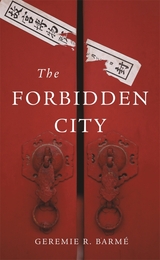 The Forbidden City
Geremie R. Barmé
Harvard University Press, 2008 Read supplementary material prepared by Geremie Barmé
Read the Bldg Blog interview with Mary Beard about the Wonders of the World series(Part I and Part II)
The Forbidden City (Zijin Cheng) lying at the heart of Beijing formed the hub of the Celestial Empire for five centuries. Over the past century it has led a reduced life as the refuge for a deposed emperor, as well as a heritage museum for monarchist, republican, and socialist citizens, and it has been celebrated and excoriated as a symbol of all that was magnificent and terrible in dynastic China’s legacy.
The Forbidden City’s vermilion walls have fueled literary fantasies that have become an intrinsic part of its disputed and documented history. Mao Zedong even considered razing the entire structure to make way for the buildings of a new socialist China. The fictions surrounding the Forbidden City have also had an international reach, and writers like Franz Kafka, Elias Canetti, Jorge Luis Borges, and Mervyn Peake have all succumbed to its myths. The politics it enshrined have provided the vocabulary of power that is used in China to the present day, though it is now better known as a film set or the background of displays of opera, rock, and fashion.
Geremie Barmé peels away the veneer of power, secrecy, inscrutability, and passions of imperial China, to provide a new and original history of the culture, politics, and architecture of the Forbidden City. Designed to overawe the visitor with the power of imperial China, the Forbidden City remains one of the true wonders of the world.
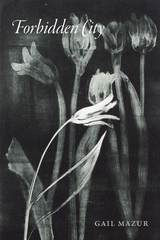 Forbidden City
Gail Mazur
University of Chicago Press, 2016 from “Mount Fuji”
A draughtsman’s draughtsman, Hokusai at 70
thought he’d begun to grasp the structures
of birds and beasts, insects and fish, of the way
plants grow, hoped that by 90 he’d have
penetrated to their essential nature.
And more, by 100, I will have reached the stage
where every dot, every mark I make will be
alive. You always loved that resolve, you’d repeat
joyfully—Hokusai’s utterance of faith
in work’s possibilities, its reward, that,
at 130, he’d perhaps have learned to draw.
Gail Mazur’s poems in Forbidden City build an engaging meditative structure upon the elements of mortality and art, eloquently contemplating the relationship of art and life—and the dynamic possibilities of each in combination. At the collection’s heart is the poet’s long marriage to the artist Michael Mazur (1935–2009). A fascinating range of tone infuses the book—grieving, but clear-eyed rather than lugubrious, sometimes whimsical, even comical, and often exuberant. The note of pleasure, as in an old tradition enriched by transience, runs through the work, even in the final poem, “Grief,” where “our ravenous hold on the world” is a powerful central element.
Forbidden Family: Wartime Memoir of the Philippines, 1941-1945
Margaret Sams
University of Wisconsin Press, 1997 Written just five years after the end of World War II, this is Margaret Sams’s moving testimony of life in a Japanese internment camp—the can of Spam hoarded for Christmas dinner, the clandestine radio hidden in her sewing kit, the beheading of other prisoners for transgressions. With her husband held elsewhere as a prisoner of war and with a small son to protect, Margaret broke the rules both of society and of her captors to fall in love and bear a child with a kind and daring fellow internee, Jerry Sams.
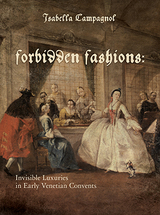 Forbidden Fashions: Invisible Luxuries in Early Venetian Convents
Isabella Campagnol
Texas Tech University Press, 2014 Form-fitting dresses, silk veils, earrings, furs, high-heeled shoes, make up, and dyed, flowing hair. It is difficult for a contemporary person to reconcile these elegant clothes and accessories with the image of cloistered nuns. For many of the some thousand nuns in early modern Venice, however, these fashions were the norm.
Often locked in convents without any religious calling—simply to save their parents the expense of their dowry—these involuntary nuns relied on the symbolic meaning of secular clothes, fabrics, and colors to rebel against the rules and prescriptions of conventual life and to define roles and social status inside monastic society.
Calling upon mountains of archival documents, most of which have never been seen in print, Forbidden Fashions is the first book to focus specifically upon the dress of nuns in Venetian convents and offers new perspective on the intersection of dress and the city’s social and economic history.
Forbidden Grounds: The Case against Employment Discrimination Laws
Richard A. Epstein
Harvard University Press, 1992 This timely and controversial book presents powerful theoretical and empirical arguments for the repeal of the anti-discrimination laws within the workplace. Richard Epstein demonstrates that these laws set one group against another, impose limits on freedom of choice, unleash bureaucratic excesses, mandate inefficient employment practices, and cause far more invidious discrimination than they prevent. Epstein urges a return to the now-rejected common law principles of individual autonomy that permit all persons to improve their position through trade, contract, and bargain, free of government constraint.
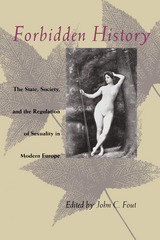 Forbidden History: The State, Society, and the Regulation of Sexuality in Modern Europe
Edited by John C. Fout
University of Chicago Press, 1992 How have society's values and attitudes toward sexuality and morality changed over the centuries? Why and how has the state sought to criminalize certain forms of sexual behavior and to control reproduction? How have churches tried to influence the state in its regulation of sexuality?
This anthology encompasses a broad range of essays on sexuality spanning European history from the fifteenth century to the present. The topics in this collection of fifteen essays have both historic importance and current relevance. All crucial issues in the regulation of sexuality are addressed, from incest to infanticide, from breast-feeding and women's sexuality to female prostitution, from pornography to reproductive politics, and from the first homosexual rights movement to AIDS.
Contributions from a diverse group of prominent scholars representing a variety of disciplines are included in this anthology. Essays by Randolph Trumbach on "Sex, Gender, and Identity in Modern Culture: Male Sodomy and Female Prostitution in Enlightenment London"; Ruth Perry on "Colonizing the Breast: Sexuality and Maternity in Eighteenth Century England"; Theo van der Meer on "Female Same-Sex Offenders in Late Eighteenth Century Amsterdam"; Robin Ann Sheets on "Pornography, Fairy Tales, and Feminism: Angela Carter's 'The Bloody Chamber'"; and James W. Jones on "Discourses on and of AIDS in West Germany, 1986-1990."
Offering the most up-to-date scholarship from a significant and growing field, this collection is essential for both students and faculty in social history, family history, women's and gender studies, gay studies, sociology and literature.
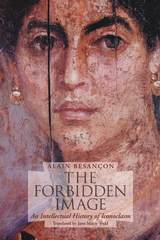 The Forbidden Image: An Intellectual History of Iconoclasm
Alain Besançon
University of Chicago Press, 2001 Philosophers and theologians have long engaged in intense debate and introspection over the representation of the deity, its possibilities and its proscriptions. The Forbidden Image traces the dual strains of “iconophilia” and iconoclasm, the privileging and prohibition of religious images, over a span of two and a half millennia in the West. Alain Besançon’s work begins with a comprehensive examination of the status of the image in Greek, Judaic, Islamic, and Christian thought. The author then addresses arguments regarding the moral authority of the image in European Christianity from the medieval through the early modern periods. Besançon completes The Forbidden Image with an examination of how iconophilia and iconoclasm have been debated in the modern period. “Even the reader who has heard something of the Byzantine quarrels about images and their theological background will be surprised by a learned and convincing interpretation of the works of Mondrian, Kandinsky, and Malevich in terms of religiously inspired iconoclasm. . . . This is an immensely rich and powerful masterpiece.”—Leszek Kolakowski, Times Literary Supplement
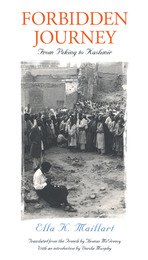 Forbidden Journey
Ella Maillart
Northwestern University Press, 2003 A classic account of a trip through China during the golden age of travel
In 1935 Ella Maillart contemplated one of the most arduous journeys in the world: the "impossible journey" from Peking, then a part of Japanese-occupied China, through the distant province of Sinkiang (present day Tukestan), to Kashmir. Enlisting with newswriter Peter Fleming (with the caveat that his company remain tolerable), Maillart undertook a journey considered almost beyond imagination for any European and doubly so for a woman.
The trip promised hardships such as typhus and bandits, as well as the countless hazards surrounding the civil war between Chinese communists and Chiang Kai-shek's nationalists. Setting out with pockets full of Mexican money (the currency used in China at the time), Maillart encountered a way of life now lost, but one that then had gone unchanged for centuries.
Maillart describes it all with the sharp eye and unvarnished prose of a veteran reporter-the missionaries and rogues, parents binding daughters' feet with rags, the impatient Fleming lighting fires under stubborn camels. It's a hard road, not that Maillart cares. At all times she is a witty, always-enchanted guide-except when it comes to bureaucrats.
Forbidden Journey ranks among other travel narratives like Fleming's News from Tartary, (based on the same journey) and Robert Byron's The Road to Oxiana. But it is also a portrait of a fascinating woman, one of many women from the pre-WWII era who ignored convention and traveled in hidden lands. It remains a vivid account of its time and a classic of travel literature.
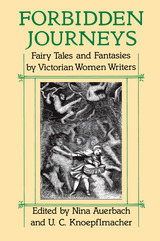 Forbidden Journeys: Fairy Tales and Fantasies by Victorian Women Writers
Edited by Nina Auerbach and U. C. Knoepflmacher
University of Chicago Press, 1992 As these eleven dark and wild stories demonstrate, fairy tales by Victorian women constitute a distinct literary tradition, one startlingly subversive of the society that fostered it. From Anne Thackeray Ritchie's adaptations of "The Sleeping Beauty in the Wood" to Christina Rossetti's unsettling antifantasies in Speaking Likenesses, these are breathtaking acts of imaginative freedom, by turns amusing, charming, and disturbing. Besides their social and historical implications, they are extraordinary stories, full of strange delights for readers of any age.
"Forbidden Journeys is not only a darkly entertaining book to read for the fantasies and anti-fantasies told, but also is a significant contribution to nineteenth-century cultural history, and especially feminist studies."—United Press International
"A service to feminists, to Victorian Studies, to children's literature and to children."—Beverly Lyon Clark, Women's Review of Books
"These are stories to laugh over, cheer at, celebrate, and wince at. . . . Forbidden Journeys is a welcome reminder that rebellion was still possible, and the editors' intelligent and fascinating commentary reveals ways in which these stories defied the Victorian patriarchy."—Allyson F. McGill, Belles Lettres
 Forbidden Journeys: Fairy Tales and Fantasies by Victorian Women Writers
Edited by Nina Auerbach and U. C. Knoepflmacher
University of Chicago Press, 1992 This is an auto-narrated audiobook version of this book.
As these eleven dark and wild stories demonstrate, fairy tales by Victorian women constitute a distinct literary tradition, one startlingly subversive of the society that fostered it. From Anne Thackeray Ritchie's adaptations of "The Sleeping Beauty in the Wood" to Christina Rossetti's unsettling antifantasies in Speaking Likenesses, these are breathtaking acts of imaginative freedom, by turns amusing, charming, and disturbing. Besides their social and historical implications, they are extraordinary stories, full of strange delights for readers of any age.
"Forbidden Journeys is not only a darkly entertaining book to read for the fantasies and anti-fantasies told, but also is a significant contribution to nineteenth-century cultural history, and especially feminist studies."—United Press International
"A service to feminists, to Victorian Studies, to children's literature and to children."—Beverly Lyon Clark, Women's Review of Books
"These are stories to laugh over, cheer at, celebrate, and wince at. . . . Forbidden Journeys is a welcome reminder that rebellion was still possible, and the editors' intelligent and fascinating commentary reveals ways in which these stories defied the Victorian patriarchy."—Allyson F. McGill, Belles Lettres
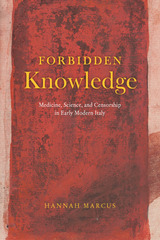 Forbidden Knowledge: Medicine, Science, and Censorship in Early Modern Italy
Hannah Marcus
University of Chicago Press, 2020 An exploration of the censorship of medical books from their proliferation in print through the prohibitions placed on them during the Counter-Reformation.
Forbidden Knowledge explores the censorship of medical books from their proliferation in print through the prohibitions placed on them during the Counter-Reformation. How and why did books banned in Italy in the sixteenth century end up back on library shelves in the seventeenth? Historian Hannah Marcus uncovers how early modern physicians evaluated the utility of banned books and facilitated their continued circulation in conversation with Catholic authorities.
Through extensive archival research, Marcus highlights how talk of scientific utility, once thought to have begun during the Scientific Revolution, in fact, began earlier, emerging from ecclesiastical censorship and the desire to continue to use banned medical books. What’s more, this censorship in medicine, which preceded the Copernican debate in astronomy by sixty years, has had a lasting impact on how we talk about new and controversial developments in scientific knowledge. Beautiful illustrations accompany this masterful, timely book about the interplay between efforts at intellectual control and the utility of knowledge.
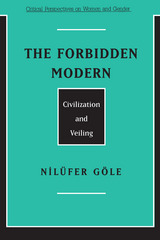 The Forbidden Modern: Civilization and Veiling
Nilufer Gole
University of Michigan Press, 1997 This book by prominent Turkish scholar Nilüfer Göle examines the complex relationships among modernity, religion, and gender relations in the Middle East. Her focus is on the factors that influence young women pursuing university educations in Turkey to adopt seemingly fundamentalist Islamist traditions, such as veiling, and the complex web of meanings attributed to these gender-separating practices. Veiling, a politicized practice that conceptually forces people to choose between the "modern" and the "backward," provides an insightful way of looking at the contemporary Islam-West conflict, shedding light on the recent rise of Islamist fundamentalism in many countries and providing insight into what is a more complex phenomenon than is commonly portrayed in accounts by Western journalists.
Göle's sociological approach, employing a number of personal interviews, allows for both a detailed case study of these young Turkish women who are turning to the tenets of fundamental Islamist gender codes, and for a broader critique of Eurocentrism and the academic literature regarding the construction of meaning. Both perspectives serve as a springboard for the launching of theoretical innovations into feminist, religious, cultural, and area studies.
"A timely book, whose publication in English will contribute to a variety of scholarly debates. It promises to be provocative and widely read among scholars interested in issues of modernism and identity, women's social movements, the status of women in Islamic societies, and the broader issues of public versus private spheres." --Nilüfer Isvan, State University of New York, Stony Brook
The Forbidden Modern: Civilization and Veiling was originally published as Modern Mahrem by the Turkish publisher Metis and has been translated into French, German, and Spanish. Nilüfer Göle is Professor of Sociology, Bogaziçi University.
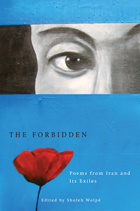 The Forbidden: Poems from Iran and its Exiles
Sholeh Wolpé
Michigan State University Press, 2012 During the 1979 revolution, Iranians from all walks of life, whether Muslim, Jewish, Christian, socialist, or atheist, fought side-by-side to end one tyrannical regime, only to find themselves in the clutches of another. When Khomeini came to power, freedom of the press was eliminated, religious tolerance disappeared, women’s rights narrowed to fit within a conservative interpretation of the Quran, and non-Islamic music and literature were banned. Poets, writers, and artists were driven deep underground and, in many cases, out of the country altogether. This moving anthology is a testament to both the centuries-old tradition of Persian poetry and the enduring will of the Iranian people to resist injustice. The poems selected for this collection represent the young, the old, and the ancient. They are written by poets who call or have called Iran home, many of whom have become part of a diverse and thriving diaspora.
 Forbidden: Receiving Pope Francis's Condemnation of Nuclear Weapons
Drew Christiansen and Carole Sargent, Editors
Georgetown University Press, 2023 Moral theologians, defense analysts, conflict scholars, and nuclear experts imagine a world free from nuclear weapons At a 2017 Vatican conference, Pope Francis condemned nuclear weapons. This volume, issued after the 60th anniversary of the Cuban Missile Crisis, presents essays from moral theologians, defense analysts, conflict transformation scholars, and nuclear arms control experts, with testimonies from witnesses. It is a companion volume to A World Free from Nuclear Weapons: The Vatican Conference on Disarmament (Georgetown University Press, 2020). Chapters from the perspectives of missile personnel and the military chain of command, industrialists and legislators, and citizen activists show how we might achieve a nuclear-free world. Key to this transition is the important role of public education and the mobilization of lay movements to raise awareness and effect change. This essential collection prepares military professionals, policymakers, everyday citizens, and the pastoral workers who guide them, to make decisions that will lead us to disarmament.
 Forbidden Relatives: THE AMERICAN MYTH OF COUSIN MARRIAGE
Martin Ottenheimer
University of Illinois Press, 1996 Forbidden Relatives challenges the belief--widely held in the United States--that legislation against marriage between first cousins is based on a biological risk to offspring. In fact, its author maintains, the U.S. prohibition against such unions originated largely because of the belief that it would promote more rapid assimilation of immigrants.
A social anthropologist, Martin Ottenheimer questioned U.S. laws against cousin marriage because his international research into marriage patterns showed no European countries prohibit such unions. He examines the historical development of U.S. laws governing marriage, contrasts them with European laws, and analyzes the genetic implications of first cousin marriage. Modern genetic evidence, Ottenheimer says, doesn't support the concept that children of these unions are at any special risk.
Ottenheimer's book, the only volume available that deals with kinship in this way, will challenge readers and give them much to consider and discuss.
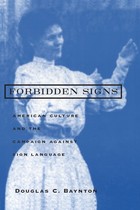 Forbidden Signs: American Culture and the Campaign against Sign Language
Douglas C. Baynton
University of Chicago Press, 1996 Forbidden Signs explores American culture from the mid-nineteenth century to 1920 through the lens of one striking episode: the campaign led by Alexander Graham Bell and other prominent Americans to suppress the use of sign language among deaf people.
The ensuing debate over sign language invoked such fundamental questions as what distinguished Americans from non-Americans, civilized people from "savages," humans from animals, men from women, the natural from the unnatural, and the normal from the abnormal. An advocate of the return to sign language, Baynton found that although the grounds of the debate have shifted, educators still base decisions on many of the same metaphors and images that led to the misguided efforts to eradicate sign language.
"Baynton's brilliant and detailed history, Forbidden Signs, reminds us that debates over the use of dialects or languages are really the linguistic tip of a mostly submerged argument about power, social control, nationalism, who has the right to speak and who has the right to control modes of speech."—Lennard J. Davis, The Nation
"Forbidden Signs is replete with good things."—Hugh Kenner, New York Times Book Review
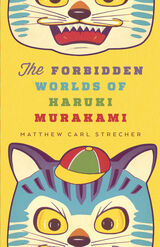 The Forbidden Worlds of Haruki Murakami
Matthew Carl Strecher
University of Minnesota Press, 2014 In an “other world” composed of language—it could be a fathomless Martian well, a labyrinthine hotel or forest—a narrative unfolds, and with it the experiences, memories, and dreams that constitute reality for Haruki Murakami’s characters and readers alike. Memories and dreams in turn conjure their magical counterparts—people without names or pasts, fantastic animals, half-animals, and talking machines that traverse the dark psychic underworld of this writer’s extraordinary fiction. Fervently acclaimed worldwide, Murakami’s wildly imaginative work in many ways remains a mystery, its worlds within worlds uncharted territory. Finally in this book readers will find a map to the strange realm that grounds virtually every aspect of Murakami’s writing. A journey through the enigmatic and baffling innermost mind, a metaphysical dimension where Murakami’s most bizarre scenes and characters lurk, The Forbidden Worlds of Haruki Murakami exposes the psychological and mythological underpinnings of this other world. Matthew Carl Strecher shows how these considerations color Murakami’s depictions of the individual and collective soul, which constantly shift between the tangible and intangible but in this literary landscape are undeniably real. Through these otherworldly depths The Forbidden Worlds of Haruki Murakami also charts the writer’s vivid “inner world,” whether unconscious or underworld (what some Japanese critics call achiragawa, or “over there”), and its connectivity to language. Strecher covers all of Murakami’s work—including his efforts as a literary journalist—and concludes with the first full-length close reading of the writer’s newest novel, Colorless Tsukuru Tazaki and His Years of Pilgrimage.
 Force and Freedom: Kant’s Legal and Political Philosophy
Arthur Ripstein
Harvard University Press, 2009 In this masterful work, both an illumination of Kant’s thought and an important contribution to contemporary legal and political theory, Arthur Ripstein gives a comprehensive yet accessible account of Kant’s political philosophy. Ripstein shows that Kant’s thought is organized around two central claims: first, that legal institutions are not simply responses to human limitations or circumstances; indeed the requirements of justice can be articulated without recourse to views about human inclinations and vulnerabilities. Second, Kant argues for a distinctive moral principle, which restricts the legitimate use of force to the creation of a system of equal freedom. Ripstein’s description of the unity and philosophical plausibility of this dimension of Kant’s thought will be a revelation to political and legal scholars.
In addition to providing a clear and coherent statement of the most misunderstood of Kant’s ideas, Ripstein also shows that Kant’s views remain conceptually powerful and morally appealing today. Ripstein defends the idea of equal freedom by examining several substantive areas of law—private rights, constitutional law, police powers, and punishment—and by demonstrating the compelling advantages of the Kantian framework over competing approaches.
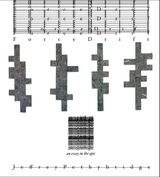 Force Drift: An Essay in the Epic
Jeffrey Pethybridge
Tupelo Press, 2025 In his extraordinary second collection, poet Jeffrey Pethybridge confronts the ethical disaster of the torture program that the United States used to advance the so-called global war on terror.
The poems in Force Drift recall Gilles Deleuze’s insight that art “is not a matter of reproducing or inventing forms, but of capturing forces.” Through the formal range of this dynamic sequence, Pethybridge achieves something like a synthesis of Deleuze’s opposition whereby the invention of poetic form becomes the very means of capturing, registering forces: “a reckoning lyric.”
The task of reckoning renders visible the violence of the state that lies at the heart of the matter precisely because the state intends to conceal or justify its brutality through the invocation of emergency powers, as well as the state of exception, or how the state disappears persons in its network of black site prisons. As the political scientist Darius Rejali has demonstrated, it is in fact democracies that have refined “invisible tortures” such as sensory deprivation, stress-positions, and the waterboard.
Working at the intersection of documentary poetics and theories of the epic, Pethybridge recommits poetry to a responsibility for a description of history. As a poet-researcher, he asks: “what would be possible…if listening / were the leading-form of being.” Driven by argument, abstraction, and assemblage, the poems in Force Drift address themselves to the irreparable, the “traumaeffect,” within the war on terror’s record of atrocity. Force Drift is a cri de coeur, political critique, and essay in the epic.
Against the world-destroying violence of the US torture program, Force Drifts juxtaposes a catalog of energies, forms, and genres. It is abolitionist, citational, architectural, chromatic, and replete with visual poetries ranging from the arabasques of tzahibs to erasures to extreme measures of leading and kerning. Even when its language is reduced to the pure transcription of pain––”aiai aiai aiai”––Force Drift is committed to aliveness and embodiment as “final treaty of the person,” as conscience and counterworld to the history as catastrophe of US imperialism, “irrefutable as the sun to the eye.”
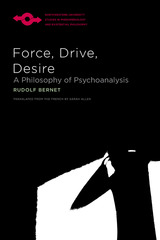 Force, Drive, Desire: A Philosophy of Psychoanalysis
Rudolf Bernet, Translated from the French by Sarah Allen
Northwestern University Press, 2020 In Force, Drive, Desire, Rudolf Bernet develops a philosophical foundation of psychoanalysis focusing on human drives. Rather than simply drawing up a list of Freud’s borrowings from Schopenhauer and Nietzsche, or Lacan’s from Hegel and Sartre, Bernet orchestrates a dialogue between philosophy and psychoanalysis that goes far beyond what these eminent psychoanalysts knew about philosophy. By relating the writings of Freud, Lacan, and other psychoanalysts to those of Aristotle, Leibniz, Schopenhauer, Nietzsche, Husserl, Heidegger, and, more tacitly, Bergson and Deleuze, Bernet brings to light how psychoanalysis both prolongs and breaks with the history of Western metaphysics and philosophy of nature.
Rereading the long history of metaphysics (or at least a few of its key moments) in light of psychoanalytic inquiries into the nature and function of drive and desire also allows for a rewriting of the history of philosophy. Specifically, it allows Bernet to bring to light a different history of metaphysics, one centered less on Aristotelian substance (ousia) and more on the concept of dunamis—a power or potentiality for a realization toward which it strives with all its might. Relating human drives to metaphysical forces also bears fruit for a renewed philosophy of life and subjectivity.
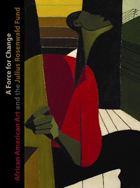 A Force for Change: African American Art and the Julius Rosenwald Fund
Daniel Schulman
Northwestern University Press, 2009 The Julius Rosenwald Fund has been largely ignored in the literature of both art history and African American studies, despite its unique focus, intensity, and commitment. Spertus Museum in Chicago has organized an exhibition, guest curated by Daniel Schulman, that presents and explores the work of funded artists as well as the history of the Fund. Through it, and this accompanying collection of essays, illustrations, and color plates, we see the Fund’s groundbreaking initiative to address issues relating to the unequal treatment of blacks in American life. The book constitutes a veritable Who’s Who of African American artists and intellectuals of the first half of the twentieth century, as well as a roll call of modern contributors who represent the leading scholars in their fields, including Peter M. Ascoli, grandson and biographer of Julius Rosenwald, and Kinshasha Holman Conwill, deputy director of the National Museum of African American Art and Culture. With far-reaching influence even today, the Julius Rosenwald Fund stands alongside the Rockefeller and Carnegie funds as a major force in American cultural history.
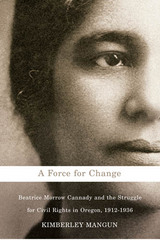 A Force for Change: Beatrice Morrow Cannady and the Struggle for Civil Rights in Oregon, 1912-1936
Kimberley Mangun
Oregon State University Press, 2010 A Force for Change is the first full-length study of the life and work of one of Oregon’s most dynamic civil rights activists, African American journalist Beatrice Morrow Cannady. Between 1912 and 1936, Cannady tirelessly promoted interracial goodwill and fought segregation and discrimination. She gave hundreds of lectures to high school and college students and shared her message with radio listeners across the Pacific Northwest. She was assistant editor, and later publisher, of The Advocate, Oregon’s largest African American newspaper. Cannady was the first black woman to graduate from law school in Oregon, and the first to run for state representative. She held interracial teas in her home in Northeast Portland and protested repeated showings of the racist film The Birth of a Nation. And when the Ku Klux Klan swept into Oregon, she urged the governor to act quickly to protect black Oregonians’ right to live and work without fear. Despite these accomplishments—and many more during her twenty-five-year career—Beatrice Cannady fell into obscurity when she left Oregon in about 1938. A Force for Change illuminates Cannady’s important role in advocating for better race relations in Oregon in the early decades of the twentieth century. It describes her encounters with the period’s leading black artists, editors, politicians, and intellectuals, including W.E.B. Du Bois, Langston Hughes, A. Philip Randolph, Oscar De Priest, Roland Hayes, and James Weldon Johnson. It dispels the myth that African Americans played little part in Oregon’s history and enriches our understanding of the black experience in Oregon. A Force for Change is an invaluable resource for students and scholars of women’s history, gender studies, African American history, journalism history, and Pacific Northwest history. It belongs on the shelf of any reader interested in a richer understanding of the civil rights movement in Oregon and across the country.
 A Force for Nature: Nancy Russell's Fight to Save the Columbia Gorge
Bowen Blair
Oregon State University Press, 2022 A Force for Nature is a biography of Nancy Russell and her successful campaign to establish and protect the Columbia River Gorge National Scenic Area. Bowen Blair tells the story of the activist who fought one of the most fiercely contested conservation battles of the 1980s, interweaving it with the natural and political history of the legendary landscape that inspired her.
The 85-mile-long Columbia Gorge forms part of the border between Oregon and Washington and is one of the nation’s most historic and scenic landscapes. Many of the region’s cultural divisions boil over here—urban versus rural, west of the mountains versus east—as well as clashes over private property rights, management of public lands, and tribal treaty rights.
In the early 1980s, as a new interstate bridge linked the City of Portland to rural counties in Washington, the Gorge’s renowned vistas were on the brink of destruction. Nancy Russell, forty-eight years old and with no experience in advocacy, fundraising, or politics, built a grassroots movement that overcame 70 years of failed efforts and bitter opposition from both Oregon and Washington governors, five of the six Gorge counties, 41,000 Gorge residents, and the Reagan administration. While building her campaign, Russell stopped subdivisions, factories, and government neglect through litigation brought by her organization, Friends of the Columbia Gorge, and last-second land purchases by the Trust for Public Land (TPL). Initially ignored, then demonized, Russell’s tires were slashed and her life threatened.
The Columbia River Gorge National Scenic Area Act barely passed—on the last day of the congressional session in 1986—and was signed by a reluctant President Reagan hours before the bill would die. Russell positioned the Friends to be a watchdog and orchestrated the purchase of thousands of acres of land for the public. Bowen Blair, an attorney, former executive director of Friends of the Columbia Gorge, and TPL senior vice president, brings an insider’s perspective to the tumultuous and inspiring story of this conservation battle.
 A Force for Nature: Nancy Russell's Fight to Save the Columbia Gorge
Bowen Blair
Oregon State University Press, 2022 A Force for Nature is a biography of Nancy Russell and her successful campaign to establish and protect the Columbia River Gorge National Scenic Area. Bowen Blair tells the story of the activist who fought one of the most fiercely contested conservation battles of the 1980s, interweaving it with the natural and political history of the legendary landscape that inspired her.
The 85-mile-long Columbia Gorge forms part of the border between Oregon and Washington and is one of the nation’s most historic and scenic landscapes. Many of the region’s cultural divisions boil over here—urban versus rural, west of the mountains versus east—as well as clashes over private property rights, management of public lands, and tribal treaty rights.
In the early 1980s, as a new interstate bridge linked the City of Portland to rural counties in Washington, the Gorge’s renowned vistas were on the brink of destruction. Nancy Russell, forty-eight years old and with no experience in advocacy, fundraising, or politics, built a grassroots movement that overcame 70 years of failed efforts and bitter opposition from both Oregon and Washington governors, five of the six Gorge counties, 41,000 Gorge residents, and the Reagan administration. While building her campaign, Russell stopped subdivisions, factories, and government neglect through litigation brought by her organization, Friends of the Columbia Gorge, and last-second land purchases by the Trust for Public Land (TPL). Initially ignored, then demonized, Russell’s tires were slashed and her life threatened.
The Columbia River Gorge National Scenic Area Act barely passed—on the last day of the congressional session in 1986—and was signed by a reluctant President Reagan hours before the bill would die. Russell positioned the Friends to be a watchdog and orchestrated the purchase of thousands of acres of land for the public. Bowen Blair, an attorney, former executive director of Friends of the Columbia Gorge, and TPL senior vice president, brings an insider’s perspective to the tumultuous and inspiring story of this conservation battle.
Force in Peace: Force Short of War in International Relations
Albert E. Hindmarsh
Harvard University Press Recent events in the Far East have made it apparent that the international community is not yet in a position to confide the efficacy of its standards to the moral force of public opinion and that the use of force short of war—such as bombardment, occupation of territory, blockade, and intervention—has remained legally untouched by post-War treaties and agreements to minimize or outlaw war. The necessity for limiting the use of armed force raises the question of providing sanctions for international law. Dr Hindmarsh’s study considers this whole question. He traces the evolution of coercive sanctions short of war from individual self-help to state self-help and finally to current attempts to bring to the aid of world peace the organized physical as well as moral force of the international community.
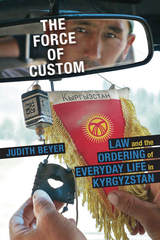 The Force of Custom: Law and the Ordering of Everyday Life in Kyrgyzstan
Judith Beyer
University of Pittsburgh Press, 2016 The Force of Custom presents a finely textured ethnographic study that sheds new light on the legal and moral ordering of everyday life in northwestern Kyrgyzstan. Through her extensive fieldwork and firsthand experience, Judith Beyer reveals how Kyrgyz in Talas province negotiate proper behavior and regulate disputes by invoking custom, known to the locals as salt. While salt is presented as age-old tradition, its invocation is shown to be a highly developed and flexible rhetorical strategy that people adapt in order to meet the challenges of contemporary political, legal, economic, and religious environments. Officially, codified state law should take precedence when it comes to dispute resolution, yet the unwritten laws of salt and the increasing importance of Islamic law provide the standards for ordering everyday life. As Beyer further demonstrates, interpretations of both Islamic and state law are also intrinsically linked to salt.
By interweaving case studies on kinship, legal negotiations, festive events, mourning rituals, and political and business dealings, Beyer shows how salt is the binding element in rural Kyrgyz social life and how it is used to explain and negotiate moral behavior and to postulate communal identity. In this way, salt provides a time-tested, sustainable source of authentication that defies changes in government and the shifting tides of religious movements.
The Force of Fantasy: Restoring the American Dream
Ernest G. Borman
Southern Illinois University Press, 2000 In this book, first published in 1985, Ernest G. Bormann explores mass persuasion in America from 1620 to 1860, examining closely four rhetorical communities: the revivals of 1739–1740, the hot gospel of the postrevolutionary period, the evangelical revival and reform of the 1830s, and the Free Soil and Republican parties. Each community varies greatly, but Bormann asserts that each succeeding community shares a rhetorical vision of restoring the “American Dream” that is essentially a modification of the previous visions. Thus, they form a family of rhetorical visions that constitutes a rhetorical tradition of importance in nineteenth-century American popular culture.
 The Force of Law
Frederick Schauer
Harvard University Press, 2014 Many legal theorists maintain that laws are effective because we internalize them, obeying even when not compelled to do so. In a comprehensive reassessment of the role of force in law, Frederick Schauer disagrees, demonstrating that coercion, more than internalized thinking and behaving, distinguishes law from society’s other rules.
Reinvigorating ideas from Jeremy Bentham and John Austin, and drawing on empirical research as well as philosophical analysis, Schauer presents an account of legal compliance based on sanction and compulsion, showing that law’s effectiveness depends fundamentally on its coercive potential. Law, in short, is about telling people what to do and threatening them with bad consequences if they fail to comply. Although people may sometimes obey the law out of deference to legal authority rather than fear of sanctions, Schauer challenges the assumption that legal coercion is marginal in society. Force is more pervasive than the state’s efforts to control a minority of disobedient citizens. When people believe that what they should do differs from what the law commands, compliance is less common than assumed, and the necessity of coercion becomes apparent.
Challenging prevailing modes of jurisprudential inquiry, Schauer makes clear that the question of legal force has sociological, psychological, political, and economic dimensions that transcend purely conceptual concerns. Grappling with the legal system’s dependence on force helps us understand what law is, how it operates, and how it helps organize society.
|
|
